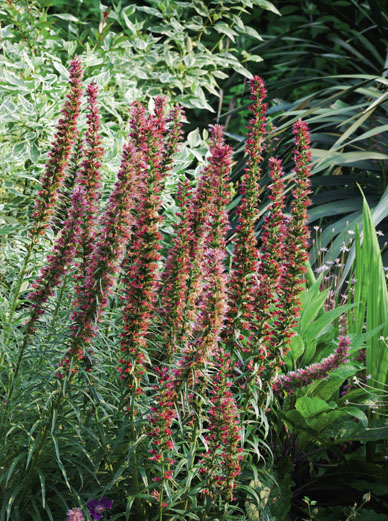
Echium russicum
Boraginaceae
viper’s bugloss
Despite the name, this genus of plants has nothing in common with poisonous snakes other than the old folk tale that one species, Echium vulgare, could serve as an antidote for a viper’s bite. In fact, the members of this genus offer attractive foliage and vivid, funnel-shaped flowers often borne in spire-like panicles or spikes. Select specimens for the American garden carefully, however, as all these plants are of exotic origin (commonly from the Canary Islands) and several species have proven notably invasive when moved into new habitats. Washington and Tennessee both include E. vulgare on their official lists of invasive exotic pest plants, and E. plantagineum has become popularly known in Australia as “Patterson’s Curse,” in honor of the woman who supposedly introduced it into that continent.
The species listed below, however, are all non-invasive and tremendously attractive. The species from the Canary Islands are naturally adapted to prolonged seasonal droughts and are good material for xeriscapes in the southwestern United States. Others perform well in more temperate climates. As a group, they are magnets for hummingbirds, bees, and butterflies, and are deer resistant. They require full sun and a well-drained soil, but are generally hardy, low-maintenance plants. Many species are bristly, and contact can cause skin irritation.
Propagate by seed in summer, by stem cuttings taken in spring, or by layering.
Echium amoenum
• purple, red
• midspring to early fall
• 10–16 in. × 6–8 in.
• sun, part shade
• Z4–10
Red feathers. Northern Iran and the Caucasus Mountains. Forms a low mound of narrow, dark green, leathery leaves, above which a 16-in. spike bristling with tubular, purple flowers rises in spring. Deadheading prolongs bloom into fall; leave a few flowers to self-seed.
‘Red Feathers’ has rusty-red flowers.
Echium candicans
• purple
• late spring to midsummer
• 6–8 ft. × 4–6 ft.
• sun
• Z9–10
Pride of Madeira. This Canary Island native forms a broad rosette of hairy, gray-green, evergreen leaves the first year; soaring, upward-curving branches sprout the second and succeeding springs. Branches are shrouded with lanceolate leaves and topped with stunning 12-in.-long spikes of blue-purple flowers. Excellent for coastal and seaside gardens, or a bold backing for lavender, rosemary, sages, and other silvery herbs. Flourishes on free-draining, dry, poor soils; cut back hard with the onset of winter.
Echium lusitanicum
• blue-purple
• spring to early summer
• 3 ft. × 1.5–2.5 ft.
• sun
• Z7–10
Violet-vein viper’s bugloss. Southern Spain. Available in the trade as Echium lusitanicum subsp. polycaulon. One of the showiest and cold-hardiest echiums. Short lived but reseeds prolifically; bears multiple 3-ft.-tall spires of shimmering blue-purple flowers veined with violet. Outstanding as a cut flower.
Echium russicum
• red-purple
• late spring to midsummer
• 18–24 in. × 15–18 in.
• sun
• Z5–8
Russian bugloss. Russian native with basal rosettes of silvery, hirsute, lanceolate leaves, from which rise throngs of upright spikes with purple to reddish flowers. Officially classified as a biennial but perennial in most gardens on well-drained soils. A grassland species that performs well in meadow plantings.

Echium russicum
Papaveraceae
snow poppy
Sometimes known as Chinese bloodroot, this charming bloodroot relative also has bright orange sap. It is useful in shaded gardens as a groundcover, but should not be introduced into formal beds and borders due to its wandering ways. Slender rhizomes spread far and wide and are brittle, making them difficult to remove if the plant gets out of hand. Grayish green leaves are arrow or heart shaped with wavy edges, to 4 in. wide on long petioles. The leaf surface is sometimes dimpled between the veins. By fall the foliage is yellow and scruffy, so interplant among ferns, hostas, coral bells, and other handsome foliage plants.
Seldom attacked by pests or diseases and ignored by deer and rabbits.
Divide or take root cuttings in spring.
Eomecon chionantha
• white
• late spring to midsummer
• 12–15 in. × 24 in.
• part shade, shade
• Z6–9
Snow poppy, Chinese bloodroot, dawn poppy. Eastern China. Snow poppies thrive in woodland or partly shaded places where soils remain moist. Vigorous growers that spread freely, they produce erect, branching, pink stems that in late spring bear pristine, 2-in. blossoms with four fluttery, white petals and a central boss of yellow stamens in late spring. Flowering at the same time as Virginia bluebells and forget-me-nots, snow poppies are also stunning when partnered with Spanish bluebells in woodland settings, but don’t expect to keep them within bounds if the soil is good.
Onagraceae
willowherb, fireweed
Recent revisions to botanical nomenclature have transformed the genus Epilobium from a horticultural footnote to a real player. Formerly, the only epilobium of interest to gardeners was E. angustifolium, the northern wildflower “fireweed,” whose wind-born seeds colonize burnt-over and bombed-out sites. But in the last decade, the genus Zauschneria, the “California fuchsias,” were reclassified as epilobiums, endowing this genus with a host of genuine garden stars.
Epilobiums new and old are similar in their tolerance for poor, sandy soils, and their spreading rhizomes, two features that make them effective groundcovers.
California fuchsias are typically pest and disease free; fireweed is susceptible to black vine weevils, which also afflict rhododendrons, and the appearance of notches in the margins of fireweed leaves is a warning to protect the shrubbery.
Propagate by seed or divide mature plants. Take stem cuttings of named clones of California fuchsias in fall.
Epilobium angustifolium
• syn. Chamerion angustifolium
• pink
• early summer to early fall
• 2–6 ft. × 2 ft.
• sun, part shade
• Z2–8
Fireweed, rosebay willowherb. Northern parts of the Northern Hemisphere, including North America. Fireweed’s aggressively spreading rhizomes and prolific self-seeding require restraint in the garden. Slender, lanceolate leaves, up to 8 in. long, are borne spirally around reddish, upright stems; the tubular, pink to magenta, four-petaled flowers may reach 1 in. in diameter, and gather in tapering spikes at the stem tips. Bloom span is a month or so, but routine deadheading extends flowering and reduces self-seeding. Tolerates most soils as long as they remain moist. Attractive at the back of a border, but better suited to informal wet meadows and wildflower plantings due to its aggressive roots. Attractive to butterflies, bees, and hummingbirds.
‘Album’ has white flowers; not quite as aggressive.
Epilobium canum
• syn. Zauschneria spp.
• red
• late summer to early fall
• 1–3 ft. × 4–5 ft.
• sun, part shade
• Z8–10
California fuchsia. Baja California to Oregon, eastward into New Mexico and Wyoming, a shrubby, commonly multi-branched, spreading or upright perennial with green or grayish, hairy, lanceolate to oblong, 1.5-in. leaves; evergreen in mild-winter regions. Brilliant red, trumpet-shaped, four-petaled flowers borne near branch ends, with all flowers usually oriented in the same direction. The bloom is especially impressive because it comes toward the end of California’s dry season (late spring to early fall), when the prevailing landscape coloration is brown. Its nectar is an important food source for native bees and hummingbirds. Requires a well-drained soil; drought tolerant, ideal for xeriscapes or for covering a sunny bank. Combine with other coastal sage-scrub natives, icluding lemonade berry (Rhus integrifolia) and coffeeberry (Rhamnus californica). Susceptible to leaf hoppers and root mealybugs.
subsp. canum (Zauschneria californica) has orange-red to scarlet trumpets above gray or silvery, lanceolate foliage. 24 in.
‘Catalina’ has silver, broader leaves, and an upright habit; its orange-red blossoms bloom a little later and for a longer season.
‘Dublin’ has bright red flowers. 12–18 in.
subsp. garrettii (Zauschneria latifolia var. garretti) has reddish flowers. 7–8 in.
subsp. latifolium (Zauschneria latifolia) bears spreading grayish, lanceolate leaves and reddish flowers.
‘Orange Carpet’ is prostrate with orange flowers. 4–6 in. Z4–8.
Berberidaceae
bishop’s hat, barrenwort
A large genus of hardy, shade-tolerant perennials, epimediums have long been a go-to groundcover for woodland gardens; although they prefer a moist, humus-rich soil, they are among the select group of plants that succeeds in the dry shade found under shallow-rooted trees. The introduction of new species from China in recent years and new hybrids has broadened the color palette of both flowers and foliage, and many of the new types also display their blossoms more visibly, holding them higher above the foliage than older garden epimediums did.
The leaves, evergreen, semi-evergreen, or deciduous, are divided into heart-shaped, rounded, or even triangular leaflets that range in size from 0.5–6 in. long. The cup-shaped flowers are four-parted, often with petals that extend into long spurs that can lend the blossoms the look of an inverted crown (hence the common name bishop’s hat).
Although persistent once established, bishop’s hats are not aggressive; they form dense clumps that spread slowly by means of underground rhizomes. They make elegant edging plants and provide an effective counterpoint to other shade-tolerant foliage plants: lungworts (Pulmonaria), hardy gingers (Asarum), ferns, and sedges. Resistant to deer and rabbits, they are generally pest and disease free, though sloppy propagation in the nursery sometimes results in viral infections; plants whose leaves exhibit mosaic patterns of yellow should be discarded.
Propagate by division, in early spring or early fall for deciduous types, and in fall for evergreen ones, or by seed sown in late summer.
Epimedium alpinum
• red-and-yellow
• early spring to midspring
• 6–9 in. × 9–12 in.
• part shade, shade
• Z4–8
Bishop’s hat. Southern Europe. This species spreads more rapidly than others. Foliage is deciduous to semi-evergreen (in mild climates); the heart-shaped leaflets have a pink tinge when they emerge in spring, maturing to a medium green and turning deep reddish bronze in fall. Flowers with yellow petals shrouded by red sepals are borne in racemes of 12 to 20.
Epimedium epsteinii
• white-and-purple
• midspring to early summer
• 12 in. × 18 in.
• part shade, shade
• Z5–8
Fairy wings. This recent discovery from China is an excellent evergreen groundcover that spreads 6–8 in. annually. Glossy dark-green leaflets; 10 to 30 flowers per stem, with white inner sepals and plum-purple spurs. Named for the late Harold Epstein.
Epimedium grandiflorum
syn. E. macranthum
• pink, purple, white, yellow
• midspring to late spring
• 12–18 in. × 9–18 in.
• part shade, shade
• Z5–8
Longspur barrenwort, horny goatweed. Native to China, Korea, and Japan. The dramatic long spurs formed by the petals of this flower are the inspiration for one common name; the other refers to a belief in Asian countries of this species’ potency as an aphrodisiac. The deciduous, angel-wing leaflets are toothed along the margins, and are a red-tinged beige when young, maturing to light green and turning red in fall. There are numerous cultivars.
‘Cranberry Sparkle’ has young chocolate leaves and cranberry-red flowers.
‘Lilafee’ (Lilac Fairy) has bronze-mottled foliage and lavender-purple flowers
‘Pierre’s Purple’ (Pierre’s Purple Fairy Wings) bears wine-purple flowers.
‘Red Queen’ has carmine-red flowers.
‘Tama-no-gempei’ has white petals inset into purple outer sepals.
Epimedium pinnatum
• red, white, pink, yellow
• mid- to late spring
• 8–10 in. × 15 in.
• part shade, shade
• Z5–8
Persian epimedium, barrenwort. Japan. Spiny-edged evergreen or deciduous leaves are excellent as a slow-growing groundcover in woodlands and beneath shrubs. Bronzy pink when young, the leaves mature to green then turn bronze by fall. Airy spikes of long-lasting flowers dance above the foliage. Drought tolerant. Cut back in very early spring.
subsp. colchicum ‘Thunderbolt’ bears foliage that slowly darkens in midautumn from deep green to blackish purple beneath a pattern of green veins. Z5–8.
Other Notable Cultivars
×cantabrigiense is evergreen and clump forming. Long-stalked leaves of up to 17 in number have lovely fall color. Spurless, two-toned, coppery pink-and-yellow flowers held above the leaves.
×perralchicum ‘Frohnleiten’ is evergreen, 6–10 in., and spreads 6–8 in. annually. Elongated, spiny spring foliage, mottled rose-red, with bright green veins. Large, showy flowers: yellow inner sepals surround tiny, gold-and-red petals. Z5–8.
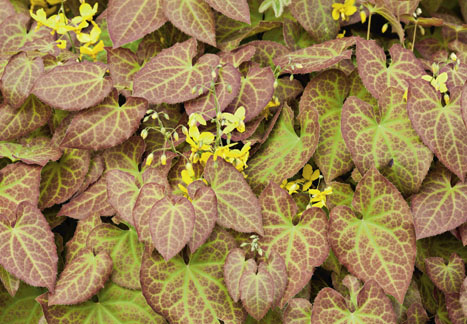
Epimedium ×perralchicum ‘Frohnleiten
×versicolor ‘Versicolor’ is deciduous; emerging foliage is deep rose-red with green veins; matures green, then dark brownish purple in fall. Flowers are rich salmon-pink with red-flushed spurs. Z4–8. ‘Cupreum’ has coppery flowers; ‘Sulfureum’ has deep yellow flowers.
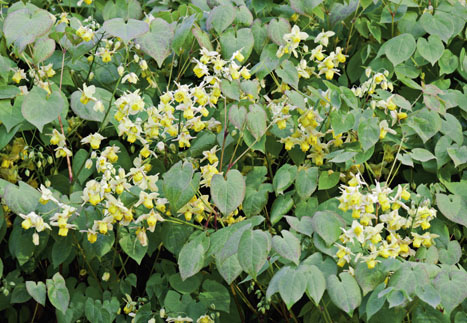
Epimedium ×versicolor ‘Sulphureum’
×youngianum is a deciduous clump former. Each stem has two to nine wavy-edged leaflets. White or pink, 0.5-in. flowers. ‘Niveum’ is white flowered; ‘Roseum’ (‘Lilacinum’) has grayish pink flowers.
Orchidaceae
helleborine
Don’t let the common name confuse you: these plants have nothing to do with hellebores, but instead are terrestrial orchids that bear classically orchid-type, if modest-sized, flowers. They adapt well to waterside gardens along streams and ponds, and are especially appropriate for wet, but not boggy, wild gardens. Short, creeping rhizomes should be divided when they get overcrowded. Lance-shaped leaves conspicuously ribbed or pleated; erect, leafy stems terminate in loose racemes of flowers, among leafy bracts.
For best results provide a humus-rich, damp soil that does not dry out. A lightly sunny or partly shaded position is ideal; especially protect from hot sun. Some species seed themselves if they are happy, but others increase by their spreading rhizomes. Never dig from the wild; be sure to procure plants from reputable dealers who do not rape the landscape. Protect plants from slugs and snails. Deer resistant.
The species described below is a North American native. Epipactis helleborine from Europe is also worth seeking. Easier to grow than our natives, it bears dramatic spikes of up to 50 greenish flowers flushed with purple. Self-seeds to form large colonies. Watch for hybrids.
Increase by division of the rhizomatous roots.
Epipactis gigantea
• green
• summer
• 2–5 ft. × 2 ft.
• sun, part shade
• Z4–8
Giant helleborine, chatterbox, stream orchid. Western Canada to New Mexico, growing in wet places beside streams, springs, and meadows. Large (for an Epipactis), 0.75- to 1-in. flowers of yellowish green, veined and flushed with purple, and fragrant. Perhaps 10 to 15 of these will appear on the upper part of the flower stems among leafy bracts. The lower lip and “tongue” of the flowers move, as if chattering when the flower is touched or shaken—hence the common name chatterbox. Rhizomes sprout smooth stems with alternate, pleated, lance-shaped leaves, 2–8 in. long. Prefers alkaline soil. An attractive and vigorous grower that develops into large patches; winter dormant. Charming with maidenhair and other delicate ferns.
‘Serpentine Night’ has purple-black leaves. Its typical orchid flowers are yellow, marked with red at the throat. 12–18 in. Z6.
Asphodelaceae
foxtail lily, desert candle, king’s spear
Looking for a dramatic vertical focal point for your flowerbeds and borders? Foxtail lilies never fail to attract comment with their imposing, statuesque habit and bold bloom. The flower stems rise naked from octopus-like roots to bear at their tips dense, long, “bottle-brush” racemes of starry flowers, with prominent exserted stamens. Flowers open in succession from the bottom upward, ensuring a long bloom time; they serve as butterfly attractors and are excellent when cut. Arranged in a basal rosette, the thick leaves are broadly strappy and often become shabby, even during flowering, and retreat underground in summer; camouflage with attractive foliage of companion plants (bronze fennel works well) or plan to overplant with shallow-rooted annuals. Apply a winter mulch of leaves, compost, or straw after the ground freezes in fall to insulate from winter thaws and refreezes. Deep, rich, well-drained soil is essential for good results. It is best to plant the tubers in fall, 2–3 in. deep on a hillock or cone of soil (sand in heavy soil) with the pointed crown pointing up and the “fingers” spreading out and down 2–3 in. If the roots appear dried up upon receipt, soak them for a few hours before planting.
Foxtail lilies are ideal companions for flowering shrubs and show up well against a background of evergreens. Plant in groups between shrubby St. John’s worts, hydrangeas, spireas, potentillas, or dwarf evergreens. They are also spectacular against a hedge or at the back of flowerbeds and borders, perhaps behind the bluish leaved false indigo (Baptisia), or silvery Artemisia ‘Powis Castle’. Reports differ as to the deer resistance of foxtail lilies; protect from slugs that attack the new growth.
Once established, do not disturb the brittle roots, except to divide the crowns in spring or fall carefully every few years to reinvigorate the plants and increase stock. Stratify seed before sowing; seedlings may require six years to reach blooming size.
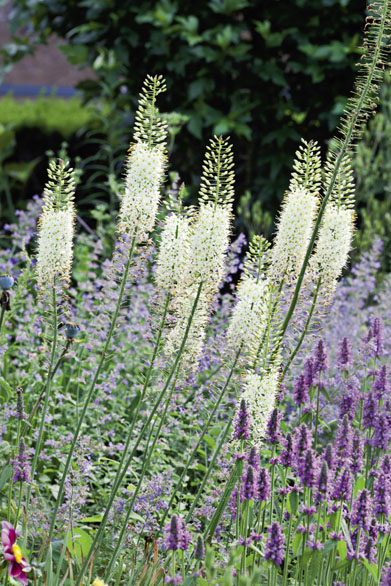
Eremurus ‘White Beauty’ partners well with Stachys officinalis
Eremurus himalaicus
• white
• late spring to early summer
• 3–8 ft. × 3 ft.
• sun
• Z3–8
Foxtail lily, Himalayan foxtail lily. Temperate regions of the Himalayas and Afghanistan. Probably the hardiest species of Eremurus. Grayish green foliage to 2 ft. long, and white, 1-in. flowers clustered into tapering flower spikes up to 4 in. wide and 2 ft. or more long. Plant in a wind-protected spot, in front of a dark-colored solid fence, hedge, or other sheltering background; support in windy sites.
Eremurus ×isabellinus
syn. E. olgae × E. stenophyllus
• white, yellow, pink, red
• early summer
• 6 ft. × 2 ft.
• sun
• Z5–8
This catch-all group includes many of the most sought-after and elegant flowers. Soaring above their green, 6- to 12-in.-long leaves, tall, naked stems carry 6- to 18-in.-long racemes of starry, 1-in. flowers in various colors.
‘Cleopatra’ has orange flowers striped with red. 4–5 ft. tall
‘Isobel’ is rosy pink flushed with orange. 5–6 ft.
‘Pinocchio’ has bright yellow flowers. 3–6 ft.
‘Romance’ has pale pink flowers with yellow stamens. 3–4 ft.
‘White Beauty’ is pure white. 4–5 ft. tall.
Eremurus robustus
• pink
• early summer
• 6–9 ft. × 3 ft.
• sun
• Z6–9
Foxtail lily, giant desert candle. Rocky alkaline hillsides of Turkestan. This huge plant demands plenty of room and commands attention wherever it is grown. Smooth gray-green foliage is about 2 in. wide and up to 4 ft. in length. Columnar, 2- to 3-ft. racemes composed of countless fragrant, 1.5-in., peachy pink flowers with orange stamens, top ramrod-like scapes in early to midsummer. Attractive to honey bees seeking pollen. Requires a cold period in winter to induce blooming. Attractive companions include hardy geraniums, euphorbias, and species roses.
Eremurus stenophyllus
syn. E. bungei
• yellow
• late spring to early summer
• 3–6 ft. × 3 ft.
• sun
• Z5–8
Foxtail lily. Central Asia, Iran. Tufted with grayish green, sometimes hairy leaves, to 10 in. Deep yellow, 0.75-in. flowers in dense racemes atop tall stems.
Asteraceae
fleabane
These unfortunately named perennials are easy to grow, tolerant of most soils and sites, good for cutting, and (reputedly) repel fleas. Furthermore, they are long blooming, bearing charming aster-like flowers, each with two or more rows of ray flowers surrounding yellow disk florets.
Found throughout the temperate zone, this genus includes many North American natives. Several, such as Erigeron philadelphus and E. canadensis, are considered weeds, although the former is sometimes included in wild, native, or meadow gardens. The showiest fleabanes are mostly hybrids with parentage that often includes orange fleabane, E. aurantiacus, and daisy or showy fleabane, E. speciosus. Though aster lookalikes, fleabanes mostly bloom prior to the aster season in spring and summer. Flowerheads may be single or semi-double, and either solitary or clustered in flat-topped inflorescences. Basal leaves are petioled, but the stem leaves are alternate and often clasping.
Well-drained soil is a must, and once established, plants tolerate dry soils well. Taller selections—which may require staking—make fine cut flowers; harvest when the flowers are fully open. Only occasionally browsed by deer, more often by rabbits.
Divide in spring or start from seed for bloom the following season.
Erigeron aurantiacus
• orange
• summer to late summer
• 12 in. high and wide
• sun
• Z4–8
Orange fleabane. Turkestan native. Basal rosettes of spatulate, softly downy, 3- to 4-in. leaves; stem leaves clasp the stem. Flowerheads are 1–2 in. across, bright orange with green disks, and borne singly atop slender, upright stems. Short lived, but easy to start from seed in spring; early seedings usually bloom the first season.
• mauve
• spring to summer
• 10–12 in. × 12 in.
• sun
• Z3–9
Seaside daisy, beach fleabane, beach aster. Ocean bluffs and ravines in coastal California and Oregon. Evergreen, gray-green leaves are glaucous, spoon-shaped, and blunt at the tips, to 6 in. long, sometimes rimmed with teeth. Slender-rayed, semi-double flowerheads bloom for several weeks. Excellent in free-draining sandy soils in cottage and rock gardens, as edging plants, between pavers, atop stone walls, and in containers. Salt tolerant; an important plant in seaside gardens. Attracts insects and butterflies. Deadhead to extend bloom time and cut back hard every couple of years to maintain vigor. Provide light midday shade and extra water in inland gardens.
‘Bountiful’ has very long-blooming, 3-in., lavender flowerheads. A compact seedling from ‘Arthur Menzies’. 6–10 in.
‘Cape Sebastian’ has whitish foliage and violet flowerheads. 12 in.
‘Roger Raiche’ is upright with purple flowers. Long bloom time. To 18 in.
‘Sea Breeze’ produces 1.5-in.-wide, pinky-mauve blooms in abundance in midspring and continues through summer if deadheaded routinely. 8–12 in. Z7.
Erigeron karvinskianus
• white, pink
• spring to fall
• 6–24 in. × 36–60 in.
• sun
• Z7–11
Mexican daisy, bonytip fleabane, Santa Barbara daisy. Mexico to Venezuela. Excellent as a trailing groundcover, Mexican daisy is covered with small white or pink-flushed daisies all summer. Prefers sandy, free-draining soil and full, but not intense, sun. Blooms the first season if seed sown in early spring, and self-seeds abundantly. Can become invasive and is difficult to eradicate. Delightful tumbling over rocks and walls, and in containers. Tough but charming pink Santa Barbara daisy, Erigeron ×moerheimii, is very similar but sterile, and more compact. Both are great attractors of beneficial insects.
‘Profusion’ bears white flowers that fade to pink. Spreads freely. 6–8 in.
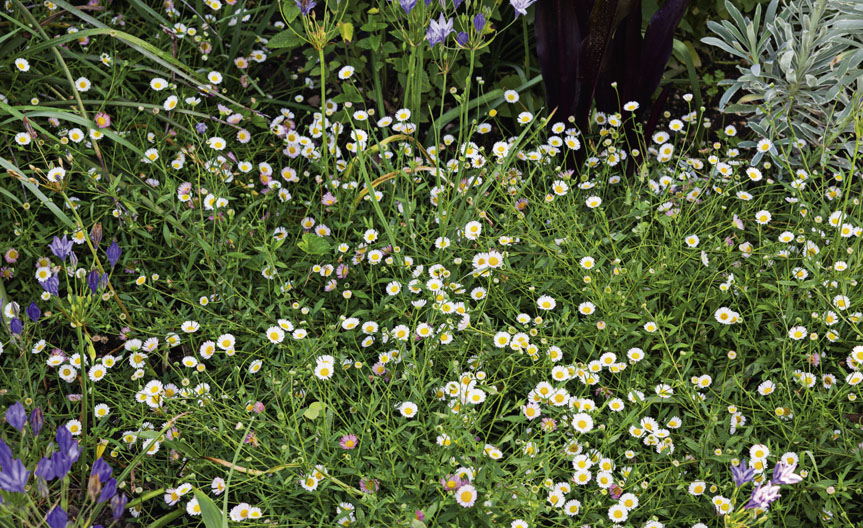
Erigeron karvinskianus
Erigeron speciosus
• lilac
• summer
• 12–30 in. × 24 in.
• sun, part shade
• Z2–7
Daisy fleabane, showy fleabane, Oregon fleabane, Aspen fleabane. Western United States. From woody rootstocks rise multiple stems clothed with clasping leaves and branching at the top. Each branch is topped with narrow-rayed but showy 2-in.-wide flowerheads. Tall selections may require staking. Best in temperate climates where summers are cool. Cut back after blooms are spent to encourage rebloom and help the new basal growth overwinter successfully. Seldom cultivated outside of native plant gardens. One of the dominant parents of the showy hybrid group (Erigeron ×hybridus), along with E. alpinus, E. aurantiacus, E. speciosus var. macranthus, and sometimes E. glaucus.
Other Notable Cultivars
Erigeron hybrids were formerly more popular in American gardens than they are today, especially the series bred by famed British plantsman Alan Bloom. These and others are still offered by mail from British nurseries. The following are available in the United States as of this writing.
‘Darkest of All’ is one of the best and most popular selections with deep violet flowers. 24 in.
‘Pink Jewel’ produces masses of semi-double, 1.5-in., orchid-pink flowers. Excellent cut flower. 24 in. Z4.
‘Prosperity’ is getting more difficult to find in the marketplace, but is well worth growing for its large, semi-double, lavender-blue daisies on 18-in. stems. Good cut flower.
‘Rotes Meer’ (‘Red Sea’) has several layers of shocking pink ray flowers encircling a yellow center.
Asteraceae
golden yarrow, woolly sunflower
Only one or two members of this native Western genus of 12 species are cultivated outside of native plant and wild gardens, but it seems there is always room in the garden for another yellow daisy, especially in regions of their nativity. The genus name is derived from the Greek erio, meaning wool, and phyllum, meaning leaves.
These attractive silver-gray plants are effective in sunny beds and borders where soil drains freely or is even dry. Partner them with plants such as penstemons, sages, and agastaches.
Propagate by seed or division of the roots.
Eriophyllum lanatum
syn. E. caespitosum, Actinella lanata
• yellow
• spring to midsummer
• 12–24 in. × 12 in.
• sun
• Z5–10
Woolly sunflower, golden yarrow, Oregon sunshine. Dry open spaces and rocky slopes of the western United States as far north as Vancouver, BC. Clumping with branched stems that become covered with solitary, 1- to 2-in., yellow daisies centered with yellow disks. The stems may flop to form large mats. Lower leaves are pinnately lobed, those above mostly linear. These white plants protect themselves from intense sun and drought with a dense coat of light-reflecting and transpiration-reducing white hairs. The sunny flowerheads attract many different insects and are a nectar source for several species of butterflies and songbirds. Tolerates drought well; suitable for dry borders and xeriscapes.
var. grandiflorum is very similar and possibly a hybrid with other species.
Geraniaceae
heronsbill, filaree
Most often confined to the rock garden, the genus Erodium also includes several excellent low-growing species suitable for lining garden paths or for the front of the border, and for inserting between pavers and stepping stones. Heronsbill’s attractive and durable foliage is often divided or even dissected; the small, saucer-shaped, five-petaled flowers are arranged in loose umbels. The beak-like fruits that follow the flowers add interest as they split by twisting into tight spirals to release their seeds. Of limited application but outstanding in rock gardens or troughs and worth seeking is the so-called alpine geranium, E. reichardii.
Heronsbills do best in full sun or very light shade where the soil is sandy or gritty and drains freely. Apply gravel or lime chips as a mulch to assist rainwater runoff and keep the surface dry. Protect plants from intense noon and afternoon sun. Pests and diseases are seldom serious, and deer tend to avoid erodiums.
To propagate, take cuttings in early summer or divide plants in spring. Otherwise, sow seed in spring or in late summer as soon as they ripen.
Erodium absinthoides
syn. E. olympicum
• pink
• summer
• 8 in. × 24 in.
• sun, part shade
• Z7–10
Heronsbill, storkbill. Southern Europe, Macedonia. Forms a sprawling mound of feathery, hairy, silver-gray leaves that are cut into slender segments. Flowers are violet, pink, or white traced with darker veins, and measure 0.75 in. in diameter. Very variable.
Erodium carvifolium
• pink
• early summer to early fall
• 10–18 in. × 14 in.
• sun, part shade
• Z6–10
Heronsbill, storkbill. Spain. Pink to magenta, 0.5-in. flowers, upper petals blotched with deep red. Long, lacy, green leaves develop into low-growing rosettes of foliage. Plant this long-blooming plant in beds and borders.
Erodium reichardii
syn. E. chamaedryoides
• pink
• late spring to early fall
• 4–6 in. × 12 in.
• sun, part shade
• Z6–10
Alpine geranium, baby Swiss geranium. Corsica, Majorca. Forms low-growing mounds of soft, grayish, heart-shaped leaves that are scalloped along the edges. Flowers are whitish pink, to 2 in. across, etched with rose-pink veins. Protect from intense afternoon sun. Free-draining, sandy soil is ideal. This species is drought tolerant, but winter wet is sure to kill it. Charming in trough gardens or planted with low sedums, sempervivums, and creeping thymes in rock gardens.
Bishop’s Form (syn. Erodium chamaedryoides ‘Bishop’s Form’) has mid-pink, 0.5-in. flowers with purplish veins. 2 in. tall, but may be 10 in. across. Z8–10.
‘Charm’ has lavender-pink flowers, traced with hot-pink veins. Z7–9.
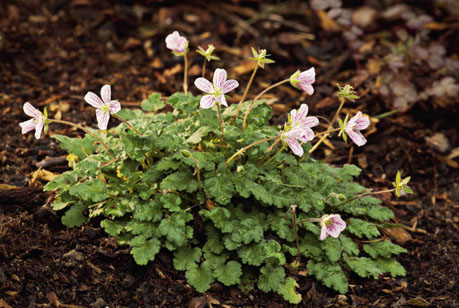
Erodium reichardii ‘Charm’
‘Flore Pleno’ has double, pink or white blooms. Z8–9.
‘Roseum’ has darker pink flowers with crimson veins.
Apiaceae
sea holly
Although popular among European gardeners, the eryngiums remain largely unknown on this side of the Atlantic. Surely it is its spiny, unfriendly aspect that has prevented this striking genus from winning the place in our gardens that it deserves. Yet the same feature that makes these plants uncomfortable to handle, the spines that armor not only leaves but also the floral bracts and petals, also make them invaluable sources of texture and contrast; nothing else so emphasizes the softness or tactile qualities of other foliages than does a strategically placed sea holly.
Eryngiums flourish in dry, well-drained, and sunny spots, making them excellent specimens for xeriscapes, or where water supply is short. Steely blue foliage makes sea hollies natural companions for blue-flowered herbs such as Russian sages (Perovskia) and lavenders; they also harmonize well with taller yellows such as yellow foxgloves (Digitalis grandiflora) and hollyhocks (preferably some single-flowered cultivar such as ‘Sunshine’). Sea hollies are sophisticated and stylish as cut flowers and dry well for winter arrangements. Deer and rabbit resistant.
The deep-reaching taproots of eryngiums do not respond well to transplanting or division. Do not disturb once a plant is well established. Propagation is by seed as soon as it ripens (start in containers) or by root cuttings taken in fall. Root cuttings may be taken from pencil-thick roots in winter.
Eryngium alpinum
• blue
• early summer to late summer
• 1–2.5 ft. × 1–2.5 ft.
• sun
• Z2–8
Eryngo, alpine sea holly. Alps and mountainous parts of southern Europe. Thrives in average to poor, dry to moderately moist soils as long as they are well drained. Tolerates light shade, drought, and saline conditions—a good choice for seaside gardens. Thistle-like in appearance, with stiff stems clothed with gray-green to bluish, heart-shaped, spiny lower leaves, and palmately divided upper ones. Flowerheads are egg shaped, to 2 in. long, and framed by a collar of sharp, finely divided, blue-gray bracts. No serious insect pests or diseases, but won’t tolerate wet soils in winter.
‘Blue Star’ has blue stems and foliage, and metallic blue flowerheads.
‘Superbum’ has three tiers of bracts around the base of each flowerhead, lending the blossoms a lacy look.
Eryngium amethystinum
• blue
• mid- to late summer
• 18–30 in. × 24 in.
• sun
• Z2–8
Amethyst sea holly. Balkans, Italy, Sicily. Basal rosettes of grayish, deeply cut leaves that are attractively speckled and veined with silver. Branching stems, gray-blue above, carry metallic-blue, thistle-like flowers surrounded by up-curving, long, silver bracts, armed with stiff spines. Prefers dry, poor to moderately fertile soil that drains freely.
The cold-hardiest species of the genus.
‘Sapphire Blue’ has steely blue flowers, foliage, and stems. Z5–9.
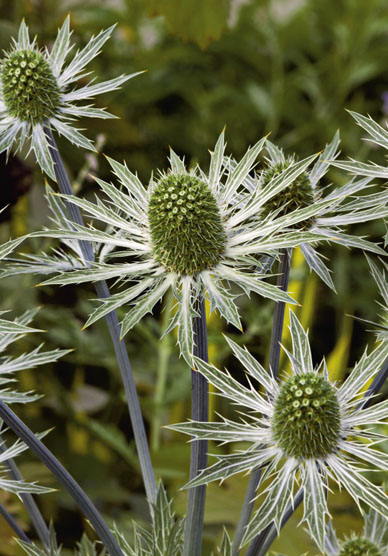
Eryngium amethystinum ‘Sapphire Blue’
Eryngium bourgatii
• blue
• early summer to late summer
• 1–2 ft. high and wide
• sun
• Z5–8
Eryngo. Pyrenees. Has deeply lobed, silver-veined leaves, and vivid blue, branched stems. These bear conical, silver-blue or violet flowerheads set on collars of narrow, spiny bracts. Tolerates dry and poor soils; requires good drainage, especially in winter. No serious pests or diseases.
Eryngium maritimum
• blue
• midsummer to late summer
• 8–24 in. × 12 in.
• sun
• Z5–11
Sea holly. European native of coastal areas and sand dunes. Borne on tall stems, the evergreen foliage is showy: leathery, glaucous, and blue-gray in color, the ovate, three-lobed leaves have spiny teeth. Collars of spiny bracts frame the 1-in., thimble-shaped, light blue flowerheads.
Eryngium pandanifolium
• green
• summer
• 4–6 ft. × 2–4 ft.
• sun, part shade
• Z7–10
Pandanus leaf eryngium. Argentina and Brazil. Forms clumps of blue-gray, strap-like, sawtooth-edged, screwpine-like leaves. Tall stalks emerge from the middle bearing branched clusters of gray-green thimble flowerheads.
Eryngium planum
• blue
• early summer to late summer
• 2–3 ft. × 1–2 ft.
• sun
• Z5–9
Sea holly, flat sea holly. Central and southeastern Europe. Flourishes in dry, sandy soils; avoid overwatering and overly fertile soils that cause rank, lax growth. Basal rosettes of deeply toothed, oblong, blue-green leaves, to 4 in. long, from which sprout stiff, 3-ft. flower stems. These bear pale blue, round flowerheads collared with projecting spiny bracts. Generally pest free, but subject to leaf spot.
‘Blue Glitter’ commonly blooms in its first year from seed. Large, intensely blue flowerheads on silver-blue stems.
‘Blue Hobbit’ is dwarf, with flowerheads completely covering the foliage at the peak of its season. 8–12 in.
‘Jade Frost’ has blue leaves edged with cream, and blue flowers.
‘Silver Salentino’ has silvery-white cones sparsely ruffed with silver bracts. 2.5–3 ft. Z4.
• greenish white
• early to late summer
• 4–5 ft. × 2–3 ft.
• sun
• Z3–8
Rattlesnake master. Meadows and prairies, eastern half of the United States. Tussocks of lanceolate, 2.5 ft. × 2 in., grayish green leaves edged with spines—as the species name suggests, the foliage does resemble that of yucca. Flowerheads on stiff, upright stems that emerge from the center of the foliage rosettes; greenish white, globular heads to 1 in. across have sparse collars of long, sharp bracts at the apex of the central stem, and sometimes from the upper leaf axils. Prospers with dry to medium moisture on average soils; tolerant of clay, shallow, and rocky soils. Avoid very fertile soils that encourage soft, sprawling growth. No serious insect or disease problems. Staking may be necessary on windy sites. Equally at home in formal borders as in a meadow.
Brassicaceae
wallflower
Despite the name, wallflowers are guaranteed to attract admiration wherever you may plant them. Traditionally they have been used mostly as cool-season bedding plants and treated as annuals; Erysimum cheiri (formerly Cheiranthus cheiri) has been the standard choice for this purpose. A number of species, however, perform as perennials in hospitable sites, and others, while normally biennial, self-seed readily so that they function as perennials.
Most species originated in hot, sunny climates subject to seasonal drought, and so make good subjects for rock or gravel gardens, and thrive (as the common name suggests) when tucked into the crevices of wall, where they often self-sow. Wallflowers prefer alkaline soil, but tolerate most soils as long as they are well drained. Slugs and snails are often a problem; seldom troubled by deer. Mingles well with perennial herbs such as rosemary, thymes, and lavenders, whose foliages complement the Erysimum flowers. They are also a traditional element of cottage gardens. Several species, such as E. cheiri and E. ×marshallii, are toxic if ingested, and should not be accessible to children and pets.
Propagate by seed or by semi-hardwood cuttings of non-blooming stems taken in spring or summer.
Erysimum capitatum
syn. Cheiranthus capitatus
• orange, yellow
• midspring to early summer
• 1–2 ft. × 0.5–1 ft.
• sun, part shade
• Z3–7
Western wallflower, sand-dune wallflower. Western United States, as well as the upper South and Midwest. Produces evergreen basal rosettes of 3-in., linear to narrowly oblong leaves. In the second spring, upright stems, 1–2 ft. tall, emerge, each topped with a dense, rounded cluster of cruciform, four-petaled flowers, 0.75 in. across. Blooms are commonly some shade of yellow or orange, but may be maroon or near white. Flourishes in average soils with moderate to low moisture; tolerates shallow, rocky soils, and drought. Naturalizes where conditions hospitable.
Erysimum cheiri
syn. Cheiranthus cheiri
• red, orange, yellow
• midspring to early summer
• 18–24 in. × 15–18 in.
• sun, part shade
• Z5–9, HS
Aegean wallflower, Siberian wallflower, common wallflower. Southern Europe. This species is perennial in mild climates such as those found in the US Pacific Northwest. Does not tolerate southern heat with humidity. Prefers a moderately moist but well-drained soil with mildly alkaline pH—it often colonizes the cracks in the mortar of aging masonry walls. Forms rosettes of narrow, pointed leaves to 8 in. long in the first year’s growth. The second and succeeding years bring mace-like inflorescences of cruciform, four-petaled flowers borne in dense racemes on upright stems. Flowers fragrant, in shades of yellow, orange, red, mahogany, and purple. Start from seed.
Bedder Series are compact to 12 in. Individual colors of gold, primrose, orange and scarlet.
‘Blood Red’ has deep red flowers.
Charity Mix is compact, about 8 in., and blooms in its first year of growth, with 0.5-in., rose-red, scarlet, yellow, or creamy-yellow blossoms. Fragrant.
‘Harpur Crewe’ (syn. E. ×kewensis ‘Harpur Crewe’) is a double heirloom, with very fragrant, yellow flowers. 12 in.
Sunset Mix is an F1 hybrid strain in a wide range of colors. Very fragrant. 10–12 in.
Tom Thumb Mix is compact, ideal for furnishing window boxes and planters. Subtly scented blooms range from pale yellows to strong reds. 9 in. tall.
‘Wenlock Beauty’ has long racemes of bronze-flushed, yellow flowers. Evergreen. 18 in.
Erysimum linifolium
• pink, purple
• early spring to late summer
• 2–2.5 ft. × 1.5–2 ft.
• sun, part shade
• Z6–9
Alpine wallflower. Native to Spain and Portugal. Vigorous, shrubby, evergreen perennial with narrowly lanceolate, gray-green leaves. Cruciform, four-petaled flowers bloom in terminal racemes over a long season.
‘Bowles’ Mauve’ is probably a hybrid but is often assigned to Erysimum linifolium. It bears clusters of fragrant, mauve flowers more or less continuously, sometimes right through the winter in mild coastal areas. 2–2.5 ft.
‘Variegatum’ has tufts of cream-and-green variegated leaves with profuse clusters of mauve and brown flowers. Attractive foliage for winter gardens. 20 in.
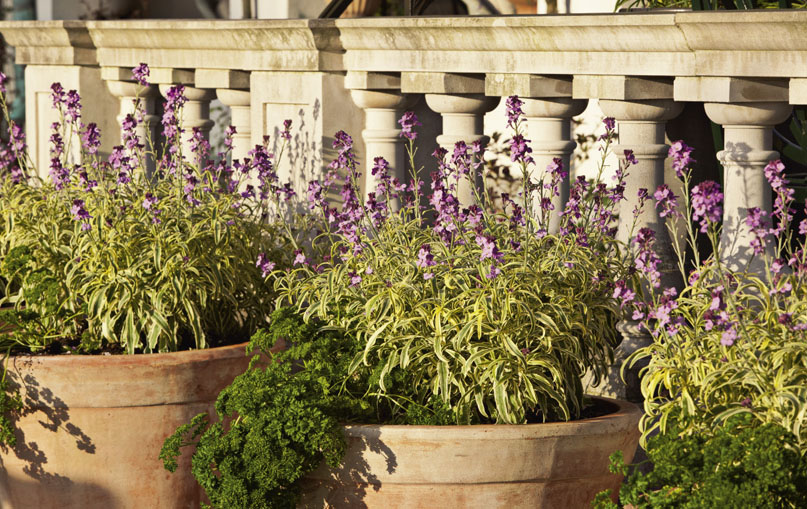
These containers of Erysimum linifolium ‘Variegata’ garnished with curly parsley make quite a statement along the parapet
Erysimum ×marshallii
syn. Cheiranthus allionii
• yellow, orange
• midspring to early summer
• 18–24 in. × 9–12 in.
• sun, part shade
• Z3–8
Siberian wallflower. A hybrid of garden origin. Has gray to deep green, slightly downy, lanceolate, semi-evergreen, toothed leaves. The four-petaled flowers are yellow to bright orange, and strongly perfumed. If deadheaded it continues to bloom all summer.
‘Apricot Delight’ bears apricot-orange flowers on compact bushy plants.
Other Notable Cultivars
There are many other cultivars, but most are bred for bedding displays and not perennial.
Rysi Strain is more reliably perennial, to 16–18 in. high and wide, with cultivars bearing golden flowers flushed with bronze (‘Rysi Bronze’), coppery orange (‘Rysi Copper’), chrome yellow (‘Rysi Gold’), cream fading to milky white (‘Rysi Moon’) and primrose yellow (‘Rysi Star’).
Liliaceae
trout lily, dogtooth violet
Trout lilies are native to forests and damp meadows across temperate regions of the world and many can be found growing wild in parts of North America. They are one of the special joys of the spring garden, with gracefully nodding flowers commonly featuring swept-back petals and prominent stamens. Typically bloom time is two to three weeks long; the flowers present a pretty contrast to the tongue-shaped spotted or plain green leaves. The mottling of the leaves suggests the speckled side of a trout (hence the common name). The other traditional name for this genus, dogtooth violet, refers to the pointed, bulb-like, tuberous roots, which were imagined to resemble the shape of a dog’s tooth—it’s important to note that this genus is not related to violets (Viola).
Plant trout lilies in fall about 4 in. deep in a humus-rich soil that does not dry out. They prefer partly shaded places, and will not endure intense sun.
Seldom browsed by deer and generally pest and disease resistant. Allow to colonize in damp woodlands with ferns, primroses, summer snowflake, and other plants that enjoy shaded, damp places.
To propagate, mark the position of plants in spring, and dig in late summer to remove and replant offsets. Sow seed as soon as it ripens in late spring or early summer; seedlings are very slow growing and often require five to six years to reach flowering size.
Erythronium albidum
• white
• mid- to late spring
• 4–8 in. × 9 in.
• part shade, shade
• Z4–8
White trout lily, white fawn lily, yellow snowdrop. Moist, light woodlands of the eastern United States and Canada. Springing from a corm-like bulb, each plant has a pair of oval, 3- to 9-in.-long leaves that are irregularly mottled with silver. The solitary, 1.5-in., white flowers, flushed with yellow at the base, are borne on 6- to 12-in., leafless stems (scapes) and have reflexed petals reminiscent of cyclamen. When temperatures rise in early summer, the plants retreat underground. Spreads readily by offsets from the roots; these may take two years to bloom.
Erythronium americanum
• yellow
• early spring
• 3–8 in. × 8 in.
• part shade, shade
• Z3–8
Adder’s tongue, yellow trout lily, yellow dogtooth violet. Rich, damp woods and wet meadows of the eastern seaboard of the United States. A pair of smooth, pointed, brown-and-purple-mottled leaves, 3–8 in. long, rise from a scaly bulb; immature bulbs produce only one solitary leaf. A single, 3- to 7-in. scape terminates in a nodding, yellow to brownish flower with recurved petals, brown on the underside. In the wild these plants colonize readily and some stands are reputed to be 300 years old. Summer dormant. Seeds about freely; if growing in a lawn, delay mowing until the seeds have been disseminated.
Erythronium dens-canis
• pink, white, purple
• midspring to late spring
• 8–12 in. × 6 in.
• sun, part shade
• Z3–8
Dogtooth violet. Mountain meadows of southern Europe. Flowers of this charmer are solitary, mostly rosy-purple with purple anthers and ringed with red-purple at the throat, about 2 in. long. Strongly purple-mottled, 4- to 6-in. basal leaves, in pairs are reputedly tasty in salads. Several cultivars are available:
‘Lilac Wonder’ has light purple flowers accented with a chocolate ring at the base. Early. 6–8 in.
‘Pink Perfection’ has clear bright pink flowers on 3- to 4-in. stems. Early.
‘Purple King’ is bright pinkish purple, sometimes rimmed with white. Vigorous, and suitable for underplanting shrubs, in rock gardens, and for lining woodland paths. 6 in.
‘Rose Queen’ has rosy pink flowers, with a deep brown blotch at the base. 4–8 in. tall.
‘Snowflake’ is clean white with a taupe base. 6 in.
‘White Splendor’ has white flowers, blotched with brown at the base. Early. 6–8 in.
Erythronium grandiflorum
• yellow
• late spring
• 12–20 in. × 15 in.
• part shade
• Z4–8
Yellow glacier lily, yellow avalanche lily, lambs’ tongue trout lily. Clearings and open woods, often under Ponderosa pines and Gambel oaks, in the western United States, California to Alberta, Montana, and Colorado. Pairs of upright, elliptic, plain green leaves, undulating along the edges, to 8 in. in length, appear shortly after snow melt. Large, showy drifts of 2-in., bright yellow, starry flowers, several per scape, bloom for about a month.
Erythronium revolutum
• rose-pink
• early to midspring
• 12–14 in. × 10 in.
• part shade
• Z5–8
Mahogany trout lily, coast fawn lily, pink fawn lily. Coastal areas from northern California to British Columbia, especially along streams and in damp forest clearings. One to several nodding, bright rose flowers top pinkish scapes above basal pairs of white-marbled, broadly lance-shaped leaves to 8 in. long. Seeds about freely to form colonies.
‘Pink Beauty’ has reflexed, clear pink petals. Self-sows readily and is charming in drifts in light woods. 12 in.
Other Notable Cultivars
‘Pagoda’. This vigorous hybrid of western US species (Erythronium tuolumense × E. revolutum) produces several 1.5-in-wide, bright yellow flowers with a reddish brown eye on each naked stem. Blooms for up to a month in mid- to late spring. Each bulb may produce several stems, in contrast to other species that bear a solitary stem per bulb. The silvery green, sometimes mottled, basal leaves emerge somewhat later than those of E. americanum and disappear in hot weather. An attractive companion for naturalized narcissus and Spanish squills. Often listed as a cultivar of either parent. Later-blooming ‘Kondo’ is similar and has the same parentage. The species E. tuolumnense, from the foothills of the Sierra Nevadas, is seldom grown.

Erythronium ‘Pagoda’ provides early color in this hosta bed
Asteraceae
Joe-Pye weed
This is another recently reclassified genus that has been broken away from Eupatorium; look there for general information.
Eupatoriadelphus dubius
syn. Eupatorium dubium
• pink
• midsummer to early fall
• 2–5 ft. × 1 ft.
• sun, part shade
• Z4–8
Eastern Joe-Pye weed. East Coast of North America from Nova Scotia to South Carolina. Typically 3- to 4-ft.-tall, purple-flecked stems clothed in whorls of lanceolate, toothed leaves. Small, purplish pink flowers carried in domed heads 4–7 in. across. Prefers moist soils but tolerant of drought. A compact alternative to its better-known relatives Eupatorium purpureum and Eupatoriadelphus maculatus.
‘Phantom’ is extra compact, with wine-colored, sweet-scented flowers. 2–3 ft.
Eupatoriadelphus maculatus
syn. Eutrochium maculatum, Eutrochium purpureum subsp. maculatum, Eupatorium maculatum
• purple
• midsummer to late summer
• 4–7 ft. × 3 ft.
• sun, part shade
• Z5–9
Spotted Joe-Pye weed. Manitoba south to Georgia eastward. Solid purple or purple-spotted stems bear toothed, lanceolate leaves in whorls of three to five. Small, light purple flowers borne in branched, usually flat-topped clusters to 8 in. across. Flowers are lightly scented and very showy when planted in mass. Prefers an organic-rich, moist soil; leaf edges liable to browning and crisping when subjected to drought. Especially valuable for foraging bees.
‘Atropurpureum’ (syn. Eupatoriadelphus purpureum var. atropurpureum) has purplish black stems and reddish purple flowerheads to 18 in. wide.
‘Gateway’ is relatively compact with wine-colored stems; it bears huge, pink flowerheads, 12–18 in. across. 3–5 ft. tall.
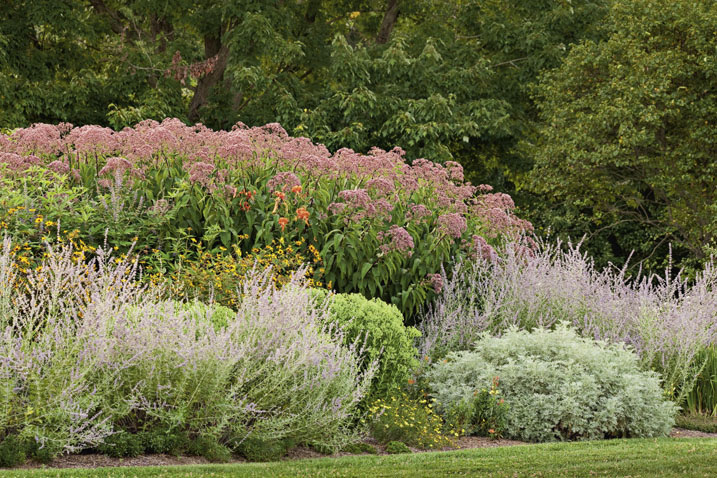
Eupatoriadelphus maculatus ‘Gateway’ provides a fine background for Russian sage, Rudbeckia, and Artemisia in this autumnal border
Asteraceae
boneset, Joe-Pye weed
This globe-trotting genus is found all over the Northern Hemisphere—in Europe, northern Africa, and central Asia—but it is the North American species, natives of the eastern half of the continent, that are the horticultural stars. These garden-worthy types earn their keep with their strong presence: they are large, exuberant plants that contribute foliage mass and texture, as well as flowers. Individually the flowers are small and most often subdued in color, but they are borne in substantial to huge, parasol-like heads. Furthermore, their bloom season commonly comes in late summer or fall, when the perennial garden most needs additional color. The flowers attract butterflies and other insect pollinators, and the seedheads that follow provide late-season food for a variety of birds.
The taller eupatoriums—they can stand head-high or even higher—require staking in a wind-swept site. Alternatively, pinch back the stems in mid- to late spring to about half their height to promote more compact, bushy growth; this treatment also leads to a slightly later bloom season. Eupatoriums appreciate a rich, organic soil, and require moderate but regular irrigation while young, as well as for the best bloom. However, they tolerate drought once established.
Combine eupatoriums with other late bloomers such as goldenrods (Solidago), swamp hibiscus (Hibiscus coccineus), asters, and the taller ornamental grasses. The native species are ideal for native, meadow, or prairie plantings, as well as at the back of borders and among shrubs. Butterflies and bees are frequent visitors and pollinate the flowers. Typically bonesets are healthy plants, but are susceptible to leaf miners, mildew, and leaf spots. Only Eupatorium fistulosum is reportedly browsed by deer; other species are left alone.
Propagate by dividing mature clumps in late winter or spring, by seed, or by stem cuttings taken in spring.
Eupatorium altissimum
• white
• late summer to early fall
• 3–4 ft. × 2–3 ft.
• sun, part shade
• Z3–9
Tall boneset. This tough and adaptable species is native throughout the eastern half of North America, inhabiting dry to mesic prairies, meadows, woodland openings, pastures, and even vacant lots. It forms a group of upright, hairy stems that branch only at their tips in the flower clusters. Dark green, pubescent leaves are opposite, lanceolate to narrowly ovate, and up to 5 in. long and 1 in. wide. Inflorescence is a flat-topped cluster of tiny, white flowers that bloom for four to six weeks. Not particularly showy, but hardy and versatile, growing equally well on loams, clays, and gravelly soils of assorted pH levels. Withstands drought well and competes successfully with most neighbors in meadow plantings or wild gardens.
‘Prairie Jewel’ has variegated cream-and-green, mottled foliage. More compact than the species, reaching a height of 3 ft. Z4–9.
Eupatorium capillifolium
• white
• midsummer to early fall
• 4–8 ft. × 3–4 ft.
• sun, part shade
• Z4–10
Dogfennel. Roadsides and disturbed sites from Massachusetts to Florida, westward to Missouri and Texas, as well as Cuba and the Bahamas. Spreads by rhizomes and can be weedy; reportedly aggressive in Florida, though not further north. Forms a clump of hairy stems with aromatic, finely dissected, feathery foliage (“capillifolium” means “hair-leaf”), somewhat similar to that of fennel (Ferula). Individual flowers are small, but borne in large, loose plumes. A tall and striking plant, though not distinguished enough for most borders; better for meadows and native plant areas.
‘Elegant Feather’ is more refined, forming narrow, upright plumes of finely textured foliage. Sterile, does not self-seed as does dogfennel. Z7–10.
Eupatorium coelestinum
syn. Conoclinium coelestinum
• blue
• late summer to early fall
• 2–3 ft. high and wide
• sun, part shade
• Z4–9
Hardy ageratum. Eastern half of North America. Red stems bear heads of fuzzy, blue flowers that are closely similar to those of the familiar annual ageratum or floss flower. Tolerant of most soils, but best suited to clays and organic-rich ones. Prefers moist to average conditions; grows best in full sun, but tolerates light shade. Naturalizes readily, especially in warmer regions, making an attractive tall groundcover.
‘Cory’ is upright, with crinkled leaves and more abundant, showier blooms on purple stems.
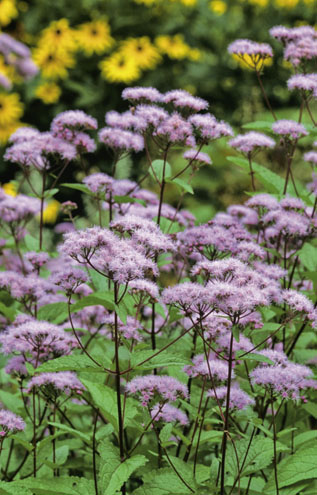
Eupatorium coelestinum
Eupatorium purpureum
syn. Eutrochium purpureum
• pink, purple
• midsummer to early fall
• 5–7 ft. × 2–4 ft.
• sun, part shade
• Z3–9
Sweet-scented Joe-Pye weed. Wet meadows, stream banks, and wooded slopes throughout the eastern half of the United States and Ontario. Erect clumps of sturdy stems furnished with whorls of three to four serrated, lanceolate, dark green leaves to 12 in. long. Domed, mauve flowerheads are vanilla scented, to 8 in. across; they give way to attractive seedheads that persist into winter. Prefers a moist, fertile, richly organic soil; tolerates average soils unless subjected to drought, which causes browning of leaf edges. Plant in groups or mass at the back of borders, cottage gardens, meadows, and at the water’s edge.
‘Little Red’ has pink-purple flowers. Compact at 3–4 ft. × 2–3 ft.
Euphorbiaceae
spurge
The best-known member of this genus is the decorative holiday poinsettia, Euphorbia pulcherrima, but this has a number of garden-worthy, perennial relatives. Upright or trailing stems well clothed with oval, pointed leaves arranged in whorls or spirals are typical. The flowers are cup shaped with petal-like bracts ranging in color from red to yellowish green or lime. Flowers are borne in variously shaped heads or inflorescences, which are often quite large.
Best in sunny spots but appreciative of midday shade in regions with intense sunlight. Partial or light shade is acceptable, but avoid deeper shade. A moist, fertile soil, well drained and not overly rich, is ideal. The milky sap of the plants causes painful skin rashes in sensitive individuals, and in some species is actually poisonous, so avoid planting them near children’s play areas. On the plus side, deer, rabbits, and most insects avoid these plants.
The larger spurges are perfect for flowerbeds and borders and for planting among shrubs, as well as for punctuating gates and entryways. Use drought-tolerant species in xeriscapes; site low-growers where they can tumble over walls and creep among pavers. Not described here but useful for xeriscapes in cooler regions (Z5–7) is E. dulcis ‘Chameleon’, which provides tight mounds of red-purple foliage. Beware of cypress spurge (E. cyparissias), an invasive European species. Many spurges make excellent and unusual cut flowers; flame the base or dip the base of the stems into boiling water to stop the flow of sap that will otherwise pollute the vase water.
Propagation is mainly from seed or by division of mature clumps. Leaf or stem cuttings may be taken in spring or summer to increase some species.
Euphorbia amygdaloides
• yellow
• late spring
• 12–20 in. × 15 in.
• sun
• Z5–8, HS
Wood spurge. Woodlands, meadows, and banks from Ireland, east to the Caucasus. Seeds about freely, so cut spent flower stems to the ground after bloom. Upright, reddish stems with spatulate (spoon-shaped), dark green foliage; yellow-green, bracted flowers. Seldom successful in the southeastern United States.
‘Purpurea’, purple wood spurge, has dramatic deep purple or mahogany winter foliage with fluffy, wine-colored new growth in early spring. Heads of lime-green flowers bloom above a little later. Seeds freely.
‘Ruby Glow’ has burgundy, ruby, and bronzy foliage and chartreuse blooms. 18 in. Z6–8.
var. robbiae (syn. Euphorbia robbiae), Mrs. Robb’s bonnet, spreads aggressively by rhizomes to make a dense groundcover, which may become invasive. Evergreen with showy, yellow-green flowers. Drought and shade tolerant. Suitable for woodland gardens and along wooded pathways, as well as massed in sun or shade. 1–3 ft. Z5–7.
Euphorbia characias
• yellow
• early spring to late spring
• 3–5 ft. × 3 ft.
• sun
• Z6–8, HS
Mediterranean spurge. Western Mediterranean. Strong, stout upright stems, woody at the base, crowded with spirals of pointed, blue-green leaves to 5 in. long; lower leaves may drop under stress. Large heads of greenish yellow flowers unfurl at the top. Great for winter and spring gardens. Often short lived, especially in the heat and humidity of the southeastern United States, but because it seeds freely, replacements abound. Cut back flowering stems after bloom.
subsp. wulfenii (syn. Euphorbia wulfenii) differs from the above in having larger leaves and enormous cylindrical heads of yellow-green flowers, to 6–9 in. Drought tolerant. 3–4 ft. Z7–8.
‘Lambrook Gold’ is bushy with narrow, gray-green foliage and chrome-yellow flowerheads from early spring to midsummer. 3.5 ft. Z7–8.
‘Tasmanian Tiger’ (‘Variegata’, ‘Tassie Tiger’) is a flashy variegated form of this species with slender, blue-green leaves edged with white. Heat and drought tolerant, but resents high humidity; not good in southeastern United States. Excellent in containers. 3 ft. high and wide. Z6–9.
Euphorbia griffithii
• orange
• summer
• 24–36 in. × 24 in.
• sun, part shade
• Z5–7, HS
Griffith’s spurge. Himalayas. Makes robust mounds of sturdy stems clothed with green, lanceolate leaves, pink along the midrib. Flowers have dazzling brick-red bracts. Remains attractive well after bloom time. Best in part shade in regions where sunlight is intense; elsewhere it tolerates full sun.
‘Fireglow’ has flame-orange floral bracts on bright red stems; green leaves take on wonderful autumn tints. 3 ft. Z6–8.
Euphorbia myrsinites
• chartreuse
• mid- to late spring
• 15–18 in. × 2 ft.
• sun
• Z5–9
Myrtle euphorbia. Eurasia. Beautiful trailer whose long prostrate stems are furnished with whorls of ice-blue leaves; looks good throughout the year. In spring, acid-yellow bracts decorate the flowerheads. Cut back hard after bloom time to avoid unwanted seedlings and promote handsome new growth, which appears at once and is particularly welcome in autumn and winter. Drought tolerant. Good between pavers, in rock gardens, and in hanging baskets. Unforgettable tumbling over a wall with Origanum ‘Kent Beauty’ in summer.
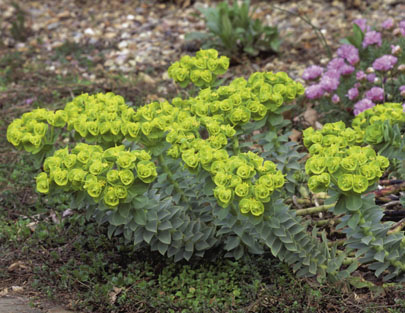
Euphorbia myrsinites
syn. E. epithymoides
• yellow
• spring to late spring
• 18–24 in. × 18 in.
• sun, part shade
• Z4–7
Cushion spurge. Europe. Clumping with strong stems clothed with 2-in.-long, oblong leaves. In spring the tops of the stems are covered with ruffs of brilliant chartreuse-yellow bracts. Best in full sun in cooler, less sunny regions, but midday shade is necessary in areas with intense sun and heat. Perennial cornflowers and Spanish bluebells are attractive companions.
‘Bonfire’. Slender, curvy-edged leaves are bluish green, purple at the tips when young. Brilliant sunny-yellow “flowers” in early spring. 12 in. Z5–7.
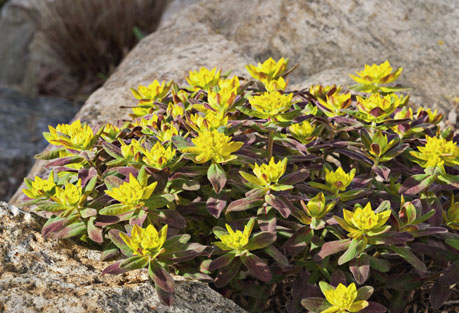
Euphorbia polychroma ‘Bonfire’
Other Notable Cultivars
Much breeding has taken place in recent years as euphorbias have gained in popularity. This is a sampling of what is available.
Blackbird (‘Nothowlee’) has bushy, very dark purple foliage that persists through the year. Chartreuse flowers. 16–18 in. Z7–9.
‘Efanthia’ (syn. Euphorbia amygdaloides × E. ×martinii) is bushy and compact with evergreen, dark leaves, bright bronze when young and in cool weather. Chartreuse-yellow flowers. Drought tolerant. 12–36 in. Z4–11. Improved Efanthia (‘Imprefant’) is more compact at 10–14 in., but is otherwise similar.
‘Glacier Blue’ (sport of ‘Tasmanian Tiger’) is strikingly beautiful with silvery-blue leaves rimmed with white. Evergreen. Cream flower bracts striped with gray-blue. Bluer than its parent. 12–18 in. Z7–11.
Helena’s Blush (‘Inneuphhel’, variegated form of ‘Efanthia’). Rounded habit, with reddish young growth that matures to gray-green with cream variegations, with pink. Selected by Garry Grueber of Cultivaris. Resists powdery mildew. 12 in. Z4–11.
‘Jade Dragon’ (syn. E. characias subsp. wulfenii × E. amygdaloides) has huge, chartreuse flowerheads in summer. Purple when young, the blue-green foliage is later flushed with reddish pink. 1–3 ft. Z7–9.
×martini (syn. E. amygdaloides × E. characias). Martin’s spurge, red spurge. This natural French hybrid is variable and selections may favor one parent or the other. Upright spikes of lime-green bracts with a red eye adorn stiff stems clothed with dark grayish green leaves. Short lived. Cut back to the ground after bloom time. 2–3 ft. × 2 ft. Z6–8.
‘Ascot Rainbow’ has bluish green foliage broadly and irregularly variegated with creamy gold; pink flushed when temperatures drop. 20 in. Z6–8.
‘Shorty’ is very compact with blue-green foliage that becomes bright red or purple tipped in cool weather. Chartreuse flowers in spring. Tolerates drought and heat. An introduction from ItSaul Plants in North Carolina. 15–18 in. Z7–11.
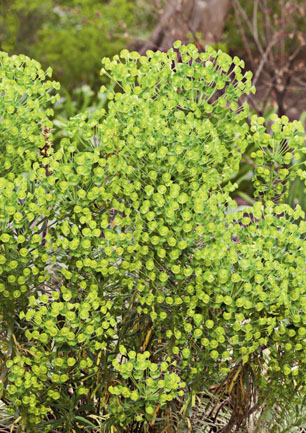
Euphorbia ‘Shorty’
Asteraceae
bush daisy
Bush daisies deliver outstanding value. They bloom, collectively, from late spring through late fall, mounting a continuous profusion of showy, golden flowerheads—bright yellow ray flowers and darker central disks—held on long stems above neat, bushy mounds of alternate, bright or gray-green, finely cut foliage. Young plants require regular irrigation during dry spells through their first growing season, but after that their far-reaching root systems tap deep water sources, making these plants outstandingly tolerant of xeric conditions. Not surprisingly, this genus is especially popular with Californian gardeners and in the US southwest.
Deadhead bush daisies, pruning back a couple of inches to encourage continued bloom and neatness. Where not winter hardy, bush daisies adapt very well to container culture. Be sure that soil drains freely and the pots are sited in a sunny spot. Deer resistant, but often eaten by rabbits. Otherwise mostly pest and disease free.
Propagate by seed in spring, or take softwood cuttings of soft new growth in spring; semi-ripe cuttings may be rooted in summer.
Euryops acraeus
syn. E. evansii of gardens
• yellow
• late spring to early summer
• 12–24 in. × 12 in.
• sun
• Z8–11
Bush daisy. Drakensberg Mountains, South Africa. Dense mounds of tip-notched, silver-gray leaves, 1 in. or more long. Flower stems 1.5 in. long carry one to three deep yellow daisies, each 1 in. across. Requires very sharp drainage.
Euryops pectinatus
• yellow
• late spring to late fall
• 4–6 ft. × 3 ft.
• sun
• Z8–11
Euryops, yellow bush daisy. South Africa. These bushy evergreen plants are subshrubby or herbaceous, with attractive, hairy, cut, gray-green leaves to 3 in. long. The reflective silvery hairs that cover the foliage equip the plants to survive harsh sun without damage. Long-stemmed, 2-in. daisies bloom singly or in small groups from midspring on. Excellent for winter bloom in mild climates or in containers in sunrooms and conservatories where not winter hardy. Can be trained as standards.
‘Munchkin’ is a dwarf selection, excellent for lining paths and walkways, massed in beds and borders, or as edging plants. Combine with other xeric plants in hot, dry inland sites. 3 ft. tall.
‘Viridis’ (green-leaved euryops, African daisy) has dark green, glossy leaves and a more rounded habit than the species. They tolerate training as standards. Very attractive to butterflies, and birds enjoy the seedheads after bloom time. 2–3 ft. tall.
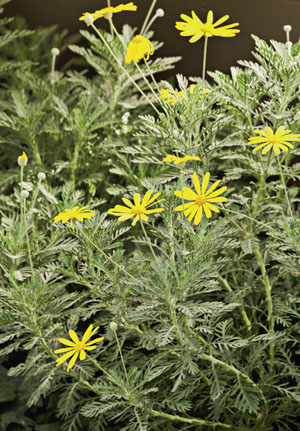
Euryops pectinatus
Convolvulaceae
evolvulus
These relatives of morning glories offer blossoms of similar form and equally intense blues without the morning glories’ smothering, vining growth. Evolvulus are compact subshrubs with fluted, funnel-form flowers that recall the horns on antique phonographs. These flowers, like those of morning glories, open in the morning and close in the afternoon. Three species are in cultivation.
Propagation is from seed or cuttings.
Evolvulus arizonicus
• blue
• midspring to midfall
• 1 ft. × 1–2 ft.
• sun, part shade
• Z7–10
Arizona blue eyes. Upland areas and desert grasslands from Arizona to west Texas and south to northern Mexico. Forms low, spreading mounds of stems, each bearing narrow, lanceolate, gray-green leaves to 1 in. long. The 0.75-in. flowers range in color from sky blue to a deep azure; bloom coincides with periods of available moisture. Survives on just natural precipitation once established. Prefers a well-drained, unimproved soil—do not dig in organic matter. Excellent groundcover for xeriscapes, and displays of natives in the southwestern United States. A short-lived perennial that commonly self-seeds.
• blue
• summer to fall
• 9–18 in. × 24–36 in.
• sun, part shade
• Z8–11
Brazilian dwarf morning glory. Brazil and Paraguay. Commonly grown as a summer annual where winters are cold, but is perennial in mild-winter regions. Forms a sprawling mound of fuzzy stems and foliage. Leaves are egg shaped, 0.5 in. wide and 1 in. long; flowers are 1 in. across, pale lavender or powder blue, with a white, star-shaped mark in the throat. Prefers full sun and sandy, well-drained soil with frequent irrigation. Excellent for providing texture and color in beds and borders, or as a groundcover; complement with yellow or pink flowering plants including petunias, low-growing sedums, and gauras. Salt tolerant and a good choice for seaside gardens. Attractive when cascading over walls, hanging baskets, or tubs.
‘Blue Daze’ is also the name for what is advertised as a cultivar of Evolvulus nuttallianus, but judging from the hardiness data (only to 32°F), this may fit better under E. glomeratus.
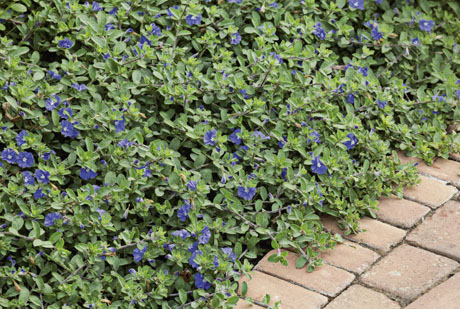
Evolvulus glomeratus ‘Blue Daze’
Evolvulus nuttallianus
syn. E. argenteus, E. pilosus
• blue, lavender
• spring to midsummer
• 1–1.5 ft. high and wide
• sun, part shade
• Z4–10
Shaggy dwarf morning glory. Montana and North Dakota to Texas and Arizona. Dense, hairy subshrub with sprawling stems that root at the nodes where they touch the ground; silver-green leaves oblanceolate, to 1 in. long. Lavender to pale blue, 0.5-in. flowers are centered with a five-pointed, white eye. Thrives in an organic-rich, consistently moist, well-drained soil, but also tolerates sandy ones amended with compost. Good for rock gardens, native plant displays, and xeriscapes, or where water is short.
Asteraceae
leopard plant
Veteran gardeners may know the leopard plants by their former botanical names as members of the genus Ligularia. More recently, however, the leopard plants were given their own genus, Farfugium, as befits such bold, intriguing perennials.
These eastern Asian plants are grown mainly for their handsome evergreen, long-stalked leaves that are held well above the crown. Valuable in wet places beside ponds and streams, or as dramatic accents in beds and shrub borders. They are good companions for astilbes, primroses, and Japanese irises. The variegated cultivars are most popular, particularly as dynamic container plants to decorate patios and decks, and sunrooms in cooler regions. All bear loose, long-stemmed clusters of yellow daisies late in the season; many gardeners feel these detract from the foliar display and remove them.
Leopard plants do best in average soil that is moist but not waterlogged. Most prefer morning sun, but accept light shade; some tolerate full sun. Foliage may droop or flag during midday sun, but regain its turgidity in the cool of the day. Mulch well where soil tends to dry out. Protect from slug damage; usually ignored by deer. Especially popular in warm-climate gardens.
Increase by dividing clumps in spring, or start from seed with protection in winter.
Farfugium japonicum
syn. F. tussilagineum, Ligularia tussilaginea
• yellow
• fall
• 18–24 in. × 24 in.
• sun, part shade
• Z6–11
Leopard plant. Rocky cliffs along the coasts of Japan, Taiwan, and Korea. This clumping perennial has glossy, long-stalked, 6- to 10-in.-wide leaves, kidney shaped with wavy, toothed, or entire margins. Bright yellow daisies, 2 in. or so across, cluster on long stems well above the foliage in fall and into winter. An excellent contrasting companion for fine-textured ferns. The cultivars are more often grown than the species.
‘Argenteum’ (‘Albovariegatum’, ‘Variegatum’). The 10-in.-wide leaves are thick and cupped, irregularly rimmed with wide, white streaks, held on purple stems covered with woolly hairs. Yellow flowerheads. 15–24 in. Z7–8.
‘Aureomaculatum’ (syn. Ligularia tussilaginea ‘Aureomaculata’) has 8- to 10-in.-wide, dark green leaves, irregularly and conspicuously marked with yellow spots. Yellow, daisy-like flowers. Do not allow to dry out or become waterlogged. 20 in. Z6.
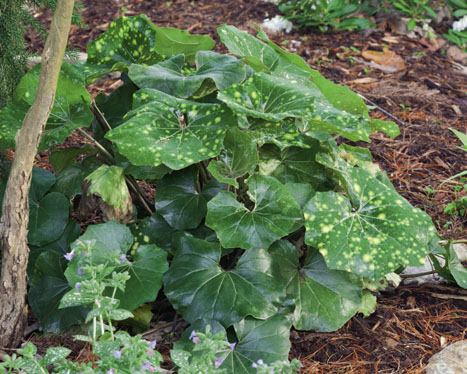
Farfugium japonicum ‘Aureomaculatum’
‘Cristata’ (‘Crispatum’, syn. L. tussilaginea ‘Cristata’) has bold, glossy, heart-shaped, 1-ft.-wide leaves twisted from the stem like a snail. The leaves have frilly edges and are woolly hairy beneath. Yellow flowers. 2 ft. Z6–8.
Apiaceae
giant fennel
Although there are many species in this genus, only one—giant fennel—is perennial and suitable for ornamental gardens. This one, however, is a handsome and imposing plant worth cultivating as much for its architectural beauty as for the delicate foliage and interesting flowers. As expansive as its name suggests, giant fennel needs plenty of room in which to show off its form. It also requires full sun and a moist soil that is deep enough to accommodate its long, thick taproot.
Giant fennel is excellent in wild gardens, attracts numerous bees, small insects, and butterflies. In large perennial or mixed borders, this plant makes a stunning backdrop and mixes gracefully between shrubs. Seldom browsed by deer or rabbits, which are probably deterred by the aroma of the leaves. Aphids and slugs may be a nuisance. Do not confuse this plant with edible Foeniculum vulgare, also known as fennel.
Propagate by seed sown as soon as it ripens in late summer and overwinter outdoors in a cold frame or other protected spot.
Ferula communis
• yellow
• early to midsummer
• 6–10 ft. × 1.5–2 ft.
• sun
• Z6–9
Giant fennel. Dry slopes and rocky hillsides of the Mediterranean, Malta, and central Asia. This deeply rooted, robust, and dramatic cousin of celery, archangel, and parsley forms clumps of branching or simple stems that support a mound of aromatic, very finely dissected, light green basal leaves with sheathing petioles. Boldly ridged, hollow stems, sometimes as thick as a broomstick, carry alternate clasping flower stems topped with hemispherical branched umbels of tiny, five-petaled, yellow flowers. Each umbel may grow 3 in. across. Exhausted plants may die after setting copious amounts of seed that germinates readily as soon as it is ripe. Seedlings may take a few years to reach blooming size.
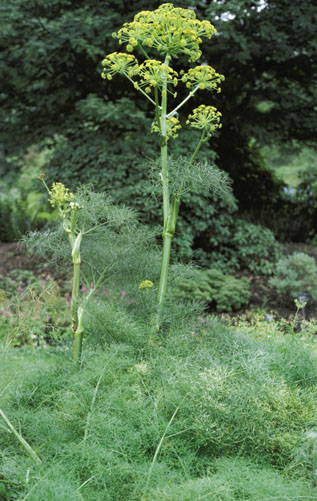
Ferula communis
Rosaceae
meadowsweet
A select genus of just 12 species, the meadowsweets offer a range of attractions: perfumed, eye-catching flowerheads and handsome foliage, combined with the ability to flourish in a variety of climates, typically without significant pest or disease problems; they are deer tolerant as well. These hardy, rewarding plants thrive in deep, organically rich, moist soils in full sun or partial shade. Summer drought may cause their leaves to scorch; cut the stems back when the dry spell breaks; fresh foliage soon replaces the old.
Depending on the stature of the species you select, meadowsweets can serve at the back or middle of a border. The taller, more robust species hold their own as part of meadow plantings, especially where soils are moist. Their airy, pastel-hued flowers and bold foliages complement the finer textures and more subdued colors of the grasses. Meadowsweets show up especially well when planted in drifts, and furnish excellent cut flowers. Propagate in spring or fall by seed or by division.
• white
• mid- to late spring
• 36 in. × 24 in.
• sun, part shade
• Z5–8
Nakai Korean meadowsweet. Northeastern Asia. This underappreciated species is seldom found in the nursery trade, yet makes a fine garden perennial. In mid- to late spring, clumps of grape-like leaves give rise to stalks bearing corymbs of small white or pink flowers.
Filipendula purpurea
• pink, white
• late spring to midsummer
• 36–48 in. × 24–36 in.
• sun, part shade
• Z3–8
Japanese meadowsweet. Japan. Upright and clump forming, bears rich green, maple-like leaves that measure 4–8 in. across, and fluffy corymbs of astilbe-like flowers that are white with red stamens (appearing pink from a distance) or purple. Easily cultivated in average, well-drained garden soil, but performs best on those that are fertile, organic rich, and kept consistently moist. Benefits from some afternoon shade in hot, sunny climates. Susceptible to powdery mildew, rust, and leaf spot, but usually without serious damage.
‘Alba’ is white flowered.
‘Elegans’ is more compact, with flowers similar to those of the species, but with evident red stamens. 18–24 in. tall.
‘Purpurascens’ has purple-tinted foliage.
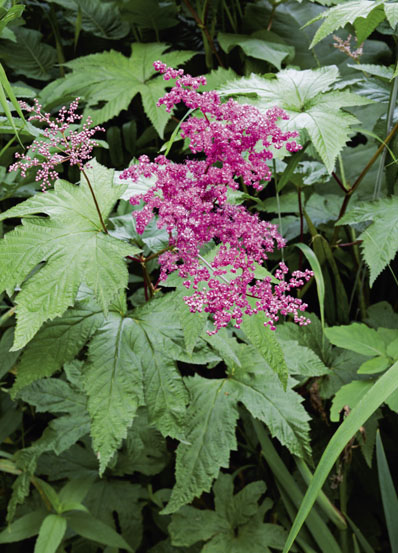
Filipendula purpurea
Filipendula rubra
syn. Spiraea lobata, S. palmata, S. venusta
• pink
• early to midsummer
• 6–8 ft. × 3–4 ft.
• sun, part shade
• Z3–8
Queen-of-the-prairie, false spirea. Wet grasslands and fens from Missouri to North Carolina, northward into Canada. This plant offers an unusual characteristic: both its flowers and foliage are fragrant. Forms an imposing, upright clump of sturdy, often reddish stems that rarely need staking. Leaves compound, to 2 ft. long, composed of one to seven bright green, deeply palmately cut leaflets as much as 6 in. long. Fluffy, sweet-scented, pink flowers are individually tiny but borne in dense, astilbe-like panicles, 6–9 in. wide. Flourishes in moist or even wet, well-drained soils, especially those that are fertile and humus rich. Does not tolerate drought, but free from serious insect or disease problems. A good planting for pond sides or stream banks, this species self-seeds freely in a hospitable site. Spectacular, especially when grown in a mass, outstanding for wild or naturalized areas, wet meadows, or the back of a border.
‘Albicans’ (‘Magnificum Album’) has white flowers and is shorter. 5–6 ft.
‘Venusta’ (‘Magnifica’, ‘Venusta Magnifica’, syn. Filipendula venusta) has deep pink flowers on 4 ft. stems.
Filipendula vulgaris
syn. F. hexapetala, Spiraea filipendulina
• white
• late spring to early summer
• 16–20 in. × 12–18 in.
• sun, part shade
• Z3–9
Fern-leaf dropwort. Pastures of Europe, much of central and northern Asia. Much more tolerant of dry soils than other members of the genus. Forms a low mound of finely cut, dark green, fern-like leaves, from which arise upright stems bearing panicles of creamy-white flowers. Useful for edging, for the front of a border, or for containers. Foliage smells of wintergreen when crushed.
‘Multiplex’ (‘Flore Pleno’) has drooping panicles of 0.25–0.40 in., double, white flowers like tiny rosebuds.
‘Plena’ bears double flowers; outstanding for cutting and formerly a staple of wedding bouquets.
Other Notable Cultivars
‘Kahome’ is a dwarf that attains a height and spread of just 6–12 in. Astilbe-like corymbs of tiny, fragrant, rosy pink flowers in summer to early fall. The bright green, fern-like foliage is as attractive as the blooms.
Apiaceae
fennel
This genus has just a single species, but it offers a handful of reliably perennial cultivars that, in addition to the sweet, anise-like flavor of their stalks and leaves, offer decorative foliage as well. The airy foliage makes the ornamental cultivars of common fennel a great textural background in borders, herb and vegetable gardens, cottage gardens, and even meadows, and a useful addition to butterfly gardens.
The fennel used as flavoring is common fennel (Foeniculum vulgare). This should not be confused with edible Florence fennel or finocchio (F. vulgare var. azoricum), an annual variety that develops swollen leaf bases.
Grow in a moist, organic-rich, well-drained soil; propagation is by seed, sown directly in the garden. If started indoors, seedlings should be transplanted to their ultimate destination while still young, as they form taproots that resent disturbance. Remove spent flowering stems before seed is produced to avoid any unwanted self-seeding; common fennel has become a troublesome weed in parts of the US Pacific Northwest. Common fennel is usually trouble free but is susceptible to aphids and slugs, and may be defoliated by swallowtail caterpillars. Deer ignore it.
Foeniculum vulgare
• yellow
• midsummer to late summer
• 3–5 ft. × 2–3 ft.
• sun
• Z4–9
Common fennel. This popular culinary herb is native to the lands around the Mediterranean Sea. Typically fennel forms an upright mound of feathery, compound leaves. The tiny, yellow flowers that are borne in large, flattened, compound umbels are not showy, but are very attractive to bees, butterflies, and birds.
‘Purpureum’ has attractive, purple-bronze foliage that contrasts vibrantly with the yellow flowers. Excellent as a camouflage for shabby basal foliage of ornamental onions and other bulbs. This cultivar seems to be identical with those sold under the names ‘Bronze’, ‘Giant Bronze’, ‘Smokey’, and ‘Nigra’.
Saxifragaceae
bridal wreath
Francoas are underappreciated in North American gardens, although they are generally quite easy to grow and put on a good floral display that lasts a couple of months. Their nomenclature is confusing: some experts lump all the different types together into a single species, while others distinguish many different ones.
High heat and humidity are not kind to these Chilean natives. As a result, francoas are most suitable for the western United States, especially the Pacific Northwest, or other regions with similar climates. Francoas bear closely set, 0.75-in. flowers in wand-like spikes on long, naked stems that rise above the clumps of evergreen, heuchera-like foliage. Tolerant of most soils, they thrive in moist but well-drained conditions and spread slowly by rhizomes. In cool climates treat these gems as biennials, keeping them in a cold frame or protected nursery bed through the winter and then moving them to the bed or border in spring. Seldom browsed by deer.
Francoas are fine border and cottage garden plants, mixing well with daylilies, daisies, and other perennials. They are also appropriate for rock gardens, and make fine container specimens and cut flowers.
Propagate by detaching and replanting the rhizomes. Alternatively, start from seed in spring; expect that germination may require four weeks.
Francoa sonchifolia
• pink
• summer to fall
• 2–3 ft. × 18 in.
• sun, part shade
• Z8–11, HS
Maiden’s wreath, bridal wreath. Chile. Dark green, basal foliage forms clumps about 1 ft. tall. Stiff, evergreen leaves, lobed and wavy along the edges. Terminal, unbranched, densely packed flower spikes rise high above the foliage, moving in time with every breeze. Starry flowers are mid-pink with lighter centers, marked with hot pink at the base. Francoa ramosa (syn. F. globrata) is similar but with white flowers on branched stems. Francoa appendiculata produces looser spikes of light pink flowers. Neither is quite as cold hardy as F. sonchifolia.
‘Rogerson’s Form’. Superior to the species; bright pink flowers stained with deep magenta. Tolerates wet soils well. Excellent for cutting. 12–24 in. Z7–9.
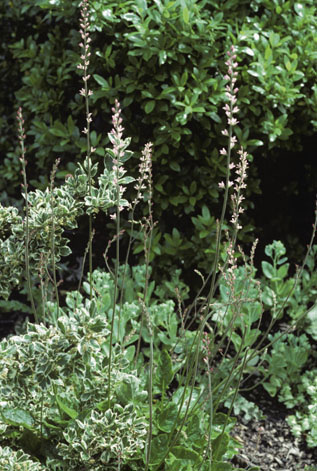
Francoa sonchifolia
Asteraceae
blanket flower, Indian blanket
Blanket flowers are among North America’s most showy native wildflowers, growing in huge sweeps across grasslands, mountain hillsides, high prairies, and meadows. Their floral hues are bold, bright, and earthy, recalling those of Native American weavings, as the common name indicates. Not surprisingly, gaillardias have in recent years attracted the attention of plant breeders, who have introduced a host of fine hybrids.
As members of the aster family, gaillardias bear their flowers in daisy-like heads consisting of deeply two- or three-lobed ray flowers (what appear to be petals) and a central button of disk flowers. The most common colors are shades of red and yellow.
Plant gaillardias in sunny spots with an average, well-drained soil; this latter quality is essential and it is critically important, especially for the hybrids, that the plants do not go into cold weather with wet feet. Deadhead for neatness and to maintain vigor, but leave a few heads if you are collecting seed, or more if you want to feed seed-eating birds. Butterflies, bees, and birds can often be seen collecting nectar and pollen from blanket flowers, adding another dimension to the garden. Lovely in native and wild gardens, in wildlife meadows, and in cottage gardens, these plants also fit in more formal applications as edgings for flowerbeds or to brighten the midsections of beds or borders. The taller sorts furnish fine, long-lasting cut flowers.
Gaillardias sometimes prove susceptible to mildews, rust, and rots. The tender young leaves are a treat for slugs and snails; however, deer and rabbits seldom browse them.
Many of the hybrids are short lived; divide established clumps in spring to maintain vigor. Propagate species by seed or division; cuttings may be difficult to root.
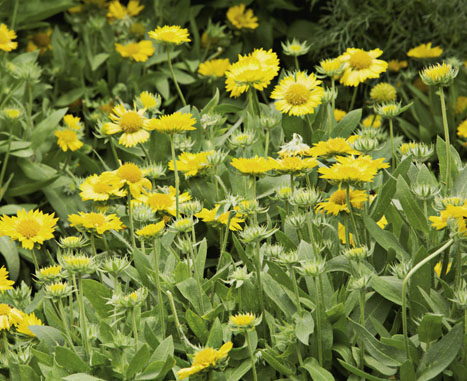
Gaillardia ‘Mesa Yellow’
Gaillardia aestivalis
• yellow
• late spring to late fall
• 12–18 in. × 9–12 in.
• sun
• Z5–9
Firewheel, lance-leaf blanket flower. Southeastern United States. Yellow-rayed, 3-in. flowerheads with purplish brown, rounded centers. Some rays occasionally appear to be missing, either partly or completely so; the central disk persists like an attractive purple globe after “petal” drop. Provides food for goldfinches, and butterflies are frequent visitors during the long bloom period. Lanceolate, grayish green leaves. Short lived, but self-seeds unless deadheaded.
var. winkleri ‘Grape Sensation’ has 2-in., solid, deep lilac rays and black-currant disks. Clumps to 2 ft. × 3 ft. Long lived, with excellent drainage.
Gaillardia aristata
• purple-red, yellow
• summer
• 24–36 in. × 18 in.
• sun
• Z3–9
North Dakota south to Colorado, west to California and British Columbia. Appropriate for dry, wild, and meadow gardens. Lobed and lance-shaped, basal leaves to 10 in.; stem leaves are sessile and not lobed. Flowerheads, 3–4 in. across, are yellow rayed, purple at the base with purple disks. This rather sprawling species is seldom cultivated except as a breeding parent. Seed takes two years to reach bloom size.
‘Amber Wheels’ has vibrant, frilled, gold rays with an amber-red disk. 30 in. Z3–9.
Bijou strain. Orange-red ray flowers tipped with yellow. Self-seeds. 10–12 in. Z4–7
‘Fanfare’ has 3-in. flowerheads with fluted, yellow rays with red tubes surrounding a deep red central disk. May be listed under Gaillardia ×grandiflora. Introduced by Plant Haven. Soil must be free draining. 15 in. Z3–9.
Gaillardia ×grandiflora
syn. G. aristata × G. puchella
• red-and-yellow
• early summer to fall
• 24–36 in. × 18 in.
• sun
• Z5–9
Blanket flower. Of garden origin. This easy-to-grow cross displays hybrid vigor in its offspring, many of which have been introduced to the marketplace. Mostly erect and somewhat spreading, with hairy, soft, dark basal foliage, lanceolate and lobed along the edges; stem leaves are sessile and entire. Showy heads of flowers may reach 4 in. across. Plants tend to be short lived, often as a result of poor drainage; most resent winter wet. A few of the species shown here seed true, but uniformity is assured by propagating the named cultivars vegetatively, by division, or from cuttings.
Other Notable Cultivars
Most of the cultivars shown here are hardy to Z3. Deadhead to extend bloom time.
‘Arizona Red’ has red flowerheads. ‘Arizona Sun’ has red, 3- to 4-in. flowers with yellow margins. Both are Fleuroselect Gold Medal winners. 12 in.
‘Baby Cole’ is maroon centered, with yellow-tipped, red rays. 6–8 in. ‘Dazzler’ is similar but 24–30 in. tall.
‘Burgundy’ (syn. Gaillardia aristata ‘Burgundy’) has wine-red, 3-in. daisy flowers with red-and-yellow disks. 18–24 in.
Commotion Series. These mounding selections have great vigor. Heads are fully semi-double, with fluted rays: Commotion ‘Frenzy’ has red petals tipped with yellow; Commotion ‘Tizzy’ has rosy red ray flowers. 18–24 in. Z5.
‘Goblin’ (‘Kobold’) has large, deep red rays, irregularly bordered with yellow. ‘Golden Goblin’ is all yellow. Z3.
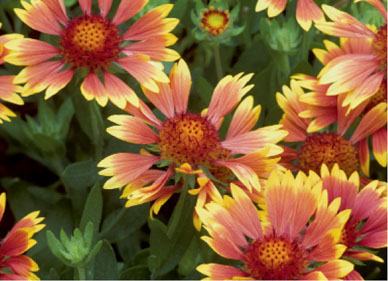
Gaillardia ‘Goblin’
Monarch Strain is a seed mix of yellow and orange to dark red flowers. 2–5 ft. tall.
‘Oranges and Lemons’. Bright cantaloupe rays tipped with lemon yellow; golden disk.
Diapensiaceae
wandflower
This native genus of but a single species deserves more attention from gardeners. Though not a fast spreader, wandflower makes a slowly expanding clump that, on hospitable sites, eventually forms large colonies of lustrous evergreen, heart-shaped foliage. Florists often use the pliable leaves of this plant to decorate Christmas wreaths and quantities of them are exported to Europe and Asia for that purpose annually.
Galax requires a moist, organic-rich, acid soil in a shaded spot. It is an excellent and unusual underplanting for acid-loving rhododendrons and azaleas, and a refined yet robust groundcover for woodland gardens, shady borders, and rock gardens.
Propagate by seed in containers (sown in acid seed mix as soon as it ripens), or by separating the rooted runners of mature clumps in spring.
syn. G. rotundifolia, G. aphylla
• white
• spring to early summer
• 3–6 in. × 24 in.
• part shade, shade
• Z4–8
Wandplant, beetleweed. Woodlands of the Appalachian mountains, and from Massachusetts and New York, southward to northern Alabama. Rounded, evergreen leaves are leathery and cordate (heart shaped), toothed around the edges and 1–3 in. across; a glossy rich green during the growing season, they turn burgundy-red or bronze in fall retaining this color through winter. The five-petaled flowers are individually tiny but are held in airy spikes atop upright, leafless stems, the whole reaching a height of 14–18 in.
Rubiaceae
sweet woodruff, bedstraw
With the exception of sweet woodruff, few species in this genus are sufficiently well mannered to grace ornamental gardens. Many are invasive and weedy, others are annual and don’t warrant a place here. They are native to waste places, woodlands, and hedge bottoms across temperate Europe, Asia, and northern Africa; many of the invasive species have escaped and naturalized beyond their homeland.
The bedstraws typically have linear leaves that they bear in whorls around weak, slender stems that commonly scramble over and through their neighbors. Their flowers are tubular and flaring at the mouth, 0.25 in. in diameter, and yellow, white, or pink; typically they are borne in clusters in the leaf nodes and at stem tips.
A partly shaded spot where soil is humus rich and moisture retentive suits bedstraws best, although full sun is acceptable where summers are temperate. They are prone to mildews, rust, and leaf spots, but these are seldom serious. Deer and rabbit tolerant. Propagate by division in spring or fall. Sow seed indoors in early spring or outdoors after all danger of frost is past.
Galium odoratum
syn. Asperula odorata
• white
• late spring to early summer
• 6–12 in. × 12 in.
• sun, part shade
• Z4–8
Sweet woodruff, wild baby’s breath, lady’s bedstraw. Europe. Square, slender, smooth stems arise from rhizomes and are punctuated at nodal intervals along their length with whorls of 0.25-in.-wide and 0.5-in.-long, bright green leaves. These remain attractive throughout the season. Growth is rapid in favorable conditions, although new plants may take some time to establish. In late spring the plants are adorned with 2- to 3-in.-wide clusters of clean white, starry flowers about 0.25 in. long, which provide the spicing for the traditional German spring drink May wine. The flowers are followed by fruits that are covered with hooked bristles that adhere to animal fur, assisting in seed dispersal. Smelling of freshly mown hay, sweet woodruff has been used for generations as a deodorizer, in potpourri and fragrant sachets, and to protect clothing from moth damage. Hikers sometimes stuff their hiking boots with the dried stems to camouflage foot odor. Keep well watered during dry spells for best growth. Lovely in light woodlands, along casual pathways, and as a groundcover among shrubs. It is often grown in herb and cottage gardens too.
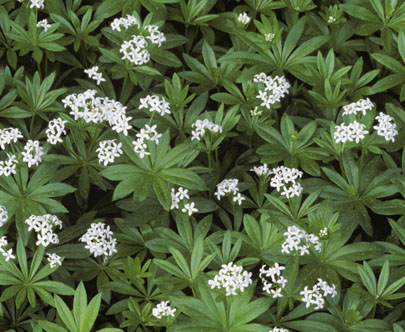
Galium odoratum
Onagraceae
gaura
This genus includes only one garden-worthy perennial species. Its open structure, slender stems, and cloud of delicate, fluttering blooms makes that particular gaura an exceptional plant for leavening and enhancing the texture of a border, and a natural companion for ornamental grasses, purple coneflowers (Echinacea), and other taller summer bloomers. It’s also well suited to native plant gardens, meadows, and wildflower gardens. This plant tolerates urban pollution well and also has exceptional heat and humidity tolerance; if given sufficient irrigation during dry spells, it will continue to bloom right through the peak of summer.
Gaura tolerates a wide range of soils, from well-drained, fertile ones to those that are dry and acid. When grown in rich soils, gaura tends to sprawl; cutting stems back by half in mid- to late spring helps keep growth more compact and sturdy. Deadheading the spent flowers helps to control prolific self-seeding.
Generally pest and disease free, though subject to root rot on heavy, poorly drained soils. This species is also deer resistant.
The easiest way to propagate this plant is by seed, as gaura forms taproots and is difficult to transplant once established. Start seed in containers to avoid transplant shock when planted out. Named cultivars, however, must be multiplied by division, which can be undertaken after two to three years of growth.
Gaura lindheimeri
• white, pink
• late spring to early fall
• 3–5 ft. × 1–2 ft.
• sun
• Z5–9
Butterfly gaura. Texas and Louisiana. Despite its southern origins butterfly gaura is surprisingly hardy. Forms a vase-shaped, airy cluster of wiry stems from which sprout stemless, narrowly lanceolate, 1- to 3-in. leaves; the reddish stems and the foliage are occasionally spotted with maroon. The common name refers to the delicate, butterfly-like appearance of the four-petaled flowers, which are borne in long, open, terminal panicles with the blooms opening a few at a time over an extraordinarily long season.
Blushing Butterflies (‘Benso’) is compact, to 24 in. high and wide, with dark green foliage, and light pink-and-white flowers; ‘Crimson Butterflies’ has crimson new growth and hot-pink flowers: ‘Sunny Butterflies’ has leaves edged with white, pink flowers. 24 in. tall. ‘Whirling Butterflies’ has pink-tinged white flowers.

Gaura lindheimeri ‘Whirling Butterflies’
‘Pink Cloud’ bears unusually heavy crops of bright pink flowers over an extra-long season. 30 in.
‘Siskiyou Pink’ was the first strong pink cultivar. Introduced by Baldassare Mineo of Siskiyou Rare Plant Nursery.
‘Snow Fountain’ bears all white flowers on 18- to 24-in. plants.
Gentianaceae
gentian
A traditional favorite of rock gardeners, gentians have much to offer also for other horticultural applications. Indigenous to every continent except Antarctica, this genus furnishes native species no matter where you garden. Their flowers include some of the most intense blues found in the plant kingdom. They are popular as food sources, especially for native bees, butterflies, and hummingbirds. These are not aggressive plants, but their sparkling floral colors make them ideal for use as visual accents singly or in small groups. The intense dot of blue contributed by a single gentian blossom energizes any yellows in the surrounding border, and provides elegant contrast to silver foliages.
With some exceptions, gentians are native to mountain areas, and like most peak-dwelling plants they prefer moist but very well-drained soils and are notably cold hardy. Like most alpines, gentians as a group have low tolerance for heat when combined with humidity, though a few, included here, are more tolerant than most and will survive in upland areas of the southeastern United States. Gentians are outstanding in their traditional home, the rock garden, but also show up beautifully when displayed in containers, and can be quite useful in the front of a border. Deer resistant, but bothered by slugs and snails. Foliage is subject to rust and foliage spots, but is seldom a nuisance.
Propagate most species by division or use freshly ripened seed.
Gentiana andrewsii
• blue
• fall
• 1–2 ft. × 1–1.5 ft.
• sun, part shade
• Z3–7, HS
Closed-bottle gentian. Colorado, eastward to Virginia and north into Canada. Unlike other members of this genus, Gentiana andrewsii is a lowland plant that flourishes in moist fields and prairies, woodland edges and thickets, and low, wooded areas near streams and ponds. Its dark blue flowers never open voluntarily; borne in clusters at the top of the main stem, the flowers retain their bud form, expanding into 1.5-in.-long, pleated tubes whose tips remain closed until a bumblebee forces its way in to steal the nectar. Medium green, glossy, ovate leaves are held in opposing pairs and in a whorl beneath the floral cluster. Best in moist but well-drained, cool, organic-rich, and mildly alkaline soil, but tolerant of slightly acid, well-dug and amended clay; tolerates seasonal drought once established. A star of all woodland gardens or shady borders, as well as moist meadows or the banks of a stream or pond.
Gentiana asclepiadea
• blue
• late summer to early fall
• 24–30 in. × 24 in.
• sun, part shade
• Z5–7, HS
Willow gentian. Mountain meadows of Europe and western Asia. Its common name refers to its slender, willow-like leaves and graceful, arching growth; the 2-in. flowers are rich blue, flaring trumpets borne in pairs and sprouting from the upper leaf axils. Requires a moist but well-drained, moderately fertile, acid or neutral soil. Well suited to woodland edges where it pairs well with small ferns, heucheras, heucherellas, and variegated Solomon’s seal. Does not thrive in hot, humid summers.
‘Alba’ is a white-flowered cultivar.
‘Pink Swallow’ bears intense pink flowers and dark green leaves.
Gentiana dahurica
syn. G. gracilipes
• purple-blue
• summer
• 6–12 in. × 12 in.
• sun, part shade
• Z4–7
Dahurian gentian. An Asian native that forms a loose mound of narrow, deep green, glossy, lanceolate leaves, from which arise lax stems bearing clusters of white-throated, deep blue, trumpet-shaped flowers. Requires moist, gritty, and well-drained soil with acid to neutral pH. Excellent for rock gardens.
• yellow
• summer
• 3–4.5 ft. × 2 ft.
• sun
• Z6–9, HS
Great yellow gentian, bitterwort. Europe, western Asia. Erect stiff stems carry opposite pairs of glaucous, ribbed leaves to 12 in. long. Tiered clusters of yellow, starry flowers emerge from leaf axils. Seldom seen in US gardens but available as seed, and well worth seeking out. Raise container-grown plants to avoid root damage at transplanting time. Valuable medicinally and appropriate for herb gardens as well as borders.
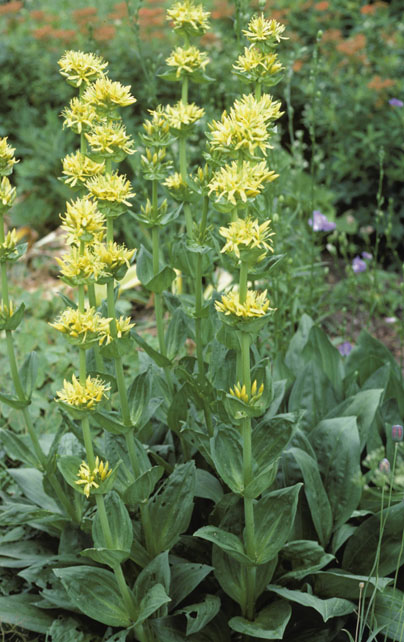
Gentiana lutea
Gentiana makinoi
• blue
• midsummer to early fall
• 18–24 in. × 6–12 in.
• sun, part shade
• Z3–7
Royal blue gentian. Mountains of Japan. Upright perennial with semi-evergreen, dark green, ovate leaves. Intensely blue, 2-in.-long flowers borne in the upper leaf axils of the stems; never fully open, retaining a close-ended tubular shape like that of a Christmas tree light bulb. Requires an acid, humus-rich, moist but well-drained soil. Generally pest and disease free, but attractive to deer.
Encourage a more compact, less sprawling habit by pruning stems back by half in late spring to early summer. This species contributes a bright note of color to late summer borders, and combines well with acid-loving shrubs such as blueberries and rhododendrons. Very attractive as a cut flower.
‘Marsha’ has blue-purple flowers and is compact, to 20 in.; a good choice for containers.
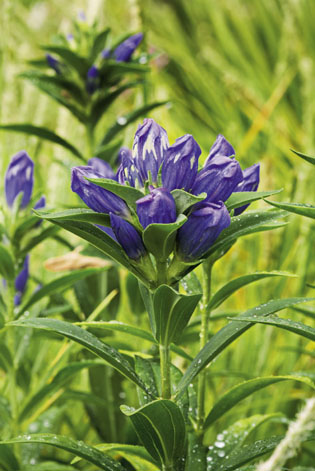
Gentiana makinoi ‘Marsha’
‘Royal Blue’ grows to 24 in. bearing royal violet-blue flowers.
Gentiana scabra
• blue
• late summer to early fall
• 6–8 in. × 8–12 in.
• sun, part shade
• Z4–8
Japanese gentian. Japan. Low-growing, evergreen species whose flowers, borne at the stem ends, are bell shaped and a rich, sapphire blue. Excellent for rock gardens, borders, and in open woodlands. Prefers an acid, humus-rich, moist, well-drained soil. Compatible with ericaceous shrubs such as blueberries, heaths and heathers, and rhododendrons.
‘Zuikorindo’ bears deep pink flowers.
Gentiana septemfida
• blue
• mid- to late summer
• 6–12 in. × 12–18 in.
• sun, part shade
• Z4–9
Summer gentian. Caucasus Mountains. Forms a trailing mound of deep green foliage that in summer glows with deep blue, trumpet-shaped blossoms, sometimes with white throats. Easier to cultivate than the fall-blooming gentians, more tolerant of the heat and humidity of the southeastern United States, where it benefits from afternoon shade.
var. lagodechiana has cobalt-blue trumpets. A fine rock-garden plant, suitable for edging or for planting into a retaining wall, and well suited to container cultivation. 4–8 in. Z4–7.
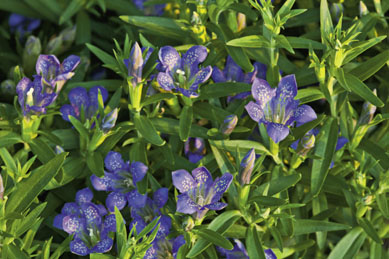
Gentiana septemfida
Geraniaceae
cranesbill
Although cranesbills are often called “hardy geraniums,” it should be noted that they do not belong to the same genus as the popular bedding plants (actually Pelargonium) that most people refer to as “geraniums.”
Whatever you call them, the cranesbills are, typically, undemanding and long lived, requiring little maintenance in return for a vibrant floral display. They tolerate a wide range of soils, though they do not prosper in winter wet. They generally prefer sunny positions, although several species do well in part shade or direct sun for just part of the day. Alpine species and many of the hybrids grow best in full sun and a free-draining soil well enriched with compost.
In general, cranesbills form low mats or mounds of foliage and flowers, although some have a more erect, if sprawling, habit. Long-stemmed basal leaves and leafy, branched, flowering stems combine to present bold masses of handsome and long-lasting foliage. Often aromatic and mostly rounded in outline, the leaves are hand shaped, divided into segments, and often further lobed and toothed along the edges. Clusters or pairs of five-petaled flowers in white, pinks, purples, blues, violets, and dark maroon mostly bloom above the foliage mass. The beak-like fruits ripen, then dry and split to release their seeds.
Rabbits and deer seldom bother cranesbills, but mildew can be a problem, especially among plants suffering from drought.
Species easily propagated by seed sown as soon as it is ripe. Hybrids and cultivars must be divided, or increased by basal cuttings in spring. Selections with thick fleshy roots strike well from root cuttings taken in fall, and protected over winter in a spot with minimal heat.
syn. G. dalmaticum × G. macrorrhizum
• pink
• late spring to early summer
• 6–12 in. × 18 in.
• sun, part shade
• Z5–8
Cambridge geranium. This sterile hybrid has bright rosy pink or sometimes white, flattened flowers with inflated calyces, on trailing stems. Glossy light green, lobed and toothed leaves, to 3.5 in. across.
‘Biokovo’ has white flowers flushed with pink; red calyces. A single clump may reach 3 ft. across. Red fall foliage. 6–8 in. tall.
‘Cambridge Blue’ (‘Cambridge’) has pale lavender-blue flowers. Makes an excellent groundcover to 18 in. across. 8 in. tall.
‘Karmina’ (‘Biokova Karmina’). Vibrant rosy flowers from late spring into summer. Aromatic foliage provides red fall color. 6–10 in. tall.
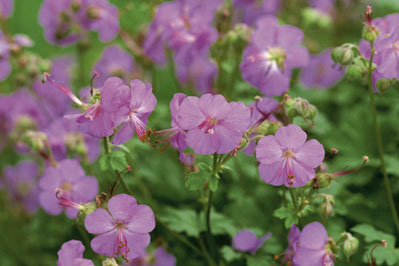
Geranium ×cantabriense ‘Karmina’
Geranium cinereum
• pink
• late spring to early summer
• 4–6 in.
• sun, part shade
• Z5–9
Grayleaf cranesbill, ashy cranesbill. Pyrenees Mountains of southern Europe. Often grown in rock gardens, grayleaf cranesbill makes low, evergreen rosettes of deeply divided, grayish leaves, about 2 in. across, each of the five to seven segments further lobed. Clusters of upward facing, 1-in., white or pale pink flowers, often etched with purple. Demands free drainage. Provide light afternoon shade in hot areas; best in cooler climates.
‘Ballerina’ has purplish red, 2-in. flowers veined with dark pink, with a maroon eye. Grayer foliage than the species. Long blooming. 4–6 in. Similar, but smaller ‘Laurence Flatman’ has darker-colored flowers. 3–6 in. tall.
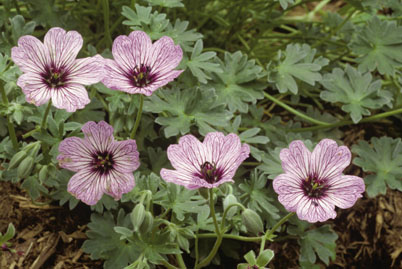
Geranium cinereum ‘Ballerina’
‘Purple Pillow’ has dark-veined, purplish red flowers over a mound of gray leaves. 6 in. Z3–8
‘Splendens’ has screaming magenta flowers, striped and centered with purple. Dramatic in rock gardens. 8 in. Z4–8.
Geranium endressii
• pink
• early summer to early fall
• 15–18 in. × 18 in.
• sun, part shade
• Z4–7
Endress’s cranesbill, French cranesbill. French Pyrenees. Mounding clumps of glossy deep green, deeply divided leaves. Long-blooming, deep pink, cup-shaped flowers; cut back hard after the first flush to encourage further bloom. Shade from intense sun. Reliable as filler in flower borders, perhaps to replace dormant spring ephemerals. Tolerates dry shade.
‘Wargrave Pink’ (syn. Geranium ×oxonianum ‘Wargrave’s Pink’) has larger flowers, often veined with deep pink. Butterflies, bees, and birds seem to love it. Seeds about in good conditions. 18–24 in. Z3–8.
Geranium himalayense
syn. G. grandiflorum, G. himalayense var. meeboldii, G. meeboldii
• violet-blue
• late spring to late summer
• 1–2 ft. × 1.5 ft.
• sun, part shade
• Z4–10, HS
Himalayan geranium. Himalayan Mountains. Masses of 2-in.-wide, white-centered, intensely blue flowers, above dense mounds of lobed, 4-in. leaves. Appropriate for beds, borders, and beneath shrubs, or as a dense groundcover. Drought tolerant; excellent in dry and coastal climates, but not in those with summer heat and humidity.
‘Baby Blue’ has violet-blue, 1.5-in. flowers, white centered and veined with purple. Long blooming till midsummer. Red and gold fall color. 12 in. Z4–8.
‘Birch Double’ (‘Plenum’) has ruffled, fully double, lilac-blue, 1- to 2-in. flowers till midsummer. Good groundcover, especially on the edge of woods, and in containers. 18–24 in. Z4–7.
Geranium macrorrhizum
• cerise
• spring
• 15–18 in. × 18 in.
• sun, part shade
• Z4–8
Bigroot geranium, Bulgarian geranium. Southern Europe, particularly Bulgaria. Easy to grow, tolerates most conditions including dry shade (even under maples). Large, sticky, lobed, light green leaves, 4–8 in. across; soft to the touch, highly aromatic, vibrant red and maroon fall color. Flowers flattish, usually a deep cerise with dark red, inflated calyces, and prominent red stamens. Spreads by succulent underground stems.
‘Bevan’s Variety’ is a superior groundcover for shaded places. Deep magenta flowers accented with red calyces bloom from spring to late summer. 12 in. Z5.
‘Ingwersen’s Variety’. A superior cultivar with very pale pink flowers. 12–18 in.
‘White-Ness’ (‘Snow Sprite’), collected from the slopes of Mt. Olympus. Marble-white flowers and stamens, pale green foliage. This is worth looking for. 8–10 in.
Geranium maculatum
• pink
• spring
• 1–2 ft. × 1 ft.
• part shade, shade
• Z3–8
Spotted geranium, wild geranium, wood geranium. Woodlands and clearings of eastern North America. This slight, clump-forming woodlander bears clusters of upward-facing, saucer-shaped, 1.5-in. flowers in varying shades of pink, over pairs of deeply lobed and toothed stem leaves. Seeds may be ejected from dehiscing fruits more than 20 feet. Pest and disease free, but not the showiest of the genus. Attractive to butterflies; appropriate for native plant and wild gardens.
‘Espresso’ has dramatic non-fading, reddish brown leaves beneath pink flowers. Excellent as a groundcover, especially for dry places.
f. albiflorum is a white-flowered form.
Geranium ×magnificum
syn. G. ibericum × G. platypetalum
• violet-blue
• late spring to early summer
• 18–24 in. × 24 in.
• sun, part shade
• Z4–8
Showy geranium, purple geranium. Of garden origin. Sterile, vigorous, with abundant bloom. Soft, divided basal leaves, to 6 in. wide. Vivid 1.5-in., violet-blue flowers veined with purple. Mass along pathways and border edges, or use as a focal point in large rock gardens.
Geranium ×oxonianum
syn. G. endressii × G. versicolor
• pink
• spring
• 1–2 ft. × 2 ft.
• sun
• Z4–8
Hybrid geranium. Of garden origin.
‘A. T. Johnson’ has dark-veined, silvered pink flowers. Shear after bloom time to promote a possible second crop. Long blooming. Light green, lobed foliage, semi-evergreen in mild climates. 12–18 in. ‘Rose Clair’ and ‘Claridge Druce’ are similar.
‘Bressingham’s Delight’. Soft pink flowers from spring to fall. Deeply lobed, rounded leaves. 1–1.5 ft. Z5–8.
‘Katherine Adele’ has very pale pink flowers 0.75 in. across veined with purple. Leaves are marked with bronze in the centers. A seedling of ‘Walter’s Gift’. 15 in. tall.
Geranium phaeum
• maroon
• late spring to early summer
• 18–24 in. × 12 in.
• sun, part shade
• Z3–7
Mourning widow, dusky cranesbill. Native to damp meadows of Europe. Erect stems rise from thick roots that ensure survival during drought. Deeply divided leaves, 4–8 in., are spotted with purple at their base. The unusual pendent, almost black but variable, 0.75-in. flowers are more curious than showy, with pointed, slightly reflexed petals and strongly exserted stamens.
‘Album’. Flowers are white or faintly pink blushed.
‘Lily Lovell’ has large, purple-mauve flowers to 1.5 in. across, and light green leaves. ‘Raven’ is a selection with unblotched, pale green foliage. 18 in.
‘Samobor’ has deep burgundy flowers above variably marked purple leaves. May self-seed. Shear after bloom for fresh foliage. 18 in. Z6–8.
Geranium pratense
• white, blue, violet
• late spring to midsummer
• 24–36 in. × 24 in.
• sun, part shade
• Z5–7
Meadow cranesbill. Northern Europe, Asia. Crowded inflorescences of blue, violet-blue, or white, saucer-shaped flowers, 1–2 in. across. Deeply divided leaves are jaggedly lobed and toothed. May need staking, especially in warm climates. Seeds freely. Prefers acid soil but tolerates lime.
‘Laura’ has masses of sterile, double, white flowers. Very long blooming. Mounds of cut leaves; suitable for cottage gardens or borders. 24 in.
‘Midnight Reiter’. Deep burgundy foliage, non-fading, dark lilac flowers. A gem for plant collectors, selected from the Pacific Northwest. Appropriate for rock gardens and troughs. 6–8 in. × 12–16 in. Z5–7.
‘Plenum Violaceum’ is sterile, with rosette-like, 1-in., double, deep violet flowers, centered with dark purple. Clumps of divided, irregularly lobed, and toothed leaves rise from stout, fleshy roots. 18 in. Z3.
Geranium renardii
• white
• late spring to early summer
• 1 ft. high and wide
• sun, part shade
• Z6–8
Dwarf cranesbill. Caucasus Mountains. Low clumps of wrinkled, grayish leaves to 4 in. across. These are as soft as a kitten’s ear, and are split halfway into blunt, barely lobed divisions. The white or lavender-flushed, 1-in. flowers cluster in dense umbels, but bloom is sometimes sparse. Grown for its a wonderful foliage. Lovely in rock gardens, and where soil is poor.
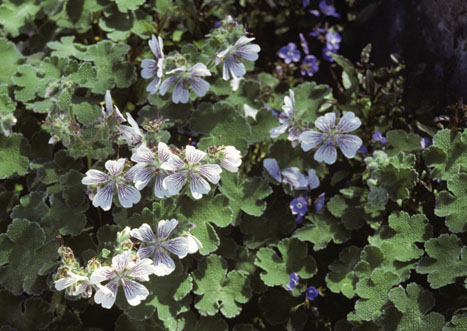
Geranium renardii
syn. G. endressei × G. traversii
• pink, magenta
• summer
• 10–12 in. × 24 in.
• sun, part shade
• Z6–8, HS
Cranesbill. Of garden origin. Long, trailing, branching stems bear deeply divided, gray-green leaves 2–4 in. across. Funnel-shaped, dark-veined, bright pink or magenta flowers, 1.5 in. across, and with notched petals, bloom in summer.
‘Mavis Simpson’ sports 1-in.-wide, light pink flowers with cream eyes and purple veins. 18 in.
‘Russell Pritchard’ bears intense magenta flowers above lobed and sharply toothed, grayish green leaves. 9 in.
Geranium sanguineum
• magenta
• spring
• 9–12 in. × 12 in.
• sun, part shade
• Z4–8
Bloody cranesbill. Europe, northern Turkey. Dense, clumping perennial with far-reaching rhizomes. Few basal leaves; deeply divided into several segments, dark green, 2- to 4-in. stem leaves are seldom toothed. Good fall color in sun. Abundant upward-facing, cup-shaped, vibrant magenta, 1.5-in. flowers with notched petals, purple veining, and white eyes that face upward.
‘Album’ has pure white flowers; a loose billowy habit. 18 in.
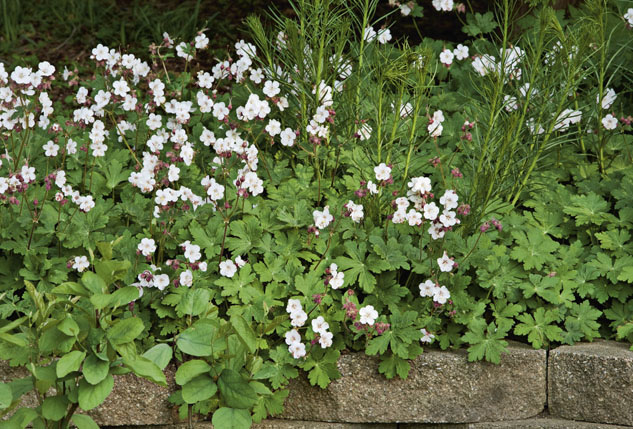
Geranium sanguineum ‘Album’ and Amsonia hubrichtii make good bedfellows
‘Alpenglow’ displays bright reddish rose blooms on clumps 8 in. tall and to 24 in. across.
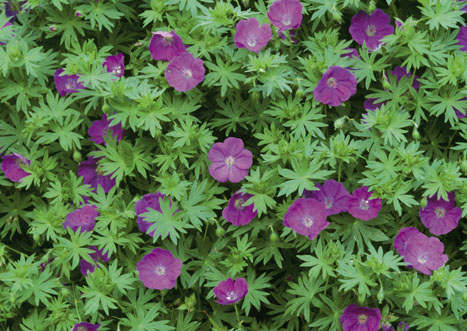
Geranium sanguineum ‘Alpenglow’
‘Cedric Morris’ has slightly softer deep pink, 1-in. flowers; long blooming. To 24 in.
‘Max Frei’. The reddish purple flowers attract butterflies in summer. Fine groundcover with good fall color. Cut back to revitalize the plant if foliage becomes shabby. 6–9 in.
var. striatum (syn. Geranium sanguineum var. lancastriense, G. sanguineum var. prostratum), striped cranesbill, has light pink flowers with a deeper pink eye and darker veining. Excellent as a groundcover, edging, or a rock garden plant. 4 in. ‘Splendens’ is taller with similar flowers to 1.75 in. across. 18 in. Do not confuse with shorter G. cinereum ‘Splendens’.
Geranium sylvaticum
• pink, white, violet
• mid- to late spring
• 1–2 ft. high and wide
• part shade
• Z5–8
Wood cranesbill, woodland cranesbill. Damp meadows of Europe, particularly Iceland, northern Turkey. Early blooming, with usually purple-violet (sometimes pink or white), white-eyed, 1-in. flowers appearing with tulips and late daffodils. Deeply cut, roundish leaves, 6–7 in. across.
‘Mayflower’. Mats of deeply cut leaves; light blue-violet, 1.5-in. flowers, white at the base. 2–2.5 ft.
Geranium wallichianum
• pink
• early summer to early fall
• 9–12 in. × 18 in.
• sun, part shade
• Z4–8
Wallach’s geranium. Northeastern Afghanistan to Kashmir. Trailing, non-rooting stems make this prostrate geranium easy to control. Scrambling and weaving through taller plants or tumbling over walls or rocks, this species and its cultivars makes a showy splash of color. Pairs of somewhat wrinkled, marbled, and coarsely divided leaves measure 2–6 in. long. White-eyed, purple-veined, flattish, 1- to 1.5-in. flowers are deep pink, purple, or blue.
‘Buxton’s Variety’ (‘Buxton’s Blue’). Superior and more compact than the species. Purple-veined, brilliant blue flowers accented with a central white halo. Sprawling carpets of slightly mottled leaves. Perfect at the front of beds and borders, perhaps backed by dark coleus, Coreopsis ‘Moonbeam’, or Salvia ‘East Friesland’.
‘Crystal Lake’ has glowing crystal blue flowers prominently etched with dark purple veins. Palm-shaped, marbled foliage. Long blooming and easy care. 18 in. Z5–9.
Other Notable Cultivars
‘Ann Folkard’. A superior hybrid with deeply cut, yellowish green foliage on trailing stems that scramble and weave through sturdier companions. Rich magenta flowers are punctuated with a black eye. Best in cool-summer regions in part shade. 8 in. × 3–4 ft.
‘Brookside’ is very long blooming with bowl-shaped, white-eyed, sapphire-blue flowers from spring into midsummer; it repeats as weather cools. Cut back after the first flush of bloom. Heat tolerant. Good fall foliage color. 12–18 in. Z5.
‘Cheryl’s Shadow’ develops a slowly spreading, compact mound of dark maroon foliage that remains attractive all season. Light pink flowers in spring. 6–10 in. Z7–10.
‘Johnson’s Blue’ has 2-in.-wide, periwinkle-blue flowers. Finely cut leaves become red and gold in fall. Cut back after the first flush. Slightly sprawling (more so than ‘Rozanne’) but a good weaver. 18 in. Z4–10.
‘Nimbus’. Possibly superior to ‘Johnson’s Blue’. Violet-eyed, lavender-blue flowers above mounds of dissected leaves. Good in containers, coastal gardens, and for edging beds, borders, and paths. 20 in. Z4–8.
‘Orion’ is a seedling of ‘Brookside’. Abundant large, lilac-blue, purple-veined flowers all summer above finely dissected foliage. 18–24 in.
Rozanne (‘Gerwat’; syn. Geranium wallichianum ‘Buxtons Variety’ × G. himalayense) is certainly among the best of the hardy geraniums for beds and borders. Very long blooming with cupped, brilliant violet-purple, white-eyed flowers, to 2.5 in. across. Good-looking foliage. Heat tolerant. PPA Perennial Plant of the Year for 2008. Strikingly similar ‘Jolly Bee’ may be a synonym. 18–24 in. Z5–8.
Asteraceae
African daisy, transvaal daisy
Their exceedingly long vase life makes these vibrantly colored daisies favorites among florists, but gerberas are far less common as garden plantings. One reason is their sensitivity to frost—in most of North America, these perennials must be used as summer annuals. Still, gerberas make superior, long-lasting pot and container plants, and are perfect for decorating decks and patios through the summer months.
African daisies require a position with full sun and well-drained soil. Keep the soil evenly moist but not wet. When grown in containers, they benefit from monthly fertilization.
Extensive breeding programs have developed for the nursery and cut flower trade, mostly derived from Gerbera jamesonii. This has resulted in a slew of strains and series, selected for compact growth, length of bloom time, bloom size, tolerance for cold or inclement weather, and leaf size as well as foliage form and color intensity. The hybrids are correctly called G. ×cantabrigiensis.
Gerberas are susceptible to attack from aphids, leaf miners, and white flies, as well as root rot, molds, and mildews, especially where air circulation is poor. Protect from slugs and snails. Resistant to deer.
Plants can be started from seed (fresh seed germinates easily) or by basal cuttings, which root readily in summer.
Gerbera jamesonii
• all except blue
• late spring to late summer
• 12–18 in. × 24 in.
• sun
• Z8–12
Barberton daisy, transvaal daisy, gerbera daisy. Southern Africa. Solitary daisy flowers borne on naked but hairy stems rising from deep-rooted clumps of basal foliage. Petioled leaves are more or less spoon shaped, rounded at the top, and deeply lobed below, about 10 in. long. Flowers 3–5 in. across, usually with a double outer row of brightly colored, rounded or pointed ray flowers (petals) with a center of disk flowers often of a contrasting color. Fancy forms are available that have extra rows of petals, or are anemone centered, dahlia-like, or even similar to pot marigolds. Some of the flower forms are delicate and charming; others tend to be garish and even slightly vulgar. In the garden they mix well with clivias, agapanthus, mesembryanthemums, and low grasses. Barberton daisies resent disturbance and should be planted, not too deeply, in their permanent sunny positions. Deadhead to the base of the stem, for neatness and to encourage further bloom.
Californian Giants are all single in yellow, oranges, reds, and pinks. 20–24 in.
Festival Series has compact, small-leaved plants with 3.5-in.-wide flowers in white, yellows, rosy pinks, and scarlet. 10 in.
Mega Revolution Series makes bushy plants bred for larger containers. Large flowers in pastel colors; orange, yellow, and pink flowers are dark centered, as in ‘Orange DC’.
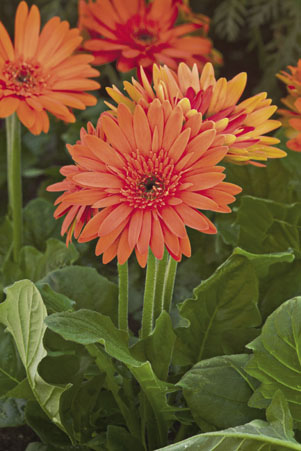
Close up of Gerbera jamesonii ‘Orange DC’ flowers
Parade Series may have single or double flowers in reds, pinks, and yellows.
Rainbow Mix. Flowers in all shades except blue, 4–5 in. across. 16–18 in. tall.
Rosaceae
avens, Grecian rose
If you are looking for a show stopper, you won’t find it among the geums; what you will find, though, are reliable, low-maintenance, and consistently rewarding perennials, real workhorses that combine attractive foliage with bright and long-lasting blooms.
Geums are closely related to potentillas, and like their kin they make useful fast-growing groundcovers. The medium green leaves are fuzzy, usually lobed, and borne typically in neat, clumping mounds. The flowers are medium sized, usually 1.5 in. or so in diameter, cup shaped, and most often composed of single rounds of petals; many of the cultivars and hybrids bear showier double or semi-double flowers. The colors run to bright oranges and reds.
Due to their naturally compact, mounded habit, geums are handy for lending substance to the front of a border. Here they complement more vertical plants such as dwarf irises, delphiniums, and perennial salvias. Their bright blossoms are particularly striking when the plants are massed. Although the main period of bloom is from late spring through early summer, these plants often rebloom intermittently if deadheaded. Geums are also a good source of cut flowers.
Intolerant of the combination of heat and humidity, geums prefer a moist but well-drained soil—they adapt well to rock gardens but do not persist long on dense clays and don’t tolerate wet soils in wintertime. Rarely troubled by pests and diseases; deer and rabbit resistant.
Divide established plants every three years or so in fall or spring to help maintain plant vigor and increase your stock. Plants can also be started from seed, although most species hybridize promiscuously and character of seedlings is unpredictable.
Geum coccineum
• red
• late spring to early summer
• 12–18 in. × 9–12 in.
• sun, part shade
• Z5–7, HS
Avens. Balkans. Forms a 6-in. mound of hairy, irregularly lobed leaves consisting of five to seven leaflets; evergreen in the warmer parts of their range. Five-petaled, brick-red flowers borne on wiry, branching stems that rise several inches above the basal foliage mound. Deadheading encourages rebloom in cool-summer regions; where summers are hot the plants benefit from afternoon shade. Leave some flowers on the plant to serve as a source of the attractive, fluffy seedheads that follow.
‘Borisii’ grows to a height and spread of 6–12 in.; orange flowers.
‘Cooky’ is 6–12 in. tall and spreads 6–9 in.; brilliant orange flowers with orange-yellow stamens. Foliage persists in spite of summer heat.
‘Koi’ has bright orange flowers above a compact, 4-in. mound of glossy green leaves. 8 in. Z4–7.
Geum quellyon
syn. G. chiloense
• yellow, orange, red
• late spring to early summer
• 2 ft. high and wide
• sun, part shade
• Z5–9, HS
Chilean avens. Chile. Forms a cushion of fuzzy, dark green, strawberry-like leaves that are semi-evergreen or even evergreen in the warmer parts of the plant’s range. Branched stems carry the single, 1.5-in.-wide, cup-shaped flowers; those of cultivars are usually semi-double or double, and may be slightly larger. Prefers a rich, well-drained, neutral to slightly acid soil. Short lived.
‘Georgenberg’ has soft orange flowers with hints of apricot, peach, and salmon. Repeat bloomer. 15 in.
‘Lady Stratheden’ (‘Goldball’) has yellow, semi-double flowers. 16–24 in.
‘Mrs. J. Bradshaw’ (‘Feuerball’, ‘Fireball’) is a profuse bearer of large, orange-yellow, semi-double flowers. Leaves turn burgundy color in fall. 16–24 in.
‘Red Dragon’ bears scarlet, double flowers. 16–20 in.
‘Starker’s Magnificum’ has double, apricot-tangerine flowers. 15–18 in.
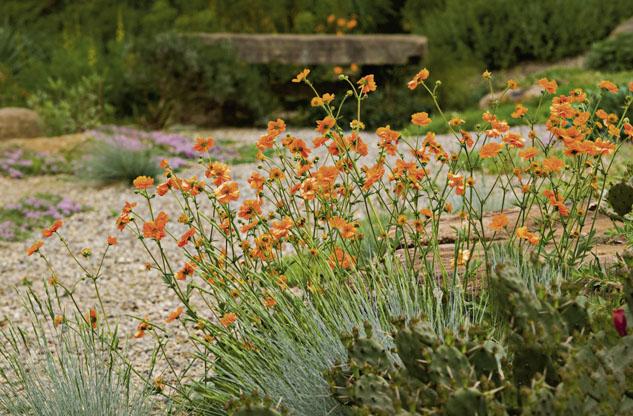
Geum ‘Starker’s Magnificum’ shares a spot with Festuca glauca ‘Elijah’s Blue’ and prickly pears
Geum rivale
• orange, purple, white
• late spring to early summer
• 6–24 in. × 6–18 in.
• sun, part shade
• Z2–7
Purple avens, water avens, chocolate root. Bogs and wet meadows across northern North America and south into New Mexico, as well as northern Europe and central Asia. The North American population produces large plants with small flowers, whereas the European and Asian plants are more compact with much larger flowers; the blooms of both are nodding and bell shaped, pinkish apricot in color. Leaves pinnate, measuring to 8 in. long and 2 in. across; basal leaves have five to seven leaflets, the upper ones have three. Individual leaflets are coarsely serrated, slightly hairy, rough textured, and medium green; terminal leaflet is sometimes divided into three lobes. Flowers are borne in cymes on dark purple, hairy stems; individual blooms measure 0.75–1 in. across, and are composed of five dull red to pale purple petals and five dark purple sepals. Prefers a consistently moist, neutral to mildly acid soil, tolerates garden soils with more than average moisture. Best suited for growing in bog gardens or at the margins of water gardens.
‘Flames of Passion’ bears semi-double, scarlet-red flowers from spring well into summer, followed by feathery prairie smoke–like seed pods. 12 in. × 18 in. Z5–9.
‘Leonardii’ (‘Leonard’s Variety’) blooms with copper-pink flowers. 8–12 in.
‘Lionel Cox’ has yellow-tinged pink flowers. 12 in.
‘Marika’ is compact with creamy-peach flowers. 9–12 in. tall.
‘Snowflake’ is compact, to 9 in., with pure white flowers. Holds its flowers outward rather than nodding as in ‘Album’.
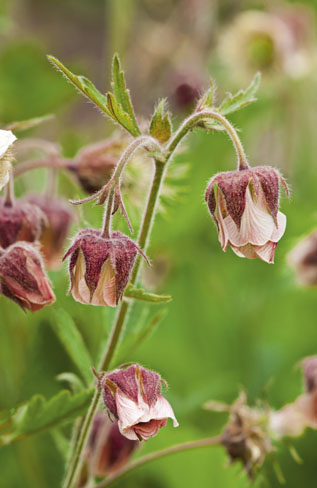
Geum rivale
Geum triflorum
syn. Erythrocoma triflora
• reddish pink, purple
• late spring to early summer
• 6–18 in. × 6–12 in.
• sun
• Z3–7, HS
Prairie smoke, purple avens. Prairie native, Pacific Coast inland as far as New Mexico and northward into Canada, east across the upper Midwest into New York. Hairy, rhizomatous plant with pinnately divided, fern-like, green leaves with 7 to 19 leaflets. The reddish pink to purplish, nodding, globular flowers (usually borne in clusters of three) are attractive but the distinctive beauty of this plant lies in the fruiting heads that follow: as the flowers age, the protruding styles lengthen to form a cluster of 2-in.-long, feathery, gray tails, giving the whole the look of a miniature feather duster.
Prefers a dry, well-drained soil in a sunny location, though it benefits from some afternoon shade in hot-summer regions. Tolerant of moist but well-drained soils, though likely to prove short lived in such conditions. Typically free of pests and problems. This soft-textured plant is effective at the front of a border, but is most striking when massed in a meadow or prairie setting.
Other Notable Cultivars
‘Banana Daiquiri’, an introduction of Illinois’s Intrinsic Perennial Gardens, has semi-evergreen leaves below long-stemmed, semi-double, pale yellow flowers. Beautiful, slightly frilly blooms. 18–24 in. × 15–18 in. Z4–8.
‘Blazing Sunset’ grows 18–24 in. high and wide, with double, scarlet flowers 50 percent larger than those of other geums. Flowers all summer. Z5–7, HS.
‘Cherry Cordial’ is compact, with single, red blossoms followed by fluffy seedheads. 9–12 in. Z5–7, HS.
Rosaceae
Bowman’s root, Indian physic
Another victim of botanical reclassification, this plant also goes by the name of Porteranthus; gardeners will find it listed under both names in catalogs and nurseries. Whatever you call it, Bowman’s root is native to central, eastern, and southeastern North America, where it grows in open woodlands and clearings. Native Americans valued Bowman’s root for its medicinal properties, especially as an emetic; hence, it is sometimes colloquially called Indian physic.
A clump-forming plant, Bowman’s root has wiry, reddish stems, erect and branching. Its trifoliate leaves are wrinkled and sharply toothed, each lance-shaped leaflet measuring as much as 4 in. long. The charming, dainty panicles of white or sometimes pink flowers flutter in summer breezes to provide an element of movement in the garden. Moist soil and part shade are ideal for this unassuming plant. Seldom browsed by deer.
Good companions for Bowman’s root include other woodland perennials such as ferns, heucheras, Solomon’s seal, and bugbanes. Gillenia is perfect for native plant and woodland gardens, as well as among shrubs and in informal areas.
Divide in spring or fall or start from seed.
Gillenia trifoliata
syn. Porteranthus trifoliatus
• white
• early summer
• 2–4 ft. × 3 ft.
• part shade
• Z4–7
Bowman’s root, mountain Indian physic, American ipecac. New York to Georgia. Long overlooked as a subject for American gardens, this wonderful native is now becoming better known. Strong, branching, mahogany-red stems gracefully carry masses of white, five-petaled, butterfly-like flowers, 1–1.5 in. across, with persistent red calyces on red petioles. Handsome foliage seldom marred by pests or diseases, ignored by deer. Turns reddish bronze in fall. Persistent seedheads provide winter interest. Best in slightly acid, well-drained, moist soils rich in organic matter. Tolerates dry shade if well mulched and planted into a few inches of compost. Prefers a partly shaded position; protect from strong midday sun. Useful as filler in beds and borders, as well as in floral arrangements. Gillenia stipulata (syn. Porteranthus stipulatus) is similar but with fewer-flowered panicles of bloom; it is better suited to hot and humid gardens.
‘Pink Profusion’ has clear pink flowers on stems 2–3 ft. Z4–9.
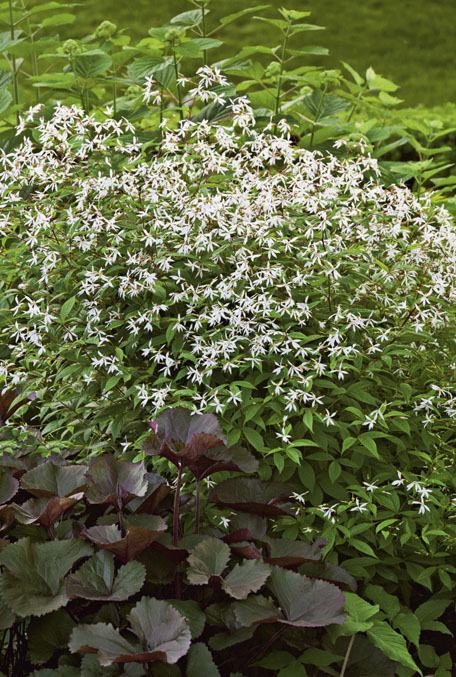
Gillenia trifoliata contrasts airily with Ligularia dentata foliage
Ranunculaceae
Japanese wood poppy
This genus includes but a single species, Glaucidium palmatum. This beautiful Asian buttercup thrives in woodland conditions in cool climates. It does not tolerate combined high temperatures with humidity and will usually fail south of zone 7 on the US East Coast. They are successful, however, in the dry heat of southern California.
For best results, give plants a moderately acid to neutral soil that drains well but is consistently moist; do not let plants dry out between watering. A gem for woodland gardens; combine with other woodland shade lovers, including cypripediums, trilliums, anemones, erythroniums, and May apples.
Glaucidium palmatum
• mauve
• late spring to early summer
• 18–24 in. × 15–18 in.
• part shade, shade
• Z3–9, HS
Japanese wood poppy. Forests and alpine meadows of northern Japan. Forms clumps of bright green, paired, maple-like leaves, that are divided into 7 to 11 irregularly toothed lobes. Exquisite large (to 3-in.-wide), cup-shaped, poppy-like flowers range in color from rose-pink to pale mauve, and are borne singly on thin stems.
var. leucanthum has white flowers.
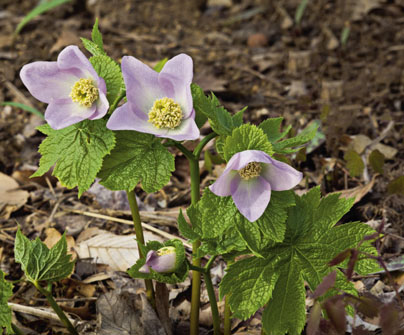
Glaucidium palmatum
Papaveraceae
horned poppy
This plant achieves the perennial equivalent of a hat trick, scoring in the matter of foliage and fruits as well as flowers. The flowers, borne singly in leaf axils and at stem tips, are classic poppy, with bright, tissue-paper petals. Many gardeners value the handsome, blue-green foliage more highly; the waxy covering that gives the divided leaves their glaucous sheen actually evolved as a defense against sunburn. The added late-season bonus is the intriguing curved seedheads that follow the flowers.
This plant does come with a warning, however: it has the poisonous roots and yellow sap typical of members of the poppy family. Yellow horned poppy contains an alkaloid, glaucine, that has the same effects as codeine; this is very potent and was used in Viking times by Scandinavians, and more recently has been employed as a cough suppressant, anti-inflammatory, and analgesic. As a result of this toxicity, deer do not browse these plants.
Grow in full sun on poor to average, well-drained soil. Horned poppies are very deep rooted and resent disturbance. Start them from seed sown in containers to minimize transplant shock.
Glaucium flavum
• yellow
• summer
• 12–36 in. × 18 in.
• sun
• Z6–9
Yellow horned poppy. Coastal regions of the Canary Islands, Britain and Europe, and the Mediterranean. Short-lived perennial often grown as a biennial. Naturalized in some areas, notably coastal regions, where it can be found growing on the beach among sand and pebbles. Rosette-forming, hairless, waxy, blue-green leaves are divided into toothed, wavy lobes, the terminal one broader than the rest. In summertime oval, bristly buds open into charming bright yellow or orange flowers about 2 in. across, with four petals surrounding a central boss of stamens. They set copious amounts of tiny black seeds and self-sow freely, especially into gravel or poor, dry soils. Well adapted to dry regions. Biennial red horned poppy (Glaucium corniculatum) is similar but with crimson to orange flowers blotched with black at the base of each petal; it grows to 12–16 in.
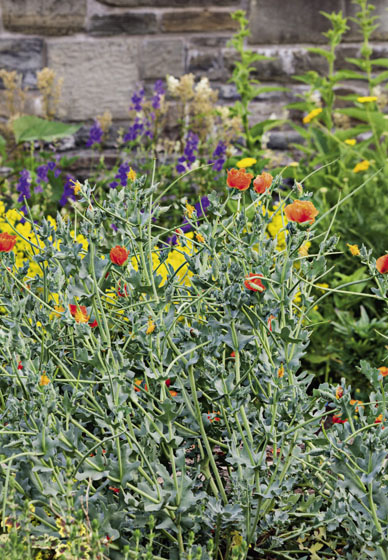
Glaucium flavum
Plantaginaceae
globe daisy
Best known to rock garden aficionados, globe daisies deserve a wider application. They are excellent in troughs and can be tucked into small cracks in walls or between pavers, as well as serving as slow-growing groundcovers. In spite of their common name, they are not related to the daisy family; formerly they were given their own taxonomic family: Globulariaceae.
Mostly ground hugging, globe daisies produce mats of good-looking, leathery, evergreen leaves topped by dense, rounded heads of flowers borne on perky stems. The creeping stems, woody at their base, root where they touch soil, but this colonization is easily controlled. A sharp, well-drained soil is essential for most species, as is a sunny spot. Alkaline soil is preferable; dress with lime chips where soil tends to be acid. Tolerates droughty conditions well. Deadhead for neatness after bloom time.
Globe daisy is a larval food for some species of butterflies and moths. It is resistant to deer and gophers, but may be attacked by slugs.
Difficult to divide; heeled cuttings (softwood stems with a piece of woody tissue attached) can be separated in summer and then rooted. Seeds need a chilling for two months before they will germinate.
Globularia cordifolia
• blue
• spring
• 2–5 in. × 12 in.
• sun, part shade
• Z5–8
Heart-leaved globe daisy. Scree and rocky mountainous areas of the Mediterranean region. Makes tight rosettes of evergreen, shiny, spoon-shaped leaves 1–2 in. long and notched at the tip. Flower stems shrouded in tiny flattened leaves poke their heads above the foliage in late spring topped with 1.75-in., powder-puff heads of lavender flowers. Most attractive as a slow-growing groundcover.
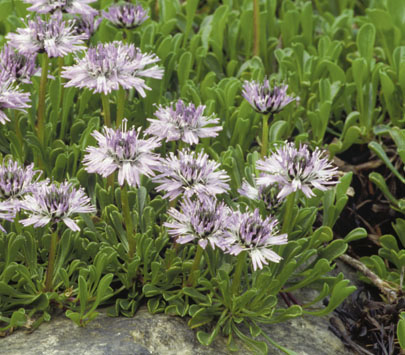
Globularia cordifolia
Globularia meridionalis
syn. G. bellidiflora, G. cordifolia subsp. bellidiflora, G. cordifolia subsp. meridionalis
• blue
• summer
• 6–12 in. × 12 in.
• sun, part shade
• Z5–7
Globe daisy. Southeast Alps and Mediterranean region. Mats of lustrous evergreen, 3-in. leaves usually lance shaped and rounded at the tips. In summer upright stems clothed with smaller leaves rise to 12 in. or so, topped with showy button-like, globular heads of small flowers in varying shades of lavender-blue. Low dianthus, lewisias, and other unthirsty perennials are excellent companions.
Plumbaginaceae
Tatarian statice
Of the 20 or so species of Goniolimon, only one has found a place in ornamental gardens. Better known as Tatarian statice or by an alternative botanical name, Limonium tataricum, this plant is closely related to the familiar German statice (L. sinuatum) used in fresh and dried flower arrangements. Formerly they were joined in the same genus but now have been separated on the basis of small botanical details.
Like its German relative, Tatarian statice produces flowers that are good for fresh or dried floral designs and wreaths. For drying, delay harvesting until the flowers are fully open. These flowers also attract butterflies.
Select a sunny place for Tatarian statice, although ideally it should include protection from the intense sun of early afternoon. It thrives in well-drained, average or sandy soils and does especially well in coastal areas where it tolerates salt spray readily. Avoid high-nitrogen fertilizers. Good air circulation is necessary for healthy growth—leave sufficient space between this plant and its neighbors. Tatarian statice is drought tolerant when established; a combination of winter weather and waterlogged soil is likely to prove fatal. In general, this is a low-maintenance, undemanding plant, and one that is seldom browsed by deer or attacked by pests and diseases.
Best propagated by dividing the fleshy roots. Take care when doing so, as the sap may irritate sensitive skin. Can be started from seed also.
Goniolimon tataricum
syn. Limonium tataricum
• blue, pink, purple, white
• mid- to late summer
• 12–18 in. × 24 in.
• sun
• Z2–9
Tatarian statice, German statice, Tatarian sea lavender. Steppes of South Russia, Caucasus, Europe. Basal rosettes of white-spotted, light green, leathery, lance-shaped or oblong leaves that may reach 6 in. long. Tiny, tubular, flaring flowers are borne on wiry, naked stems in wide-spreading, airy clouds 5–6 in. across. Useful as filler in beds and borders, perhaps with bright daylilies, penstemons, and blazing stars, or as tall edging plants.
Gunneraceae
giant rhubarb
“Bold” does not even begin to describe giant rhubarb’s foliage—the individual leaves of some species can measure 6 ft. across, or even more in ideal conditions.
Gunneras require ample moisture and temperate climates. Intolerant of extreme summer heat, they perform best in Oregon, Washington, and southern British Columbia, as well as coastal regions of the Mid-Atlantic and southern New England. To satisfy their thirst for water, they are usually reserved for planting in a bog garden, or the edge of a stream or pool; they also adapt well to container culture if given an extra-large tub or barrel and kept continuously moist, or set into the marginal area of a pool or pond. Soils should be humus and nutrient rich. Evergreen where winters are mild, deciduous where frost is common. Where deciduous, gunneras benefit from a reduction in soil moisture during their period of dormancy and a heavy protective mulch of some material such as straw or pine straw. Gunneras may also be grown in containers in cold-winter regions, and moved indoors in fall for storage in a cool but frost-free location—do not water until moved outdoors again in spring.
Typically pest and disease free where conditions suit. Lends a tropical—even prehistoric—look to a pool or secluded nook. Particularly attractive thickly underplanted with assorted primulas.
Propagate by division, or by seeds soaked for 24 hours in room-temperature water; sow these in a moisture-retentive potting mix, kept slightly warm, and never allowed to dry out; germination takes as much as 30 days. Alternatively, take root cuttings from leafy basal buds in spring.
Gunnera manicata
• pink
• early summer to midsummer
• 6–8 ft. × 10–12 ft.
• sun, part shade
• Z7–9
Giant rhubarb. Cloud forests in mountains of Brazil. Robust and fast growing when well established in a hospitable location. Forms a huge, spreading clump of lobed, rounded, and rough-textured leaves borne on 5- to 8-ft.-tall succulent and fibrous stems. The stems and the undersides of the leaves are spiny, and individual leaves often measure more than 6 ft. in diameter. The tiny, pinkish brown flowers are borne in conical panicles, like pinecones on steroids; these may reach to 40 in. tall and 16 in. across. Partial shade is best where sun is intense; prefers a mildly acid soil pH.
Caryophyllaceae
baby’s breath
Commonly used as filler by the floral industry in arrangements focused on more dramatic flowers such as roses and lilies, gypsophilas can serve a similar purpose in the perennial garden. The airy clouds of small, white flowers that they display through most of the summer furnish a delicate counterpoint to the stronger colors and forms of more assertive blossoms and foliage. Gypsophilas are also useful for filling the gaps left in the garden by early spring bulbs, wildflowers, and summer-dormant perennials, including Oriental poppies, when they retreat back into dormancy in late spring. And, of course, gypsophilas are a handy source of cut flowers.
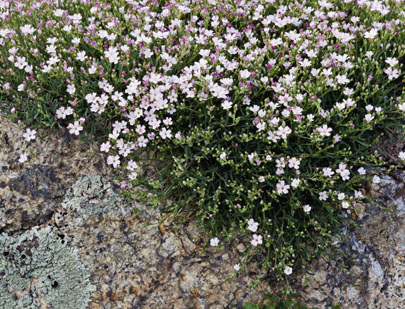
Gypsophila ‘Franzii’
Gypsophila means “gypsum-” or “chalk loving,” and most members of this genus prefer an alkaline soil. Add lime to acid soils, and top-dress with limestone chips in rock gardens. Gypsophilas do best in sunny spots and are generally pest and disease free, although poor drainage may cause root rot. Seldom browsed by deer.
Start seed indoors in winter or outdoors in a cold frame in spring. Root cuttings may be taken from the species in late winter.
Gypsophila cerastoides
syn. G. cerastioides
• white
• late spring to midsummer
• 4–8 in. × 8–12 in.
• sun
• Z3–7, HS
Baby’s breath. Himalayas. Forms a compact mound of small, rounded, fresh green foliage, from which emerge taller, branching stems that carry the small, pink-veined, white, starry flowers. Drought tolerant; attracts butterflies. Evergreen in mild-winter regions. Valuable for rock gardens, sunny banks, edging along pathways, and at the front of sunny borders, or in containers. Intolerant of heat combined with humidity.
• white
• late spring to late summer
• 1–3 ft. high and wide
• sun
• Z3–9
Baby’s breath, chalk plant. Steppes of eastern Europe. Drought tolerant, prefers dryish, well-drained, alkaline soil. Wet soil in winter is likely to prove fatal; otherwise trouble free except for some susceptibility to aster yellows. The gray-green, 4-in. leaves are opposite and lance shaped, sparsely arranged on branching, wiry stems. Cut back after initial flush of bloom in early summer to stimulate further bloom. Propagate named cultivars by rooting tip cuttings taken in spring before flowering begins. Reported as invasive in Washington, Oregon, Colorado, Wisconsin, and Michigan, and has escaped into the wild in many other states—keep an eye on this plant to prevent excessive proliferation.
‘Bristol Fairy’ is a traditional favorite that produces numerous long-lasting, double, white flowers up to 0.25 in. wide. Sparse, lance-shaped foliage. 2–2.5 ft.
‘Rosenschleier’ (‘Rosy Veil’) is a low-growing hybrid of this species with Gypsophila repens. It has pale pink, double flowers. 12–20 in.
‘Viette’s Dwarf’ grows to a height and spread of 1–1.5 ft., with blue-green leaves and double, pink flowers that fade to white.
Gypsophila repens
• white
• early -late summer
• 4–12 in. × 18 in.
• sun
• Z3–8, HS
Creeping baby’s breath. Low-growing European species, commonly 6 in. tall, forms spreading cushions of gray-green, lanceolate foliage. Smothered in early summer with tiny, white, five-petaled flowers. Beautiful groundcover for sunny, well-drained spots, also works well as edging for a path or border, or spilling over the edge of a retaining wall or container. A gem for rock gardens and containers, and for planting into crevices of a south- or west-facing retaining wall, or between flagstones on a sunny terrace. Drought tolerant, but regular irrigation during dry spells in spring and early summer is critical to the flower quality. Difficult in hot and humid gardens.
‘Alba’ is white flowered. 4 in. tall
‘Dorothy Teacher’ has a low, neat habit with soft pink flowers that darken with age. Bluish green foliage. 2 in.
‘Filou Rose’ has a long season of bloom from late spring to late summer. It bears large, bright pink flowers.
‘Fratensis’ (syn. Gypsophila franzii ‘Nana Compacta’) makes a low cushion of blue-green foliage, 2–3 in. high and 6 in. wide, from which emerge wiry stems bearing a wealth of tiny, pale pink flowers. Z4–7.
Zingiberaceae
ginger lily
With their bold, broadly blade-shaped, glossy foliage and flamboyant panicles of butterfly-like flowers, these relatives of culinary ginger impart a tropical lushness to the garden. Many are surprisingly cold hardy, overwintering outdoors successfully as far north as warmer parts of zone 7. Ginger lilies mix well with cannas, elephant ears, and the more cold-tolerant bananas in a faux-tropical patio or court. They also lend height, mass, and color to summertime borders, where they hold their own with dahlias, crocosmias, and daylilies. In regions too cold for them to overwinter outdoors, hedychiums may be cultivated in large containers, sturdy enough to withstand the pressures of the plant’s expansive rhizomatous root system—and then moved indoors as cold weather arrives.
The native range of ginger lilies extends from southeast Asia to the foothills of the Himalayas. A region of monsoon climates, rainfall is seasonal and extended periods of wet weather alternate with periods of drought. In North American gardens, this condition is best imitated by providing plenty of moisture during the growing season and then withholding it from late fall to winter. Provide well-drained, neutral to slightly acid, moisture-retentive soil, well-enriched with organic matter. Keep the soil moist, but not waterlogged when shoots emerge in spring; neglecting this stunts growth and aborts bloom. Apply balanced organic fertilizer regularly to satisfy these greedy feeders. Tolerates full sun in low-light regions; filtered light is best elsewhere.
Hedychiums may be overwintered outdoors in zones 7 and 8. After the first killing frost, cut the plants back almost to the ground, leaving stubs to mark the spot. Cover the crowns with 1–2 in. of composted manure, and top with ground bark for insulation. Specimens planted with poor drainage are unlikely to survive.
Slugs and snails attack the foliage of ginger lilies but are easily controlled; otherwise these plants are usually trouble free, and even deer avoid them. Increase stock by dividing the roots in spring, or start from seed.
Hedychium coronarium
• white
• late summer to early fall
• 4 ft. × 18–24 in.
• shade, part shade
• Z7–11
Butterfly ginger. Himalayas and tropical Asia. Dense heads of 2-in., intensely fragrant, butterfly-like, white flowers. A few buds open daily, starting from the bottom and moving gradually upward. Long blooming well into fall. Most plants sold as Hedychium maximum are actually this species.
Hedychium densiflorum
• orange-yellow
• early to late summer
• 4 ft. × 18–24 in.
• sun, part shade
• Z7–11
Dense ginger lily. Native to the Himalayan foothills. Crowded, 8-in., bottlebrush heads of intensely fragrant, orange-yellow flowers open from the top downward. Less expansive than many of this genus, dense ginger lily forms tightly packed clumps.
‘Assam Orange’. Fragrant, deep orange flowers crowd into 18-in.-long inflorescences. 3 ft. × 4 ft. Z8–10.
‘Stephen’ is also perfect for limited space. Pale orange-yellow flowers, deep orange stamens. 3–4 ft. Z7–9.

Hedychium densiflorum ‘Stephen’
Hedychium gardnerianum
• yellow
• late summer to midfall
• 5–8 ft. × 18–24 in.
• sun, part shade
• Z8–11
Kahili ginger lily is native to Nepal, but has naturalized in Hawaii, where it has proven invasive. Blue-green foliage, with giant, 1- to 1.5-ft. heads of fragrant, gold to pale yellow, 3.5-in. flowers with prominent, protruding, dark orange stigmas.
‘Compactum’ grows to 4–5 ft.
Other Notable Cultivars
Most of these cultivars are hardy to the warmer parts of zone 7.
‘Daniel Weeks’ blooms from early summer to fall; golden-yellow flowers with dark gold throats. 4 ft. tall.
‘Flaming Torch’ produces two flushes of orange flowers; in early to midsummer, repeating in fall. 6–7 ft. tall.
‘Vanilla Ice’ has white-streaked leaves, and fragrant, peach-pink flowers in late summer. 3 ft.
Tai Series, bred by Doyle Smittle, includes many large- and fragrant-flowered hybrids such as ‘Tai Mammoth’. It bears 15-in. panicles of 3- to 3.5-in., fragrant, creamy-yellow flowers with darker throats, from early summer to fall. 6 ft. tall.
Fabaceae
sweet vetch
Sweet vetches are typical representatives of the vetch clan: they sport pinnate leaves arranged alternately on the stem, each with an odd number of toothless leaflets; pea-type, red, purple, white, or yellow flowers cluster in racemes or spikes in the leaf axils. Each bilaterally symmetrical bloom consists of five unequal-sized petals: the biggest at the back is the “standard,” the pair in front on each side are the “wings,” and the pair enclosing the reproductive parts in the middle is the “keel.” They are pollinated by heavyweight, nectar-seeking pollinators, including bees; when they alight on the keel it presses down to reveal the stigma and pollen-laden stamens that brush the insect’s underbelly. Pod-like fruits enclose the seeds. Lateral roots have nitrogen-fixing nodules that release extra nitrogen into the soil, and thus improve the soil for other plants.
Plant in average fertile soil in full sun, where drainage is good. Popular with hunters, who know that sweet vetches are a favored deer food—gardeners should take heed and protect their plantings. Young growth attracts slugs, snails, and rabbits.
Direct sow scarified seed in spring in containers, and protect seedlings from wildlife. Sweet vetches resent disturbance to the long taproots, so transplanting and division are tricky; plant initially in their permanent spot.
Hedysarum coronarium
• red
• spring
• 2–4 ft. × 18–24 in.
• sun
• Z4–9
French honeysuckle, cock’s head, Italian sainfoin. Native to Algeria, Morocco, Tunisia, and Spain. This erect, bushy perennial has long been cultivated in Europe for animal feed and for honey production. The bluish green leaves have 7–15 rounded, 1.5-in. leaflets, hairy on their undersides. Blood red, 0.75-in. pea flowers cluster in dense spikes of up to 35 blooms; these are rich in nectar and very fragrant, attracting bees, butterflies, and pollinating insects like a magnet. Southern plantings need support, but plants grown in cooler climates are more sturdy if given full sun. Cut back after blooming if plants become untidy.
‘Alba’ is white flowered.
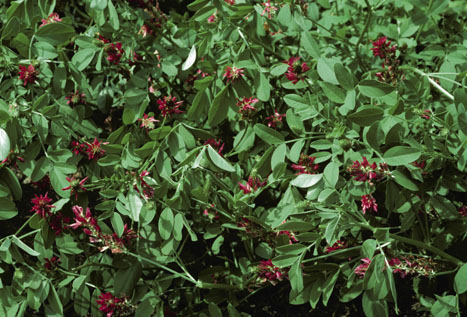
Hedysarum coronarium
Asteraceae
sneezeweed, Helen’s flower
Can sneezeweeds and allergy sufferers share the same garden? Of course they can! These plants are so named not because of their allergenic pollen—sneezeweed flowers are insect pollinated (instead of by wind), and so do not cause hay fever—but rather because their dried foliage was sometimes used as a substitute for snuff tobacco in Colonial America. It should be noted, however, that sneezeweed foliage may irritate the skin of sensitive individuals, and eating any part of these plants may cause intestinal distress.
This fine, clump-forming perennial, a mainstay of summer and fall gardens, has well-branched stems that bear 4- to 12-in.-long, oval leaves. The daisy-like flowerheads are composed of a prominently raised central disk surrounded by broad, wedge-shaped ray petals in yellow, orange, and reddish tones. Bloom time is long, lasting from midsummer to midfall, depending upon the species or cultivar. All make good cut flowers, and are reliable subjects for beds and borders. Fine companions include bluebeards, monkshoods, baby’s breath, catmints, and torch lilies.
Sneezeweeds thrive in average soil that drains well but does not dry out too rapidly. Apply organic mulch to retain soil moisture. Tall selections mostly require staking, especially when grown in exposed positions. Shearing them back to reduce their height by half before midsummer results in more compact, robust growth and more flowers later. Deadhead routinely to extend bloom time.
Pests and diseases are few, although they may fall prey to powdery mildew during dry seasons. Water at ground level during times of drought; thin dense clumps to improve air movement. Deer resistant.
Sow seed of species. Divide cultivars in spring or fall, or take root cuttings in spring. To maintain vigor, divide established plants every two to three years.
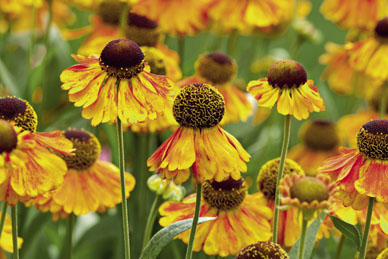
Close-up of Helenium Mardi Gras (‘Helbro’) flowerheads
Helenium autumnale
• yellow, orange
• midsummer to midfall
• 2–5 ft. × 3 ft.
• sun
• Z3–8
Common sneezeweed. Native to eastern Canada and the United States. Stiffly upright, branched and winged stems clothed with 4- to 6-in.-long, toothed, oval to lance-shaped leaves. Flowerheads may reach 2 in. or more across with reflexed, yellow ray flowers, and a prominent, raised, brown disk. Avoid overfertilizing; this causes soft, floppy growth that requires staking. Appropriate for native plant and wildlife gardens.
Helenium bigelovii
• yellow
• early to midsummer
• 1–3 ft. × 1 ft.
• sun
• Z5–8
Bigelow’s sneezeweed, mountain sneezeweed. Native to damp streamsides, marshes, and high meadows in California and Oregon. The lower leaves of this upright, clump-forming perennial are carried on winged petioles; those above clasp the sparse, winged stems. Solitary, 2.5-in. flowerheads, with bright golden-yellow rays and a raised spherical disk, yellow at first but maturing to dark brown, top unbranched stems. Attracts butterflies; a good honey plant. Appropriate for damp native plant and wildlife gardens; soil should not dry out.
‘The Bishop’ has deep yellow flowers with deep brown disks. Compact at 2–2.5 ft. Z6.
Helenium hoopesii
• gold
• midsummer
• 3–4 ft. × 18–24 in.
• sun
• Z3–7, HS
Western sneezeweed, orange sneezeweed. Native to the Rocky Mountain states. Robust clumps of grayish green basal leaves to 12 in. long; upper stem leaves are narrowly lance shaped and become smaller as they ascend. The strong, leafy stems carry clusters of 3-in.-wide flowerheads, with slender, slightly reflexed, golden rays around a darker central disk. Resents southern heat and humidity.
Other Notable Cultivars
There is a multitude of old and new selections and cultivars. This is just a sampling.
‘Butterpat’ has buttery yellow flowerheads, centered with a greenish disk. Erect on strong stems. 4 ft. Z4.
‘Coppelia’ has coppery red ray flowers surrounding a chocolate disk. 3 ft. Z4.
Mardi Gras (‘Helbro’) bears 1- to 2-in. heads of yellow daisies, splashed and speckled with red and orange; cone is tan. 3–4 ft. Z4.
‘Moerheim Beauty’. Deep copper ray flowers surround deep chocolate central disks. Early to late summer. 36 in. Z4.
‘Red Jewel’ is relatively new with dusky red flowers, rays sometimes tipped with yellow, accented with a maroon center. Very long bloom time. 2.5–3 ft. Z4.
‘Short ‘n’ Sassy’ is compact with a tight habit. Brown cone, bright gold and orange rays. 12–18 in.
Cistaceae
sun rose, rock rose
They aren’t roses, but these perennial subshrubs thrive in sunny or partially shaded locations; they handle well-drained rocky or sandy soils with ease. Once rooted into a site, sun roses are very drought tolerant, and their ground-hugging foliage and colorful flowers qualify them as ideal groundcovers for dry sunny banks or rock gardens. They also thrive in hot, drought-prone areas along the edge of driveways or between a sidewalk and the street (sometimes called a “hell strip”). Additionally they can hold their own in more refined surroundings of a sunny border, where they mix well with lavenders, spurges, and oreganos. Beautiful draped over the edge of a retaining wall.
Opposite leaves are oblong or linear, and evergreen, to 1.5 in. long; they vary from soft downy grays to light or bright greens, sometimes with a crinkled texture. The flowers are mostly 1 in. or more across, five petaled, and in the species white, yellow, or occasionally pale pink; many hybrids on the market have extended the color palette to include a range of yellows, pinks, oranges, and reds. These flowers attract bees and butterflies, adding another kind of color to the garden.
Sow seed of species. Take tip cuttings of named cultivars in summer after bloom time. Shearing back plants at that time promotes compact growth, plus it forces out new shoots, an ideal source of cuttings.
Helianthemum alpestre
syn. H. oelandica subsp. alpestre
• yellow
• early to midsummer
• 5 in. × 8 in.
• sun
• Z6–8, HS
Alpine rock rose. Native to the mountains of southern Europe, alpine rock rose forms dense, green carpets with bright yellow flowers. Prefers a gritty soil, low in nitrogen. Not for hot and humid summer climates.
Helianthemum mutabile
syn. H. nummularium ‘Mutabile’
• various
• late spring to early summer
• 6–12 in. × 24 in.
• sun
• Z6–8, HS
Frostweed. Native to the Mediterranean basin. Downy, gray foliage is set off by 1-in., white, pink, rose, red, or yellow flowers. Prolific bloom on suitable sites. Shear back after flowering to encourage rebloom. Provide well-drained, alkaline soil. Easily started from direct-sown seed. This is a useful and attractive cover for dry, sunny spots, and is excellent for borders or containers. Does not tolerate southern heat and humidity. Apply winter mulch in zone 5.
• pink, yellow
• late spring to early summer
• 6–12 in. × 2–3 ft.
• sun
• Z5–7
Rock rose. Native to Europe and Asia Minor, the species bears evergreen, grayish green, lanceolate leaves, 1–2 in. long. Five-petaled, rose-like flowers, to 1-in. in diameter, usually bloom in shades of pastel pink or yellow; terminal clusters of flowers bloom for up to two months. Individual blossoms last only a day, but the plants are so prolific that at times flowers hide the foliage entirely. Best adapted to regions with cool summers and mild winters, this species prefers full sun and dry, alkaline, rocky or sandy, well-drained loams. Shear after flowering to promote compact growth; in zone 5, protect overwintering plants with an insulating blanket of evergreen boughs.
Other Notable Cultivars
Most cultivars are descended from Helianthemum nummularium, and bloom from late spring to early summer. 8–18 in. Z4–9, HS. This is a sampling.
‘Ben Moore’ is deep orange, with a darker eye. 5 in.
‘Cheviot’ has peach-colored blossoms above gray foliage.
‘Hartswood Ruby’ (‘Hartswood’) has red flowers above glossy green foliage.
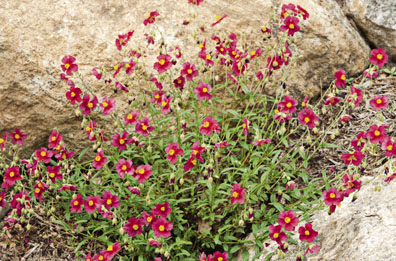
Helianthemum ‘Hartswood Ruby’ adds color to rock gardens
‘St. Mary’s’ bears white flowers with deep green foliage. 8 in. × 24 in.
‘Wisley Pink’, rose-pink flowers with silver foliage.
‘Wisley Primrose’ has soft yellow flowers above gray-green leaves.
Asteraceae
sunflower
The sunflower tribe includes many fine perennials as well as the familiar annuals. All are native to North America, indigenous to a range of habitats including prairies, meadows, roadsides, seaside dunes, and even swamps. Economically the genus is important for the production of sunflower seed oil, birdseed, and Jerusalem artichokes or “sunchokes,” consumed as a starchy vegetable.
Perennial sunflowers are generally imposing and durable plants. They include some of the tallest garden perennials as well as some of the showiest blossoms. As such, they make good backdrops for sunny borders and combine well with taller ornamental grasses, especially Panicum virgatum ‘Heavy Metal’ and purple muhly grass, whose blue or purple-toned foliage complement the yellow flowerheads. For a native plant display, pair sunflowers with big bluestem grass. Purple ironweed, Russian sage, and bluebeard also make good companions. Sunflowers mix easily with other “hot”-colored summer flowers—those with red, orange, or gold flowers. Their lofty, sunset-colored blooms show particularly well when planted on the western side of a garden so that the evening sun backlights the display. The flowers attract butterflies, and the seeds are a welcome food source for songbirds. Mostly resistant to deer browsing; pests and diseases are infrequent.
Propagate by seed or division.
• yellow
• late summer to fall
• 8–10 ft. × 2–4 ft.
• sun
• Z6–9
Swamp sunflower. Native from Texas and Oklahoma, northeastward to New York, and south through Florida. This robust perennial has deep green, lance-shaped leaves, and bears a profusion of 2.5-in.-wide, bright yellow, daisy-like flowerheads with purple-brown centers, from early fall to frost. Prefers a moist soil. This species tends to spread aggressively and is best reserved for meadow or wild gardens. Salt tolerant, and a good choice for sheltered places in seaside gardens.
‘First Light’ forms a 4-ft.-tall, compact clump with bright yellow-orange, 2-in. flowerheads. Less aggressive than the species; a better choice for ornamental borders.
‘Gold Lace’ has deep green, leathery leaves and produces a fountain of golden flowerheads. 5–6 ft.
‘Matanzas Creek’ produces heads of light yellow flowers. 8 ft.
Helianthus debilis
• yellow
• early to late summer
• 18–48 in. × 36–48 in.
• sun
• Z8–11
Beach sunflower, cucumber-leaved sunflower. Native to coastal regions from Texas, east through Florida and northward through North Carolina. Heart-shaped, coarse, rough-textured leaves 2–4 in. long and almost twice as wide. Slightly nodding, 2.5- to 3-in.-wide flowerheads are bright yellow with a red-purple central eye. Blooms repeatedly.
subsp. debilis is prostrate; makes a pretty, drought-tolerant groundcover for seaside gardens and dry spots elsewhere.
subsp. cucumerifolius ‘Italian White’ has sparse, 4-in.-wide, black-centered flowerheads with only ten pale yellow or creamy-white, petal-like rays. 4–5 ft.
Helianthus giganteus
• yellow
• midsummer to midfall
• 7–12 ft. × 2–3 ft.
• sun
• Z5–9
Tall sunflower. Native to the eastern half of North America, north of Florida. Less aggressive than swamp sunflower; requires staking and a site protected from strong winds. Purplish, often hairy stems branch toward the top. Slender, lance-shaped leaves are medium green, toothed along the margins; rather sparse flowerheads have 10 to 20 petal-like rays surrounding a yellow, 1.75- to 3.25-in. central disk. Prefers moist to wet, sandy soils.
‘Sheila’s Sunshine’ produces loose clusters of light, primrose-yellow flowerheads.
Helianthus maximiliani
• yellow
• midfall
• 4–10 ft. × 3–4 ft.
• sun
• Z4–10
Prairie sunflower, Maximilian sunflower. Native to grasslands and meadows throughout the continental United States, except the extreme Southeast and the desert Southwest. Slender, erect stems bear alternate, slender, pointed, lance-shaped leaves folded down the mid-vein, and up to 12 in. long. Flowerheads, arranged in spikes rather than panicles, are 2–4 in. wide, yellow with brown-and-yellow centers, surrounded at their bases by pointed, green bracts which may stick straight out and curl at the tips. Tolerates a wide range of soils; an aggressive spreader best reserved for wildflower and prairie plantings.
Helianthus ×multiflorus
syn. H. annuus × H. decapetalus
• yellow
• summer to late summer
• 4–6 ft. × 2 ft.
• sun, part shade
• Z3–8
Ovate leaves, 8–10 in. long. Bright yellow flowerheads may be single, semi-double, or double, from 3.5–5 in. across. Many hybrids are lumped into this classification. It is wise to buy plants by cultivar name.
‘Flore Pleno’ has double, bright yellow heads of flowers.
‘Capenoch Star’ has large, single, bright yellow heads. 5–6 ft.
‘Loddon Gold’ is double flowered with gold flowerheads.
‘Miss Mellish’ is semi-double. Tends to be invasive.
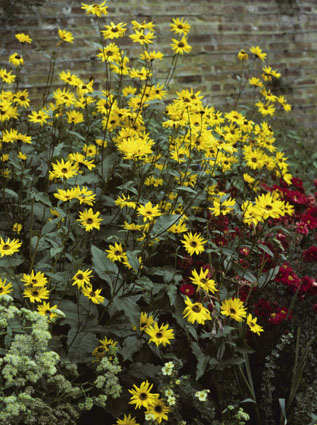
Helianthus ×multiflorus ‘Miss Mellish’
‘Sunshine Daydream’ has rounded, golden, double blooms, almost 2.5 in. across. 5–6 ft. tall.
Helianthus salicifolius
syn. H. orgyalis
• yellow-orange
• late summer to late fall
• 4–6 ft. × 15–24 in.
• sun, part shade
• Z4–9
Willowleaf sunflower. Wisconsin, south and west to Texas, with populations in Ohio, New York, and Marylatnd. The pale green leaves are drooping and willow like, borne on rigid, whitish green stems. The flowerheads, carried in branched panicles, measure 2–2.5 in. across with bright yellow rays and dark brown central disks. Well adapted to any average, medium, well-drained soil in full sun, but also tolerates clays. Spreads by creeping rhizomes to form dense colonies; divide every three to four years to control expansion and maintain vigor. One of the brightest fall bloomers; a good source of cut flowers.
‘Low Down’ is a dwarf cultivar. 12–15 in. × 16–20 in.
Helianthus simulans
• yellow
• early to midfall
• 8–10 ft. × 3–4 ft.
• sun
• Z6–9
Tall narrow-leaved sunflower, muck sunflower. Native to the southern coastal plains from Florida to Louisiana and north into Tennessee and Arkansas. This species is similar to and was formerly considered a form of Helianthus angustifolius; it is however, much more robust. Alternate leaves are hairy, slender, and willow like, with a conspicuous central vein. In fall, branched stems are spangled with a spectacular display of purplish red-centered, bright yellow, 3-in. flowers after most others are spent, even after light frost. Provides nectar for migrating butterflies. Prefers moist soil.
Other Notable Cultivars
‘Lemon Queen’ is one of the best. Pale yellow flowers, 2.5 in. across, are carried on 5- to 7-ft. stems. Can become aggressive, but ideal for wild gardens, meadows, or perhaps along a fence, as well as more formal spots.

Helianthus ‘Lemon Queen’
Asteraceae
everlasting flower
Everlasting flowers are so valuable in summer gardens especially for their soft, silvery gray foliage that contrasts and mixes seamlessly with colorful perennial and annual flowers. This genus of some 500 or so species has been broken up—strawflower (formerly Helichrysum bracteatum) is now in the genus Bracteantha. Many of the remaining species are evergreen woody plants; some are annuals. Those described here are tender in cold regions but are used extensively in temporary summer containers and landscapes.
Branched, white-hairy stems have mostly alternate, often aromatic leaves, also covered with woolly hairs. Flowerheads cluster at the stem tips that become tightly packed with heads resembling mini shaving brushes.
Provide lean to average, very well-drained soil with a neutral or alkaline pH; add lime to acid soils. Prune landscape plants in spring before young growth begins. Powdery mildew and rust may be a problem but are seldom serious. Be alert for caterpillars, especially those of painted lady butterflies. Deer do not care for the odor of helichrysums.
Overwinter in a warm greenhouse in cold zones.
Propagate by soft cuttings taken in summer or start seed in spring.
Helichrysum italicum
syn. H. angustifolium
• foliage
• late spring to summer
• 1–1.5 ft. high and wide
• sun
• Z8–10, HS
Curry plant. Southern Europe. Woody at the base, with slender, erect stems, densely clothed with white-woolly, 1.5-in., linear leaves. When bruised, the leaves and stems emit a strong odor of curry. Small flowerheads with yellow bracts cluster in terminal heads about 1–2 in. across. Grow in dry, very well-drained locations in rock gardens, gravel gardens, and along hot, sunny paths. Not suitable for regions with high summer heat and humidity.
syn. H. petiolatum, Gnaphalium lanatum
• foliage
• summer
• 2–3 ft. × 3–4 ft.
• sun
• Z9–10, HS
Licorice plant. Southern Africa. This evergreen, mounding and trailing subshrub is popular as a hanging basket annual in cold-winter areas; it is fully perennial in warm zones, except where summer humidity is high, which causes the foliage to melt. Branching stems carry oval, heart-shaped, 0.75- to 3-in. leaves, soft and woolly with white hairs, a natural protection against undue water loss through transpiration in hot climates. In summer, semi-circular, cream-bracted flowerheads gather in 1- to 2-in.-wide clusters. Drought tolerant, but will not tolerate wet feet. Mostly ignored by deer. This beautiful gray plant is superb as a foil for brighter-colored perennials and annuals. Correct nomenclature of the selections is somewhat confused.
Increase by semi-hardwood cuttings or soft cuttings with a heel in summer.
‘Limelight’ (‘Aurea’, ‘Gold’) has lime-green leaves. Protect from intense sun.
‘Microphyllum’ (syn. Plecostachys serpyllifolia) sports very finely textured, gray leaves. Conspicuous heads of bright yellow flowerheads. Very drought tolerant; do not plant this close to wild habitats.
‘Minus’ has very small, gray-green leaves. 4 in. ‘Silver Mist’ is reputed to be superior.
‘Variegatum’ has cream-variegated gray foliage.
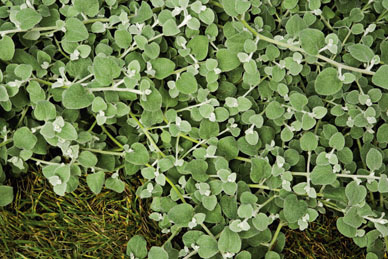
Helichrysum petiolare
Other Notable Cultivars
‘Pink Sapphire’ (syn. Helichrysum ×amorginum ‘Pink Sapphire’) has bright pink flower buds above white, woolly foliage. Provide lean, free-draining soil. Powdery mildew resistant. 8–10 in. Z8–10.
Ruby Cluster (‘Blorub’), a parent of the above, has brilliant cherry-red flower buds above white, woolly leaves. Best in lean soil that drains well. 8–10 in. Z8–10.
‘Schwefellicht’ (‘Sulphur Light’, syn. Anaphalis triplinervis ‘Schwefellicht’), a tried and true selection blanketed with white, woolly hairs. Minute sulfur-yellow flowers cluster in dense, congested, terminal clusters. 1–1.5 ft. Z10–11.
Asteraceae
false sunflower, oxeye
Members of this genus earn their common name with the sunny, brilliant yellow flowers they bear from midsummer well into fall. Although there are several species, only Heliopsis helianthoides is sufficiently well behaved and refined in appearance to include in ornamental gardens. The species is seldom grown, however, and typically it is a selection or cultivar that is nurtured. Native and widespread in the eastern part of North America, Native American tribes brewed the leaves of H. helianthoides into a tea supposed to relieve lung congestion and fever.
In the wild, false sunflowers inhabit rough terrain with poor dry soils or scrubland, but when provided with well-drained, average garden soil in full sun they come into their own. Avoid excess fertilizer; this encourages lush growth that requires staking; indeed, taller selections often need this sort of support even if their soil is kept lean. To control the plants’ height (and minimize the need for support), cut back plants by a half in late spring. Deadhead to extend bloom time.
The flowers attract nectar hunters, including hummingbirds, bees, and butterflies; seed-eating songbirds fill up on the seeds in fall and winter. Seldom browsed by deer. Powdery mildew may defoliate the plants; protect by thinning dense clumps to enhance air movement where possible. Irrigate at ground level during dry weather; do not allow foliage to remain wet overnight.
These stately plants are best grown at the back of mixed beds and borders, in native plant and wild gardens, as well as other informal spots. Fiery daylilies, globe thistles, Russian sage, and Joe-Pye weed are good border companions. Planted among tall ornamental grasses they create a naturalistic vignette. Excellent for cutting, with a long vase life. False sunflowers are useful for controlling soil erosion on difficult banks, and tolerate drought well. To maintain vigor, divide cultivars every two to three years; build stock by dividing established plants. The species and some selections come true from seed and germinate freely indoors at 70°F. False sunflowers self-seed freely.
Heliopsis helianthoides
• yellow
• late summer to early fall
• 3–6 ft. × 4 ft.
• sun
• Z3–9
False sunflower, smooth oxeye, woodland sunflower. Prairies and open woodlands of North America from Ontario to New York, west to Minnesota and to the South. Stiff, branching stems are clothed with pairs of mid-green, 5- to 6-in.-long, ovate to lance-shaped leaves, toothed along the edges. The stems terminate in solitary, yellow, 1- to 3-in., daisy-type flowerheads, similar to those of sunflowers. Pointed ray flowers are arranged in a single ring surrounding a brownish yellow disk. The species is seldom grown outside of native plant gardens, but many cultivars are in the marketplace. Those attributed to subsp. scabra (or Heliopsis scabra) are particularly well suited to garden cultivation. The leaf surfaces of this subspecies are rough like sandpaper.
subsp. scabra ‘Light of Loddon’ has large, double flowerheads. Provide staking for this 4-ft.-tall selection.
Loraine Sunshine (‘Helhan’) is distinguished by its eye-catching irregularly white-variegated, green foliage. Single, yellow daisies. 30–36 in. Z4–9.
‘Prairie Sunset’. Single flowerheads with a reddish disk and a distinct reddish ring at the base of the ray flowers. Striking purple-veined foliage. 3–5 ft.
subsp. scabra ‘Sommersonne’ (‘Summer Sun’) has bright yellow, semi-double flowerheads. Very tough and forgiving. 2–3 ft. Z3–8.
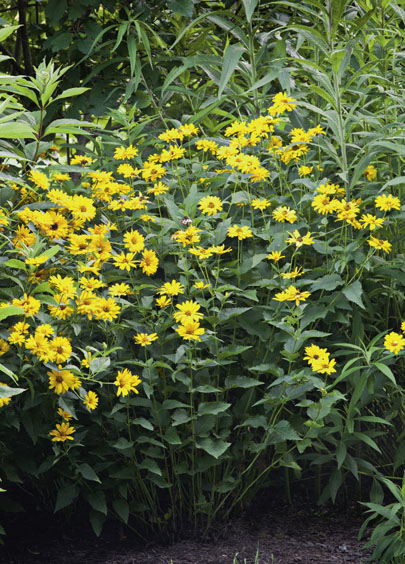
Heliopsis helianthoides subsp. scabra ‘Sommersonne’
‘Tuscan Sun’. Single, yellow heads, 2 in. across, with an orange-gold disk. Excellent for containers. Powdery mildew seldom a problem. 12–18 in.
Boraginaceae
heliotrope
Although this genus is comprised of many species, only the common heliotrope, Heliotropium arborescens, is widely grown. The so-called garden heliotrope, Valeriana officinalis, belongs to a different genus and isn’t a true heliotrope. Traditionally, heliotropes have been a mainstay of cottage and fragrance gardens, though their popularity has fluctuated over time. They were especially prized by Victorian gardeners, who grew them as tall standards with trunk-like, single stems for use as punctuating “dot plants” in the elaborate bedding schemes favored in that era. Careful pinching and pruning gave these standards single stems as much as 5 ft. tall; north of zone 9, such plants were wintered under glass and then restarted into growth and planted out again in late spring.
Today’s gardeners grow heliotropes as hardy perennials in zones 9 to 11, leaving them outdoors year-round to bloom in spring, with a second bloom season in fall. From zone 8 and northward they are generally cultivated as summer annuals. Wherever they are grown, heliotropes enhance beds, borders, and wildlife and fragrance gardens thanks to the strong color and perfume of their flowers. The fragrance is variously described as reminiscent of vanilla, cherry pie, or baby powder. It is strongest in the early morning and late afternoon, and is a resource for the perfume industry.
Heliotropes’ long-blooming flowers make good cut flowers and are included sometimes in pot-pourri. Butterflies, birds, and bees are attracted by the fragrance. All parts of the plants are poisonous to cattle and most mammals; seldom browsed by deer. White flies and rust may become a nuisance, especially indoors in the winter months.
Usually borne alternately, the simple leaves are lance-shaped, 3-in. long, and mid- to dark green (sometimes purplish). Their rough, hairy surface is wrinkled with well-pronounced veins. Tubular flowers, typically deep purple and tiny, cluster into coiled cymes that develop slightly mounded or flat-topped heads, 3–4 in. across.
Full sun is best for heliotropes in regions with low light, but part shade is preferable in regions where sunlight is intense. Soil should be sweet (alkaline), fertile, and well drained, but the plants must remain moist for best results. Mulch in summer to help retain soil moisture; where soil tends to be acid, apply a light dressing of lime.
Start from seed in spring at 70ºF with protection, and plant out after the threat of frost has past. Soft cuttings may be taken and rooted in spring and early summer.
Heliotropium arborescens
syn. H. peruvianum, H. corymbosum
• blue, purple, white
• late spring to midsummer
• 18–24 in. × 15 in.
• sun, part shade
• Z10–11
Garden heliotrope, common heliotrope, cherry pie. Peru. This short-lived perennial is subshrubby and may reach 4–6 ft. tall in the wild. However, young plants are usually grown in cooler climates for use in summer containers, window boxes, and bedding, and the stems seldom become woody. Lift, pot, and overwinter the plants in a sunroom or other protected spot for replanting outdoors the following spring after the danger of frost has past. If you seek strongly fragrant plants, it is probably wise to buy plants in bloom and sniff carefully, as some clones in the marketplace are not as fragrant as others. Old-fashioned varieties are usually the most fragrant.
‘Fragrant Delight’ has very fragrant, soft purple flowers. Purple-tinged leaves. 2–3 ft.
‘Marine’ has large heads of flowers to 6 in. across in deep purple, with a strong fragrance. Foliage is burgundy color. 6–12 in.
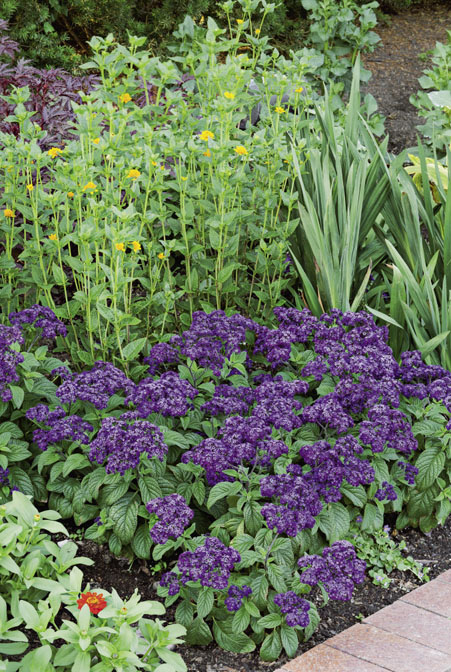
Heliotropium arborescens ‘Marine’
‘Sweet Heaven’ has lavender flowers on 2.5-ft. stems. Strongly fragrant; tolerates summer heat.
‘White’ is possibly the same as ‘White Lady’, mentioned in an 1892 seed catalog. Trusses of almond-scented, white flowers. 1.5–2 ft. tall.
Ranunculaceae
hellebore
“Schneerose” (snow rose) is a German name for hellebores, and it underlines one reason for these plants’ surging popularity: their ability to bloom during adverse seasons when most other perennials are still hiding underground. In fact, it is quite common to find hellebores poking their flowers and foliage up through a carpet of snow. Depending on the species, they may bloom as early as midwinter in mild climates, or in very early spring where winters are harsher. This, however, is far from the only virtue of these plants. They offer beautiful long-lasting flowers and striking evergreen foliage. Though hellebores respond best to a well-watered and well-drained, rich, humus soil, once established on a site they are notably tough, withstanding both drought and neglect, and commonly surviving as last evidences of some abandoned garden. Originally cultivated for their medicinal qualities, hellebores are permeated with toxic compounds that make them notably resistant to grazing by deer and rabbits, though also less than ideal choices for a landscape with young children.
Some 20 species of hellebores inhabit various areas of Europe and Asia. Most are cultivated only by specialist collectors, but just four species, Helleborus argutifolius, H. foetidus, H. niger, and H. orientalis, together with the dozens of fine hybrids derived from them, are sufficient to satisfy the rest of us. Those who are fascinated by hellebores should consult the websites of specialist growers—be aware though, the fancy new selections and cultivars are not inexpensive. Hellebore authority Graham Rice (writing for the Royal Horticultural Society) suggests combining hellebores in the landscape with early-blooming spring bulbs, such as Crocus tommasinianus, Scilla mischtschenkoana, and snowdrops, or setting them against a backdrop of the brilliant red twigs of red stem dogwood. Hellebores also provide a handsome complement, both in foliage and flowers, to such broad-leaved evergreens as hollies and camellias.
Propagation is by seed or division; in either case, the offspring is likely to take at least two to three years to attain flowering size. Hellebores do not tolerate waterlogged soils; be sure to provide them with good drainage. Potential problems include crown rot when grown on wet or poorly drained soils, and leaf spot.
Helleborus argutifolius
syn. H. corsicus, H. lividus subsp. corsicus
• green
• late winter to early spring
• 24–48 in. × 24–36 in.
• sun, part shade
• Z6–9
Corsican hellebore. Corsica and Sardinia. Glossy, evergreen leaves are each composed of three leaflets with strongly serrate margins, light green with tints of blue and pearl. Nodding, bowl-shaped flowers, pale green in color, measure 1–2 in. across, and are borne in profusion above the foliage on stout flower stems. Sensitive to cold, though plants will survive brief dips to 0°F; tolerates a range of soils as long as they drain well.
‘Janet Starnes’ has green-and-cream variegated foliage.
‘Pacific Frost’ has foliage abundantly frosted with an overlay of cream and pale green. A favorite in the damp maritime regions.
‘Silver Lace’ has pewter-silver foliage.
Helleborus foetidus
• greenish white
• late winter to early spring
• 1–2 ft. × 1–1.5 ft.
• part shade, shade
• Z5–9
Bear’s foot hellebore, stinking hellebore, stinking Benjamin. A native of western and central Europe, this species boasts dark green, evergreen leaves that are deeply lobed, divided into seven to ten narrow, lanceolate to elliptical, tooth-edged segments; the overall effect is celebrated by the nickname “bear’s foot.” Clusters of pale green flowerbuds appear early in the New Year; shortly thereafter, nodding, bell-shaped, greenish white flowers tipped with purple, up to 1 in. across, open. When bruised, flowers and foliage release an unpleasant skunk-like odor that is rather exaggerated by the names “foetidus” and “stinking.”
Provide plants with a moisture-retentive, organic-rich, slightly alkaline soil that drains well. Cut back flowering stems after blooming to encourage new growth. Plants may self-seed in favorable habitats. Protect from winter winds—a blanket of evergreen boughs is recommended in zone 5.
‘Gold Bullion’ has bright golden young foliage. Try it with Mukdenia or purple bugleweed.
‘Krenitsky’ (Krenitsky’s bear claw hellebore) has dark green, very serrate leaves; 2-ft.-tall stalks of light green flowers.
‘Piccadilly’ (12–18 in.) and ‘Sienna’ (24 in.) both have blackish green foliage.
Red Silver Strain has leaves with a silvery sheen, with reddish stems and leaf bases; chartreuse flowers, heavily rimmed with red-purple. This is a variable seed strain.
‘Wester Flisk’ has red-stemmed, finely divided foliage, and bell-shaped, light creamy-green flowers rimmed with purple. 2 ft. Z4.

Helleborus foetidus
Helleborus niger
• white, pink
• mid-winter to early spring
• 9–12 in. × 12–18 in.
• part shade, shade
• Z3–8
Christmas rose. Europe and southwest Asia. Leaves are dark green, glossy, composed of seven to nine leaflets, to 8 in. long by 2.5–3 in. across; evergreen in milder climates, but deciduous where winters are severe. The large, bowl- to cup-shaped flowers may reach 3 in. wide, with five tepals (petals) surrounding a boss of yellow stamens. They are borne singly or in threes, on thick stems, white shading to pink as they mature; bloom may begin as early as December where winters are mild, and may persist for two months. This species prefers a humus-rich, well-drained soil, and a spot protected from winter winds. Christmas roses establish slowly, generally taking several years to bloom size; they grow best if left undisturbed. May self-seed where conditions are good.
‘HGC Josef Lemper’ (Josef Lemper Christmas rose) grows to just 9 in. Large, white flowers over a prolonged season. Z3–8.
‘Potter’s Wheel’ has rounded, large, white flowers accented with a green eye. A parent of several hybrids.
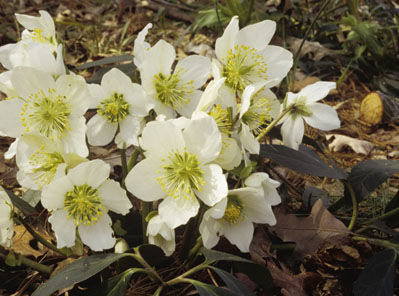
Helleborus niger
Helleborus orientalis
syn. H. ×hybridus
• white, pink, purple
• late winter to midspring
• 12–18 in. × 15–18 in.
• part shade, shade
• Z4–9
Lenten rose. Native from northeastern Greece through Turkey to the Caucasus Mountains. Large leaves are palmate, leathery, glossy green, and 8–16 in. wide, 12 in. or more in length; evergreen where winters are mild. The large flowers are 3–4 in. in diameter, nodding or outfacing and cup shaped, ranging in color from white to pink, light pinkish purple to deep purple-black, with a contrasting boss of yellow stamens. Prefers organic-rich, well-drained soils, with a location protected from winter winds. Faster to establish and easier to grow than Helleborus niger; more tolerant of division. Self-seeds in hospitable sites.

Helleborus orientalis are excellent for massing under trees
Other Notable Cultivars
Hybrids and strains are numerous and growing. This is just a sampling.
×ballardiae (Helleborus lividus × H. niger) ‘Cinnamon Snow’. Bright cinnamon-red stalks support outfacing, white blooms that age to pink in late winter to early spring. 12 in. × 18 in.
Brandywine Strain has a mix of colors, many spotted; single, semi-double, and double flowers. Bred by David Culp.
×ericsmithii ‘HGC Champion’ (‘Winter’s Bliss’). Dark green, prickly edged leaves and rosy buds; outfacing cream flowers with pink reverse. 15 in. × 24 in. Z4–8.
Golden Lotus Strain bears large, double, yellow flowers, often with pink edging and reverse. Z4–8.
Heronswood Double Strain has double flowers in pinks and roses, cream, purple, and lilac.
×nigersmithii ‘Walhelivor’ (Ivory Prince) has burgundy-petioled, silver-veined, glossy green leaves. Reddish buds open to white flowers in midspring. To 10 in. Z5–8.
Royal Heritage Strain, introduced by John Elsley, includes vigorous growers with variously colored flowers with overlapping petals.
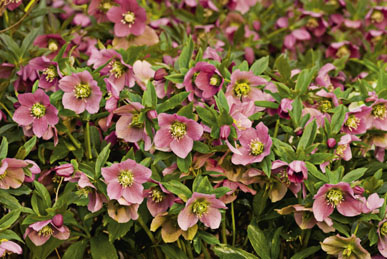
Helleborus Royal Heritage strain
Xanthorrhoeaceae
daylily
This genus epitomizes one of the greatest challenges facing the perennial gardener today: how do you make choices when the menu has become so huge? Currently, there are some 60,000 hybrids registered with the American Hemerocallis Society, and more are added daily.

This bed of Hemerocallis softens the fence and entryway to this residence
Fortunately, it isn’t necessary to review every alternative. Nurserymen divide hybrid daylilies into several classes based on characteristics including the size of the plant and the form, color, and blooming season of the flowers. Becoming familiar with this system enables you to identify which class will suit the aesthetics of any garden spot. Consider the cultural conditions within your garden and weed out all but those groups of hybrids adapted to your region. An abundance of choices will remain, but by applying these two sets of criteria, any selection you make will be successful.
Evergreen daylilies (cultivars that maintain foliage year-round) tend to be the best choices for hot-climate gardens. Dormant daylilies have foliage that dies down in fall prior to winter dormancy and usually are the best choices for cold-climate regions.
Hemerocallis foliage is strap shaped, long, and narrow. Leafless stems (scapes) carry the flowers; they have parts in threes. Hybridizers have added a range of new flower forms to the genus, including many doubles. There are three basic flower size categories: “dwarf” is a compact daylily that produces scapes under 12 in. tall (like ‘Black-Eyed Stella’); “miniature” has flowers 3 in. in diameter or less (as in ‘Peach Fairy’); and “tetraploid” describes daylilies with double the normal number of chromosomes. These tend to be more vigorous than diploids; flowers are usually larger, more intensely colored, and with heavier substance, on sturdier scapes. ‘Chicago Apache’ is an example.

Hemerocallis ‘Chicago Apache’ blooms in midseason
THERE ARE MANY FLOWER TYPES AND FORMS:
Single flowers retain their original, wild type configuration. Popular cultivars include ‘Hyperion’ and ‘Rosy Sunset’.
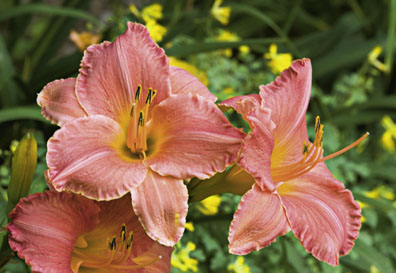
Hemerocallis ‘Rosy Sunset’
Double flowers have modified, petal-like stamens that create the appearance of extra petals. Examples include ‘Siloam Double Classic’and ‘Prester John’.
Circular flowers are rounded in outline with overlapping petals and sepals. Examples include ‘Sir Francis Drake’ and ‘Stella De Oro’.
Triangular flowers have sepals that recurve (curve backward) more than the petals. Examples include ‘Barbara Mitchell’ and ‘Shaka Zulu’.
Star-shaped flowers are closed at the throat; long, sometimes pinched petals, and recurving narrow sepals. Examples include ‘Burgundy Star’ and ‘Cream Giant’.
Spider and spider variants have attenuated petals and sepals, much longer than normal in proportion to their width. Examples include ‘Aabachee’and ‘Tarantula’.
Typically individual flowers don’t last longer than a day, but so many buds are produced that a single plant may bloom for 30 to 40 days.
Early-season daylilies typically bloom in late spring to early summer in the North; midspring in milder regions. Midseason daylies bloom in early to midsummer in the North; mid- to late spring in regions where spring arrives earlier. Late-season bloom is usually four to six weeks after peak season. There are also repeat bloomers (also known as “remontant” and “recurrent”) that produce more than one flush, or bloom several times over the course of a growing season. Brassy golden ‘Stella de Oro’ begins flowering with the early season cultivars and continues blooming almost continuously until fall.
The color range among the hybrids is extraordinary, with hues from pale cream and yellow through gold and orange to red, pink, and purples, even near blacks; only true whites and true blues are lacking. The yellow and oranges are particularly showy when intermixed with blue delphiniums and hydrangeas, for example. White Shasta daisies provide an effective foil to colorful daylily blossoms. Massed or planted in drifts, daylilies shine against an evergreen background.
Average garden soil suits most daylilies, but they will tolerate poor, well-drained soils that retain moisture; drought tolerant when established. A site with full sun to part shade is perfect; with less than six hours of sun, daylilies survive but bloom sparsely. Daylilies have a well-deserved reputation as low-maintenance perennials, but the hybrids vary in vigor; the less vigorous often show greater susceptibility to pests. Remove spent blooms daily to maintain a neat appearance; divide congested clumps every few years to maintain vigor and enhance bloom.
Common pests include aphids, spider mites, and thrips, but they rarely pose a serious threat to healthy plants. Slugs and snails can be a problem. Rabbits are seldom troublesome, but daylilies are at the top of the gourmet menu for deer.
Divide in spring or fall; start your own seeds and see what results.
Hemerocallis citrina
• yellow
• late spring to early summer
• 3–4 ft. × 1.5–2 ft.
• sun, part shade
• Z3–9
Citron daylily. Northeastern China. Thick clumps of arching, narrow leaves to 40 in. long. Fragrant, 6-in., trumpet-shaped flowers are borne on scapes to 45 in.; blooms open at sunset and close the following morning. Tolerates a range of soil types.
• yellow
• midspring
• 18–24 in. × 24 in.
• sun, part shade
• Z3–9
Dumortier’s daylily. Japan, Korea, Manchuria, eastern Siberia. This very early bloomer may flower six to eight weeks earlier than most other daylilies. The leaves are narrowly strap-shaped; 3- to 4.5-in. flowers are lemon yellow, streaked with brown on the back. Delicately fragrant.
Hemerocallis lilioasphodelus
syn. H. flava
• yellow
• midspring to late spring
• 2–3 ft. × 1.5–2 ft.
• sun, part shade
• Z3–10
Lemon daylily. China. Trumpet-shaped, 4-in.-wide, lemon flowers are very fragrant; borne on erect, 3-ft.-tall scapes. One of the earliest to bloom. Similar to Hemerocallis citrina, this species is tough and exceptionally tolerant of poor soils and summer heat and humidity.
Ranunculaceae
liverleaf
Native to deciduous woodlands across eastern North America, Asia, and northern Europe, liverleafs are early to bloom and particularly welcome for that reason. Closely related to anemones, they enjoy similar conditions of humus-rich, well-drained but moist soil in partly shaded sites. Once established, however, liverleaf tolerates dry woodland conditions well. Numerous selections have been introduced into the nursery trade, but unfortunately they are not as yet widely available in North America. There are also some interesting species from eastern Asia, but these, for the most part, aren’t commecially available at this time.
Liverleafs’ leathery leaves appear as or just after the flowers bloom and are composed of three to five lobes, pointed or blunt tipped, depending upon the species. Solitary, bowl- or star-shaped flowers may reach 1 in. or more across, with a single or semi-double ring of showy petal-like sepals and a central boss of stamens. After bloom time, more leaves emerge; the foliage persists through winter.
Historically liverleaf has been valued for their curative properties both in Europe and North America. As early as 1653, English botanist, herbalist, and physician Nicholas Culpeper insisted that “it fortifies the liver exceedingly and makes it impregnable.”
The plants themselves, unfortunately, are not impregnable. Protect young growth from slugs and snails. Some report that deer avoid these pretty plants, but others have had their plants decimated by such visitors. It is suggested that wild populations of hepaticas throughout North American woods have declined as the deer population has exploded, though overcollecting has probably also played a role. When purchasing these plants, inquire how they were produced; “nursery grown” does not mean the same thing as “nursery propagated”; the former label merely means that the plants have spent some time in the nursery and may well have been taken from wild populations originally.
Group in light woodland settings or in clearings, in shaded rock gardens, or plant in troughs or containers where they can be admired close-up. Avoid planting with more aggressive shade lovers, such as hay-scented ferns, that will overrun them. Mulch with composted leaves in fall.
Flowers are self-pollinating and not dependent upon insects or other pollinators. Increase stock by sowing fresh seed as soon as it ripens (it will be green), and protect the containers in a cold frame. Seedlings take several years to reach bloom size. Otherwise divide strong plants in spring, but expect these to be slow to bulk up.
Hepatica acutiloba
syn. H. nobilis var. acuta
• lavender, white
• early spring
• 3–8 in. × 4–6 in.
• part shade
• Z4–9
Sharp-leaved liverleaf. Woods and on wooded hillsides in our northeastern states. Leaves divided into deeply cut lobes that are pointed at their tips and slightly hairy beneath. Solitary, cup-shaped flowers may reach 1 in. across and are quite showy on leafless but hairy stems. This woodland gem is difficult to find in the wild, not only because of it’s scarcity but also because it tends to get lost beneath leaf litter. In gardens, group several plants together for impact; partner with other non-aggressive native spring-blooming woodlanders, including Dutchman’s breeches, Christmas ferns, and wild geraniums.
Hepatica americana
syn. H. nobilis var. obtusa, Anemone americana
• purple, white
• early spring
• 4–6 in. × 12 in.
• part shade
• Z3–8
Round-leaved liverleaf. Nova Scotia west to Minnesota and Missouri, and south to Florida in rich, acid, deciduous, or evergreen woods. This species is similar to the preceding one, except that the three leaf lobes are conspicuously rounded at the ends. Fuzzy stems carry long-lasting flowers in shades of purple through lavender to white and sometimes pink. Typically the leaves, also on fuzzy stems, emerge from the base of the plant a little after bloom time, become deep red in fall, and persist through the winter. Natural hybridization occurs between this and the previous species, sometimes resulting in rare and unusual beauties.
Hepatica nobilis
syn. H. triloba, Anemone hepatica
• white, pink, blue
• early spring
• 4 in. × 6 in.
• part shade
• Z5–8
Common hepatica. Woodlands from the Pyrenees to western Russia. Rounded or kidney-shaped, semi-evergreen leaves are purplish and silky with hairs beneath. Bowl-shaped, 1-in. flowers on hairy stems appear just prior to the emergence of the leaves.
‘Rosea’ has rosy pink flowers.
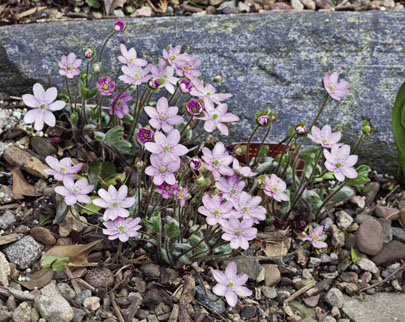
Hepatica nobilis ‘Rosea’
Asparagaceae
hesperaloe
These southwestern natives are similar in appearance to their relatives the yuccas, and are sometimes incorrectly labeled as such. Hesperaloes provide gardeners of their region with desert-adapted, fountain-like clusters of evergreen, stemless, linear, blade-like foliage and bell-shaped flowers borne on tall, graceful spikes. A magnet for hummingbirds and deer resistant, these plants are tough, requiring little irrigation or maintenance. Attractive when massed, their neat, architectural forms make them useful as accents in dry gardens, too. Well-drained soil is essential.
Propagate by seed or by division in wintertime; growth is somewhat slow but hesperaloes are exceptionally durable.
Hesperaloe campanulata
• pink
• summer
• 3 ft. high and wide
• sun
• Z7–10
Bell-flower hesperaloe. Northeastern Mexico. More compact than the popular giant hesperaloe, but otherwise similar in appearance. Stiff, 0.5-in.-wide, lime-green leaves borne in a dense clump; pink, bell-shaped flowers borne on tall stalks in summertime.
Hesperaloe funifera
• white
• midspring to early fall
• 4 ft. high and wide
• sun
• Z6–10
Giant hesperaloe. Chihuahuan Desert, Texas, northeast New Mexico. A wonderful accent for arid-region gardens, this species forms an imposing clump of stiff, broad, lime-green leaves edged with coarse, white fibers. The inflorescence, which can last seven months, is an eye-opening 8- to 12-ft.-tall, branching stalk of creamy-white flowers infused with a pink and green blush. Virtually impervious to heat and drought.
Hesperaloe nocturna
• green-and-lavender
• spring to summer
• 5 ft. × 6 ft.
• part shade, shade
• Z7–10
Night-blooming hesperaloe. Mountains of northwestern Mexico. Forms a dense, 4-ft. rosette of narrow, grass-like leaves that are deeply grooved and have fine white threads along the margins. The inflorescence is striking, a 12-ft. stalk of small, greenish lavender, night-blooming flowers. Water deeply every second week during summer heat.
Hesperaloe parviflora
• red
• early spring to late summer
• 5 ft. × 3 ft.
• sun
• Z5–10
Red yucca. Northeastern Mexico and south Texas. Very popular as a landscape plant in the desert states, and also found in the gardens of coastal Florida. Evergreen, arching, grass-like leaves, borne in neat, dense rosettes, are long, narrow, and longitudinally rolled with curly threads clinging from the margins. Red to pink, bell-shaped flowers are 1.25 in. long, borne on 8-ft.-tall stalks. Exceptionally drought tolerant.
‘Perpa’, marketed as Brakelights, is compact, forming a clump of blue-green foliage 2–3 ft. wide and tall with 3-ft. stalks of bright red flowers. Seems to be sterile—failure to set seed prolongs its blooming season.
‘Yellow’ bears soft yellow flowers. 4 ft. × 3 ft.
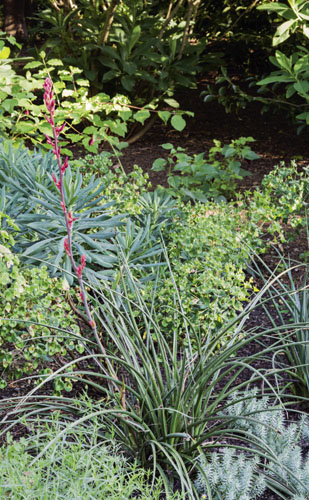
Hesperaloe parviflora
Brassicaceae
dame’s rocket, sweet rocket
Of this genus of 60 or so members, mostly biennial or perennial, only one or two have been deemed garden worthy, notably Hesperis matronalis, commonly known as Dame’s rocket. With purple flowers and petals arranged in the shape of a cross, it is similar to related honesty or silver dollar plant (Lunaria).
• white, purple
• late spring to early summer
• 1–3 ft. × 1.5 ft.
• sun, part shade
• Z4–9
Dame’s violet, rogue’s gilliflower. Central Europe, western and central Asia. This old-fashioned cottage garden gem has collected plenty of common names over the years, testimony to its popularity in various parts of the world. Although not native to the United States, it has naturalized and made itself quite at home in most states. Be aware that it is on invasive plant lists in several states, so check with your local Cooperative Extension before including it in your garden.
Short lived, becoming slightly woody as a perennial, dame’s violet is more often grown as a biennial. Plants are variable, mostly upright with branched stems clothed with dark green, 4- to 8-in.-long, oval or oblong, toothed leaves. Loose clusters of 0.5-in., cruciform, white, purple, or lavender flowers bloom for several weeks, perfuming the evening air. Encourage rebloom and prevent prolific self-seeding by deadheading as soon as blooms fade.
Lovely in natural settings and butterfly and wild gardens, where plants may seed freely. Plant in dooryard gardens close to the house or porch to enjoy the evening fragrance. For evening gardens, select white-flowering cultivars that show up better at dusk. Dame’s violet is also useful along pathways in light shade and among shrubs. Good companions in beds and borders include annual larkspur, bearded iris, and peonies, followed by yarrow, tickseed, and bellflowers. In shadier places, pair with coral bells, columbines, foxgloves, and hostas.
For best results provide well-drained but moisture-retentive soil amended with lime to raise the pH. Deer resistant; pests and diseases are infrequent.
Seed, often in individual colors, is readily available; sow in late May or early June. Propagate double forms by stem or root cuttings.
‘Alba’ (var. albiflora) has pure white flowers and a strong fragrance.
‘Alba Plena’ is a double-flowered, white form.
‘Purpurea Plena’ has double purple or violet flowers.
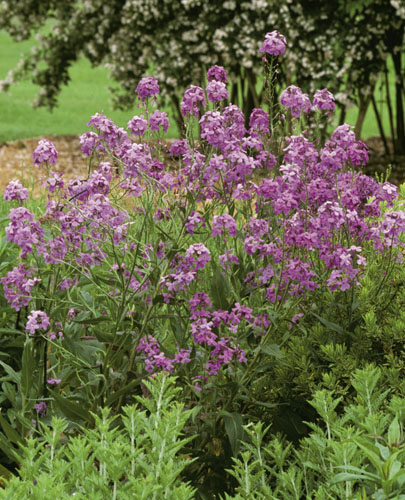
Hesperis matronalis
Saxifragaceae
coral bells, alumroot
For perennial gardeners who want to plant natives but prefer a bit of flamboyance in their gardens, this genus is invaluable. Heuchera’s 35 or more species inhabit a wide range of habitats—woodlands, prairies, and mountain peaks—from the Gulf Coast west to California and north into southern Canada; this diversity enables heucheras to fit into a wide range of garden niches.
Heucheras form rounded mounds of leaves with woody basal rootstocks; roots are shallow and prone to winter heaving. The hairy leaves vary in shape from rounded to palmately lobed and maple-like; over the last generation, a flood of new hybrids with vibrantly colored, even gaudy foliage have appeared on the market. The flowers, which may lack petals, are borne on tall stalks well above the foliage, mostly in late spring and early summer. Although not always as showy as the foliage, the blossoms attract hummingbirds; some make fine cut flowers.
Heucheras prefer partial shade; they’ll survive full sun where light intensity is low, but nothing other than morning sun where it is intense. They prefer a rich, neutral to slightly acid soil; good drainage is a must, especially in shade. Deadhead to prolong bloom.
Heucheras integrate easily into woodland and rock gardens, semi-shaded borders, and container displays. Their evergreen foliage provides an attractive groundcover, especially when intermingled with contrasting, lacy-leaved plants such as ferns or astilbes. Juxtapose colorful-leaved cultivars with contrasting flowers or foliage—a purple-leaved heuchera, for example, alongside a yellow coreopsis or green-and-white-leaved Carex ‘Ice Dance’.
Usually trouble free, heucheras are prone to fungal diseases if grown in damp shade. Also susceptible to black vine weevil and deer, although dark-foliaged selections appear to be browsed less often.
In cold-winter regions, cover with evergreen boughs after the ground is frozen. Start species from seed; propagate hybrids by division. Divide established plants every three to four years to prevent the centers from dying out and to reinvigorate.
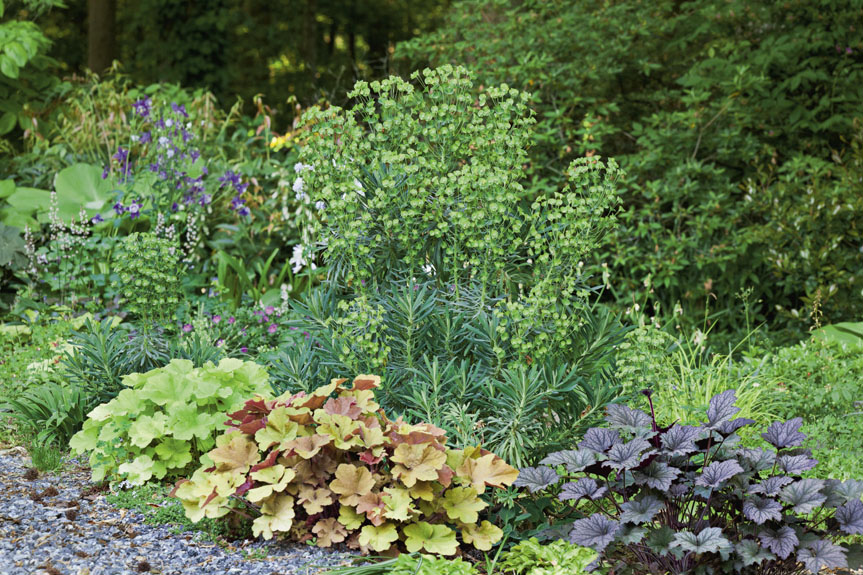
Heuchera ‘Citronelle’, ‘Caramel’, and ‘Viola Frost’ provide a colorful foliage foil for Euphorbia wulfenii
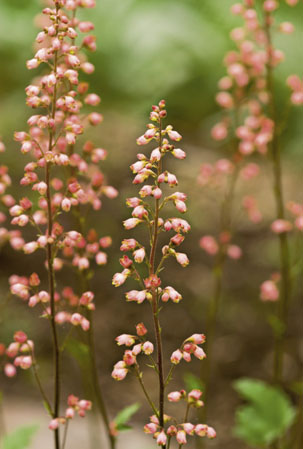
Heuchera ‘Pink Lipstick’ flowers
Heuchera americana
• green, white
• late spring to early summer
• 12–24 in. × 12–18 in.
• sun, part shade
• Z4–9, HS
Coral bells. Rocky, open woodlands and rocky crevices throughout the eastern United States and southeastern Canada. Grown primarily for its 12- to 15-in. mounds of 3- to 5-in. leaves, heart shaped with five to seven lobes, marbled and veined with purplish brown at first, maturing to green. Airy panicles of tiny, bell-shaped flowers, greenish white tinged with red, rise atop tall, wiry stems.
‘Dale’s Strain’ (‘Dale’s Variety’) has silver-blue, marbled foliage accented with white flowers. 30 in. Nancy Goodwin, of the late, lamented Montrose Nursery in North Carolina, crossed ‘Dale’s Strain’ with ‘Palace Purple’ to produce ‘Montrose Ruby’.
‘Garnet’ has bright garnet-colored new foliage that matures to green, veined with bronze. Fall and winter leaves bright garnet, with green margins. 18 in.
‘Pewter Veil’ has copper-pink young leaves that mature to metallic pewter. 22 in.
Heuchera cylindrica
• white
• midspring
• 0.5–3 ft. × 0.5–2 ft.
• sun, part shade
• Z4–8, HS
Roundleaf heuchera. East of the Cascade Mountains to western Montana. Mottled, dark green, slightly hairy leaves range from oval to round, with toothed and scalloped margins. Inflorescence is a tall, dense spike of 0.25-in., bell-shaped flowers, white with pink margins, that bees and butterflies enjoy.
‘Greenfinch’ has short, stiff panicles of green flowers. 30–36 in.
Heuchera micrantha
• white
• midspring to midsummer
• 0.5–2 ft. × 1–2 ft.
• sun, part shade
• Z4–8, HS
Crevice alumroot, small-flowered alumroot. Rocky slopes and cliffs from British Columbia to California. Evergreen, reddish green, 4-in.-wide, heart-shaped leaves with three to seven shallow lobes and toothed margins. Flowering is profuse on well-grown plants, with up to 100 reddish spikes of tiny, creamy-white blossoms. This species is more tolerant of wet soils than others. A parent of many superior selections.
var. diversifolia ‘Palace Purple’, the first purple-leaved selection, was once widely popular but now largely replaced by superior purple-leaved hybrids. 18 in.
Heuchera sanguinea
• pink, red, white
• mid- to late spring
• 12–18 in. × 9–12 in.
• sun, part shade
• Z3–9
Coral bells. New Mexico and Arizona. A parent of so many fine selections, especially those bred for floral characteristics. This species is grown for its many 6-in.-long panicles of larger flowers. Blooms profusely and holds its abundant red blossoms well, even in hot weather; bloom time is long, especially when deadheaded. Evergreen leaves are kidney shaped to round, up to 2 in. wide with scalloped edges.
‘Firefly’ has dark red flowers. 30 in.
‘Frosty’. Dark red flowers tower over the white- to frosty-green leaves. 20 in.
‘Ruby Bells’ has blood-red flowers. 18 in.
‘Splendens’ has bright scarlet flowers. 28 in.
• white, pink
• midsummer to early fall
• 1.5–3 ft. × 1.5–2 ft.
• sun, part shade
• Z4–8
Hairy alumroot. New York to Georgia, west to Missouri and Arkansas. Rounded basal clumps to 2 ft. high and wide of velvety, hairy leaves to 5 in. across, with seven to nine triangular, sharply toothed lobes. Flower stalks are also hairy, rusty brown, to 3 ft., bearing tiny (0.25 in.), white or pinkish blossoms in showy, airy panicles, to 18 in. long. Blooms latest of any species. Prefers a well-drained, organic-rich soil; drought tolerant and more forgiving of summer heat and humidity than other heucheras; best choice for hot, humid gardens. All the following selections (some are hybrids) have Heuchera villosa bloodlines.
‘Autumn Bride’ has light green foliage and white fall flowers. Well adapted to the hot, sticky summers of the Southeast and Midwest. To 36 in.
‘Blackout’ has near black leaves and creamy-white flowers. 18 in.
‘Citronelle’ has chartreuse foliage. Beautiful against winter snow. 2 in.
‘Frosted Violet’ has dark-veined, pink-purple foliage; light pink flowers in late spring. 12 in. Introduced by Charles Oliver, PA.
‘Tiramisu’ has chartreuse leaves tinged with red and overlaid with silver. When nights are cool, leaves turn amber-red edged with chartreuse. 8–10 in. tall.
Other Notable Cultivars
Most of the following are derived mainly from interbreeding Heuchera americana, H. micrantha, and H. sanguinea. These hybrids are sometimes classified as types of H. ×brizoides, but this label is less often applied to newer cultivars whose descent also includes other parents. Leading Heuchera breeders have included the late Alan Bloom of Blooms of Bressingham, Dan Heims of Terra Nova Nurseries, Charles and Martha Oliver of The Primrose Path, PA, and French breeder Tierry Delabroye. The following are hardy in Z4–9.
‘Blackcurrant’ is part of the Dolce series. Its frilly, deep purple leaves have a metallic overlay. 12 in.
‘Caramel’ has glowing apricot young growth that fades to soft amber by summer; white flowers. To 18 in.
‘Electra’ has golden, red-veined leaves; white flowers in late spring. 10 in.
‘Key Lime Pie’ has bright lime-green foliage year-round. Stunning flecked with snow, and great in containers. 10 in. ‘Lime Rickey’ is similar, with slightly ruffled edges. White flowers. 12–18 in.
Little Cuties Series from Terra Nova is comprised of miniature varieties bred for multiple locations. They have great year-round foliage color. ‘Blondie’ has caramel leaves, 5 in. × 8 in. Pink-flowered ‘Peppermint’ is 5 in. × 9 in.
‘Obsidian’. The glossy near-black leaves hold their color well. Insignificant flowers. 10 in.
‘Petite Pearl Fairy’ is a miniature with deep plum leaves no larger than a quarter. Purple stems support airy spikes of pink flowers in spring. An Oliver introduction. 10–14 in. tall.

Heuchera ‘Petite Pearl Fairy’
‘Purple Petticoats’ has well-ruffled, purple foliage, wine colored beneath. 12 in.
Saxifragaceae
foamy bells
Although the nursery industry treats ×Heucherella as a distinct genus of plants, in fact this is actually just a group of artificially derived hybrids, created by crossing heucheras and their close relative, the foamflowers (Tiarella spp.). The hope was that this mixing of genetic material would produce offspring with the colorful foliage of heucheras and the showier flowers of tiarellas.
To some extent, the jury is still out. Charles Oliver, one of the leading breeders of new heucheras, has introduced an ×heucherella—‘Quicksilver’—that has generated widespread enthusiasm and won first prize from Netherland’s Royal Society for Horticulture. Yet Oliver warns that he has found ×heucherellas as a group to lack the adaptability of their parents, as well as their innate vigor. According to Oliver (and others), when grown in less than ideal conditions, especially in regions with hot, humid summers, ×heucherellas may suffer from seasonal dieback, being reduced to small crowns with a dead center by late summer.
Other leading growers and breeders, such as Dan Heims of Terra Nova Nurseries and Tony Avent of Plant Delights, remain enthusiastic. To some degree, the difference in experiences with foamy bells may depend on regional factors such as climate and soil, and gardeners are urged to check with others in their area and their local Cooperative Extension before investing heavily in these plants.
One final note: like many inter-generic hybrids, heucherellas are sterile. Home gardeners must increase stock by division.
×Heucherella
• pink, white
• late spring to midsummer
• 1–1.5 ft. high and wide
• sun, part shade
• Z4–9
Foamy bells. Forms a compact, basal mound, usually 5–8 in. tall, of semi-evergreen, rounded to lobed, maple-like leaves, often with distinctive veining. Tiny, star-shaped flowers are borne in airy to dense panicles on stems rising well above the foliage clump. Foamy bells prefer an organically enriched, well-drained but moderately moist soil with a pH close to neutral. They tolerate full sun in cooler regions, but foliage color is best when the plants are grown in partial shade. Excellent as a groundcover or edging plant, and an attractive addition to shaded borders or woodland plantings. Good companions include other shade-tolerant plants such as lungworts, wild sweet Williams, astilbes, and Solomon’s seals.
‘Alabama Surprise’ has large, golden leaves with sharply contrasting red veining; orange-pink in fall and winter. Small, white flowers. Heat and humidity tolerant. 12 in.
‘Blue Ridge’. Deep red veins decorate the silvery green foliage; white flowers. Tolerates heat and humidity well. 6–8 in.
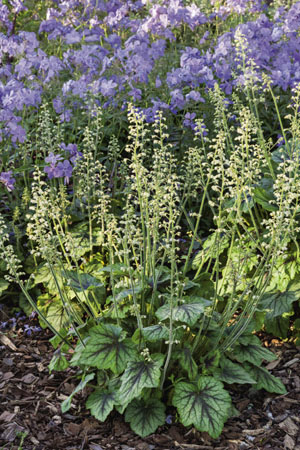
×Heucherella ‘Blue Ridge’ and Phlox stolonifera ‘Blue Ridge’ are compatible partners
‘Heart of Darkness’ has tricolored leaves, dark maroon centers inset into silver-gray and edged with green. Showy white flowers; a Charles Oliver introduction; especially vigorous. 8 in.
‘Kimono’ produces young, deeply divided, crinkled, green leaves with central markings of maroon-purple; replaced in summer with larger, rounder leaves. Copper-rose fall and winter color. Cream flowers. 12 in.
‘Sweet Tea’ has large, maple-like leaves with cinnamon-colored stars at the centers and orange margins; foliage colors darken in summer and lighten again in fall. White flowers. 20 in.
‘Stoplight’ has large, bright yellow leaves with red veining and a dark red blotch at the center. White flowers. 6 in.
Malvaceae
hibiscus
Hibiscus make a splash wherever they are planted. This genus contains small trees and shrubs, perennials, and annuals; here, the focus is on perennial species, all of which bring a strong tropical attitude to the garden.
Unusually large flowered, hibiscus have wide-mouthed, trumpet-shaped flowers borne singly or in clusters in the upper leaf axils. The colors are primarily reds, pinks, and white, sometimes yellow or purple, and most have a conspicuous, contrasting eye. Stamens cluster in a prominent column round the male parts (pistil), a typical characteristic of the mallow family. Foliage is large, alternately arranged on the stems, and mostly palmately lobed or maple-like.
Excellent in damp soils, hibiscus also thrive in average to rich soil in beds and borders. A natural component of waterside gardens, especially in warm parts of the country, they are valuable for rain gardens or native plant and wildlife gardens. Shorter selections work well in containers and planter beds. Good companions include cardinal flower, milkweeds, tall asters, and Indian poke (Veratrum viride). Interesting with ornamental grasses in containers.
Maintenance is low, except for removing the Japanese beetles that may otherwise shred the flowers and leaves. The stems may die back in winter; if so, remove them prior to the appearance of new growth. Staking may be necessary in windy places, but usually the base of the stems becomes woody, making that chore superfluous. Deadhead to avoid unwanted seedlings and to encourage further bloom.
As noted, Japanese beetles are the most serious threat, but mealybugs, scale, and white flies can also become a nuisance. Diseases include stem and root rots, viruses, rust, and fungal leaf spot. Protect from deer.
Increase stock by dividing established plants or by seed. Seeds should be scarified (nicked) or soaked overnight prior to sowing; this allows water to penetrate the seed coat and initiate germination.
Hibiscus coccineus
• red
• summer
• 5–7 ft. × 3 ft.
• sun
• Z7–9
Swamp hibiscus, scarlet rose mallow, red swamp mallow. Coastal swamps of Georgia and Florida. Sparsely clothed with maple-like leaves, tall stems become woody at the base. Bright crimson flowers 3–6 in. across with five spoon-shaped petals, borne singly in upper leaf axils. Each flower lasts just a single day, but is nevertheless eye popping. Effective in damp soils at pond sides, but also in large borders. Seldom damaged by Japanese beetles. Late to break ground in spring.
‘Alba’ has pure white flowers. To 10 ft. Z6–11.
Hibiscus grandiflorus
• pink
• fall
• 6–7 ft. × 6 ft.
• sun
• Z7–9
Velvet mallow. Coastal plains of southern Louisiana to Florida. This bold perennial has huge (to 10 in. across), velvety gray leaves on tall stems, woody at the base. With age, crowns increase to 2 ft. or more across. Fragrant, 7- to 8-in.-wide, soft pink flowers are marked with crimson at the base—these are the largest blossoms of any North American species, and remain open overnight. Moist but average soil; does not tolerate droughty conditions. Seldom attacked by Japanese beetles. Sometimes hybridizes with Hibiscus coccineus where natural ranges overlap.
Hibiscus moscheutos
• white, pink, red
• midsummer to early fall
• 3–5 ft. × 3 ft.
• sun
• Z3–9
Rose mallow, southern rose mallow, swamp rose mallow. Texas to the eastern United States and into Canada, along streams, and beside ponds and lakes. These imposing plants, woody at the base, spread slowly to develop into large colonies that are a sight to behold. Alternate leaves are more or less heart shaped, grayish green above, white and hairy underneath. Large, open flowers accented with crimson at their bases. Brown seed capsules follow. Susceptible to Japanese beetles, although some selections reputedly less than others; deer resistant in some regions, but vulnerable in others. Hummingbird attractor. Very late to emerge in spring. Dramatic in damp places beside water features, but tolerates average garden soil well. Combine with Joe-Pye weed, tall ornamental grasses, and asters at the back of borders.
Other Notable Cultivars
Selections and cultivars abound, with more introduced annually. This is a small selection.
‘Blue River II’ displays pure white, 10-in. flowers on 5-ft.-tall stems; foliage a deep, slightly bluish green. Z5–10.
Disco Belle series includes ‘Disco Belle’, ‘Disco Belle Red’, and ‘Disco Belle White’, all compact with 9-in.-wide flowers. Japanese beetles love these. Seed propagated strain, available in separate colors. 20–24 in.
‘Kopper King’, bred by Nebraska’s Fleming Brothers, has dinner-plate-sized, very pale pink flowers veined and centered with crimson. Copper-colored, maple-like leaves, burnt orange beneath. 3.5–4 ft. Z4–9.
‘Lady Baltimore’ has deep pink, slightly ruffled blooms, with a red eye. 4–6 ft. Z5–9. ‘Lord Baltimore’ has 10-in.-wide flowers like cherry-red dinner plates. 4 ft. Z5–10.
‘Luna Red’ bears bright crimson flowers to 8 in. across. Reputedly deer resistant. 3 ft. ‘Luna Pink Swirl’ has crimson-eyed, pale pink and red flowers. 24–36 in. Z4–9.
‘Peppermint Schnapps’, from the Cordials Collection, has 8- to 10-in., candy pink flowers splashed and centered with red. 4–6 ft. Z5–9.
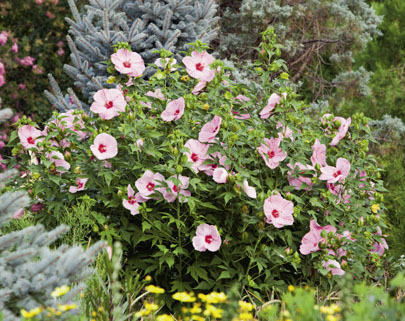
Hibiscus ‘Peppermint Schnapps’